

8 Epic Journeys in Literature

Reading Lists
Micheline aharonian marcom, author of "the new american," recommends quest stories.

The journey story, where the hero must venture out into the world for reasons not necessarily entirely of his/her own devising, is likely as old as recorded literature.
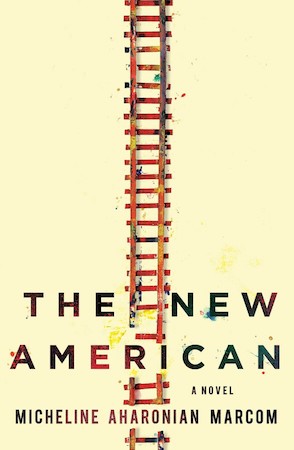
Of course the journey story can also be understood as an allegory of the self, or soul, and its evolution in a lifetime, for storytelling is always an act, as Ann Carson says, “of symbolization.” In this sense, the journey story not only narrates the material events of a life, but also the interior transformations an individual undergoes.
As I wrote my seventh novel, The New American —which takes up the story of a young Guatemalan American college student at UC Berkeley, a DREAMer who is deported to Guatemala and his journey back home to California—I thought a lot about these kinds of archetypal stories in imaginative literature. Here are a few of my favorites.
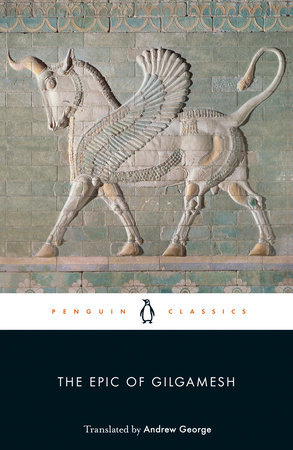
The Epic of Gilgamesh, or He Who Saw Deep translated by Andrew George
The epic poem, one of oldest works of world literature, was composed in its earliest versions over 4,000 years ago in Mesopotamia and written in Babylonian cuneiform on clay tablets. Much of the reason it is lesser known than the younger works of Homer is because the epic itself was not rediscovered until 1853, cuneiform was not deciphered until 1857, and it wasn’t well translated until 1912. Fragments of the story on stone tablets continue to be found in modern-day Turkey, Iraq and Syria.
The basic story follows the King Gilgamesh of Uruk (modern-day Warka, Iraq) and his friendship with the wild man Enkidu. They undergo various battles including fighting and defeating the bull of heaven. Later, upon Enkidu’s death, Gilgamesh journeys to the edge of the earth where he goes in search of the secret of eternal life and, not finding it, returns home to Uruk having in some manner, in spite of life’s sorrows and travails, made peace with his own mortality.
“Ever do we build our households, ever do we make our nests, ever do brothers divide their inheritance, ever do feuds arise in the land. Ever the river has risen and brought us the flood, the mayfly floating on the water. On the face of the sun its countenance gazes, then all of sudden nothing is there!”

The Odyssey by Homer
Written down, along with the Iliad , soon after the invention of the Greek alphabet around the 8 th -century BCE, the epic poem sings of Odysseus’ return home after the Trojan War and his encounters with monsters, the Sirens, shipwrecks, and captivity by Calypso on her island until he finally makes it back to Ithaca. Because the poem survived more or less continuously until modern times and has had influence in so many cultures for millennia (unlike the more recently rediscovered and older Gilgamesh ), there’s no need to reiterate a narrative which so many of us already know, either directly or through the many stories the poem has inspired and influenced. One of my favorite moments comes in Book 14 when Odysseus finally makes it to Ithaca after ten years of traveling and, disguised as a beggar, seeks out Eumaeus the swineherd, who, not recognizing Odysseus, asks “But come…tell me of thine own sorrows, and declare me this truly, that I may know full well. Who art thou among men, and from whence?” These lines have seemed to me to in some way encapsulate some of storytelling’s most basic questions across the ages.
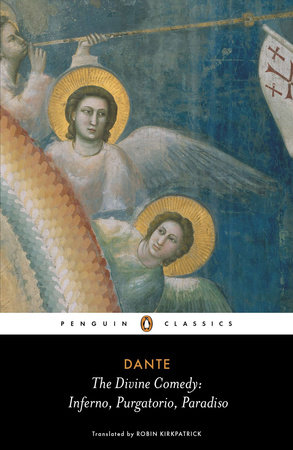
The Divine Comedy by Dante
Written after Dante had been sent into exile from his beloved city of Florence, the Commedia tells of the pilgrim’s descent into hell, his travel through purgatory, and eventually his ascent to paradise, with the Roman poet Virgil as his first guide, and later his beloved, Beatrice. The Commedia —the adjective “divine” in the title wasn’t added for several hundred years—begins with “Nel mezzo del cammin di nostra vita/mi ritrovai per una selva oscura” which can be translated from the Italian to “Midway through the road of our life I found myself in a dark wood.” This is another line from literature that has haunted me for years, not only for the allegorical “dark wood” many of us might at times find ourselves lost in, but at Dante’s strange use of the word “our” even though the Commedia will tell of one pilgrim’s journey and search for the right way. The first person plural points, I think, to the common story of seeking meaning, understanding, and wisdom, and how in the case of this beautiful work, the company of literature with its manner of encoding in the song of language (even if you don’t speak Italian, read a few lines out loud and you can hear the poem’s rhythms) is a blessing in any reader’s life’s journey.
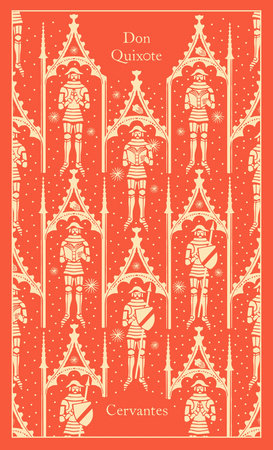
Don Quixote by Miguel de Cervantes Saavedra, translated by John Rutherford
Alfonso Quixano has read too many chivalric romances (popular in 15 th and 16 th -century Europe), has gone mad from his reading, and now confuses reality with fantasy: he imagines himself the knight-errant Don Quixote and he determines to set off in search of adventure. From that premise, we journey through the countryside with our knight errant and his squire, Sancho Panza, as they slay giants (windmills) and defend the honor of his lady-love, Dulcinea del Toboso (a neighboring farm girl), who doesn’t actually ever appear in the story. In addition to being an amusing, laugh-out-loud tour de force of strange encounters as the pair travel across La Mancha, the reality of the violence, ignorance, and venality—not of Don Quixote, but of the society in which he lives in 17 th -century Spain—of corrupted clergy, greedy merchants, deluded scholars, and the like, is on full display. To this day, Don Quixote continues to reveal the joyous role of reading in our lives, how fictions make for all kinds of realities, and how very often it is the fool who sees the truth.
“When life itself seems lunatic, who knows where madness lies? Perhaps to be too practical is madness. To surrender dreams—this may be madness. Too much sanity may be madness—and maddest of all: to see life as it is, and not as it should be!”
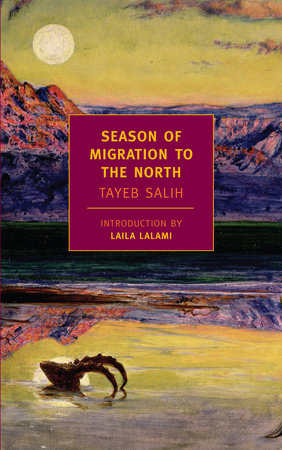
Season of Migration to the North by Tayeb Salih
Tayeb Salih’s mid 20th-century masterpiece is narrated by an unnamed young scholar who returns from England to his village on the Nile after seven years of study abroad and encounters a mysterious newcomer, Mustafa Sa’eed, who also lived for many years in the north. The novel takes up the many complexities and legacies of colonialism in post 1960s Sudan, the difficulties of encroaching modernity, the tragedy of Sa’eed’s life in England, and the intricate web of communal relationships in a traditional village. It is some of the women characters, especially the irreverent and bawdy storyteller, Bint Majzoub, very much like a storyteller out of the Nights , who regales the elder male listeners with bawdy tales, that has stayed in my imagination since I first read the book a decade ago. But it is the style of the book, its formal narrative complexity and interplay, the beauty of its prose, its deep and complex interrogation of the self in the world, that have made it a book I continue to return to. “How strange! How ironic! Just because a man has been created on the Equator some mad people regard him as a slave, others as a god. Where lies the mean?”
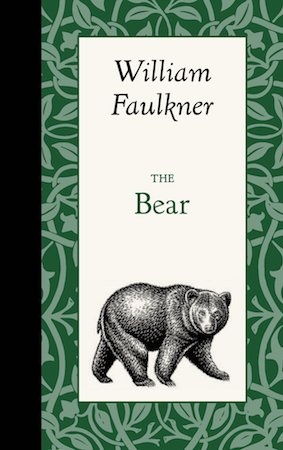
The Bear by William Faulkner
The journey here is into the woods to hunt Old Ben, the last remaining brown bear of his kind and stature in the quickly diminishing woods of Mississippi at the turn of the 19 th -century. As with so much of Faulkner’s work, the writing is sublime, the form strange, the land is a character, and we witness the maw of industrial capitalism as it reduces everything—animals, the land, people—to a ledger of profits and loss. The last scene of the illiterate woodsman, Boon, in a clearing—the land by then has been sold, Old Ben is dead, and loggers will imminently cut the remainder of the old woods down—sitting beneath a lone tree with squirrels running up and down its trunk screaming “They’re mine!” has long haunted me.

Invisible Cities by Italo Calvino
Italian writer Italo Calvino’s fantastical novel is about the imagined conversations between the 13th-century Venetian traveler, Marco Polo, and the Tartar Emperor Kublai Khan of the cities Polo has seen during his travels. The book, however, is mostly made up of descriptions of cities—fantastical forays not into any visible or historical cities, but imaginary invented ones: both ones that might have been and could be, and ones which perhaps did or do exist but are now transformed by the lens of story and distilled to their strange often wondrous essences. Calvino reminds us in this glorious book how the stories we tell greatly shape our thinking, our cultural formations, our views. “You take delight not in a city’s seven or seventy wonders, but in the answer it gives to a question of yours.”
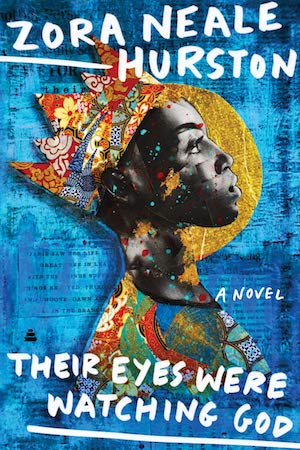
Their Eyes Were Watching God by Zora Neale Hurston
When I think of Hurston I recall her description in her essay “ How It Feels to Be Colored Me ” of the “cosmic Zora” who would emerge at times as she walked down Seventh Avenue, her hat set at a certain angle, who belonged “to no race nor time. I am the eternal feminine with its string of beads.” In Hurston’s extraordinary novel, Their Eyes Were Watching God , the eternal and timeless qualities of imaginative literature are on full display in the very specific groundings of place and time, spoken language and culture. The book opens with Janie Crawford recounting her life story to her friend Pheoby upon her return to the all-Black town of Eatonville, Florida. The book, set in the 1930s, follows Janie’s narration of her early life, her three marriages (the last for love), and the many trials she undergoes including the death of her beloved during her travels, before she finally returns changed, wiser, independent. “You got tuh go there tuh know there…Two things everybody’s got tuh do fuh theyselves. They got tuh go tuh God, and they got tuh find out about livin’ fuh theyselves.”
Take a break from the news
We publish your favorite authors—even the ones you haven't read yet. Get new fiction, essays, and poetry delivered to your inbox.
YOUR INBOX IS LIT
Enjoy strange, diverting work from The Commuter on Mondays, absorbing fiction from Recommended Reading on Wednesdays, and a roundup of our best work of the week on Fridays. Personalize your subscription preferences here.
ARTICLE CONTINUES AFTER ADVERTISEMENT

Carmilla Is Better Than Dracula, And Here’s Why
Forget that dusty undead count—here's the sexy vampire we need right now
Oct 20 - Annabelle Williams Read
More like this.

7 Books in Which Swimming Says Something About Life
In these stories, characters find community, therapy, and liberation in the water
Jul 15 - Katherine Brabon

9 Literary Mysteries With a Big Winter Mood
Stay inside with these cozy atmospheric books set in warm, dusty libraries and grand old houses
Jan 22 - Ceillie Clark-Keane

I Turned My Lover Into a McRib
"The McDonald's Boyfriend," flash fiction by Tom Kelly
Dec 13 - Tom Kelly

DON’T MISS OUT
Sign up for our newsletter to get submission announcements and stay on top of our best work.


Essaying the pop culture that matters since 1999

Lancscape: Free Photos ( Pixabay License / Pixabay )
Short Stories: Journeys
The protagonists in these short stories by Asako Serizawa, Nanjil Nadan, Goli Taraghi, Stephen King, and John Cheever are unsettled, vulnerable, and unmoored during their journeys.

There’s an old saw about how there are only two kinds of plots in fiction: a person goes on a journey or a stranger comes to town. Over the past few decades, this declaration has been attributed to literary legends like Dostoevsky, Tolstoy, et al., without proper citation. The one substantiated reference to it comes from the writer and educator, John Gardner, who suggested the following in a writing exercise in his landmark book The Art of Fiction: Notes on Craft for Young Writers (Alfred A Knopf, 1984):
Write the opening of a novel using the authorial-omniscient voice, making the authorial omniscience clear by going into the thoughts of one or more characters after establishing the voice. As subject, use either a trip or the arrival of a stranger (some disruption of order — the usual novel beginning).
Clearly, he hadn’t said there were only two plot choices. Also, he was discussing the beginning of a story rather than its entire plot. But his point about a trip or journey being a disruption of order in a story holds eternally true. Whether a journey’s intent is a voyage, a quest, a pilgrimage, an exploration, a passage, a tour, or an adventure, the state of limbo between the place we leave and the place we are going to is often filled with many unknowns. Even if we may have covered the same physical distance many times, we are different individuals each time we travel. The latter also applies to those around us, whether headed to the same destination or observing or interacting with us as we pass them by. Given all of this, both real-life and fictional journeys provide plenty of anecdotes, vignettes, and stories.
A lot of our earliest fiction in both the Western and the non-Western traditions has involved journeys. From The Odyssey and The Mahabharata to Don Quixote and Twelve Years a Slave , writers through the ages have used the long physical journey as a literary device to weave together many individual stories and wide-sweeping character arcs.
The most striking aspect of the best travel or journey narratives is that the landscapes described along the way are as important to the stories as the main characters. Key plot points, narrative tension and suspense, and the characters’ internal and external conflicts are all derived from their encounters and interactions with the elements, mode(s) of travel, and the people around them during a journey. The protagonists of such stories always undergo significant metamorphoses because of their new experiences and/or perspectives. Typically, the physical journey is also a metaphor for an inner journey. And, as is often the case in the real world, what matters is the actual act of travel versus the arrival at some destination.
This month’s five short stories — by Asako Serizawa, Nanjil Nadan, Goli Taraghi, Stephen King, and John Cheever — involve journeys through all kinds of places by train, bus, airplane, car, and even foot. The protagonists are unsettled, vulnerable, and unmoored during their journeys. As we readers are transported along, our senses become heightened too.
“Train to Harbin”, by Asako Serizawa ( Literary Hub )
Trains have featured in many short stories throughout the 19th and 20th centuries. Given how cars and airplanes are more common modes of travel these days, we don’t get train stories quite as much anymore. In her famous essay-length response (titled ‘ Mr. Bennett and Mrs. Brown ‘) to Arnold Bennett’s complaints about poor character-building in the novels of their time, Virginia Woolf shared her experience of a woman encountered on the train from Richmond to Waterloo and wrote, “I believe that all novels begin with an old lady in the corner opposite.” She then wrote a brilliant short story about just such an old lady in the corner of a train and not only proved many of the points in her essay but set a new benchmark for train stories in general.
Serizawa’s train story first appeared in The Hudson Review in 2014 and was reprinted in the Pushcart Prize XL (2016 Edition). It was shortlisted for the 2016 O. Henry Prize and was the favorite of one of the jurors, Molly Antopol, who wrote about it here on RandomHouse.com .
There’s a lot happening in “Train to Harbin”, both story-wise and technique-wise. The narrator is an old Japanese doctor. During World War II, when Japan and China were also at war, this doctor had been involved in some secret research involving prisoners of war. In the present time, he’s still trying to make sense of it and cope with the regret and pain of it all. Serizawa paints such word pictures as the doctor goes back and forth through his memories that we cannot help but take the journey with him — both physically and emotionally.
I once met a man on the train to Harbin. He was my age, just past his prime, hair starting to grease and thin in a way one might have thought passably distinguished in another context, in another era, when he might have settled down, reconciled to finishing out his long career predictably. But it was 1939. War had officially broken out between China and Japan, and like all of us on that train, he too had chosen to take the bait, that one last bite before acquiescing to life’s steady decline. You see, for us university doctors, it was a once-in-a-lifetime opportunity. We all knew it. Especially back then.
“Forest”, by Nanjil Nadan ; translated by Gita Subramanian ( The Indian Quarterly )
While the story above involves a planned train excursion to a city, this one is a spur-of-the-moment bus trip through a forest. Nanjil Nadan is the pseudonym of the Tamil writer, G. Subramaniam.
The narrator is having a bit of an existential crisis and takes an aimless walk, then boards a bus going from the state of Tamil Nadu, India into the neighboring state of Kerala. As the vehicle loads up with more people and things, he makes pithy and somewhat caustic observations about the hurrying passengers, the angry driver, the good-looking conductor, the ethnically diverse men working the drink/food stalls at various stops, and the dense forest they pass through.
There isn’t much of a plot here but it’s a well-drawn sketch of a typical everyday scene in rural southern India with all its chaotic and teeming energy. The writer’s main intent is to enable readers to experience the narrator’s world, as it passes him by — spatially, visually, and temporally.
Half the bus got off at Attapadi. Half the goods on the bus were also unloaded. This was the hill country of Kerala. There seemed to be Tamils everywhere—the coolies, the little wayside shopkeepers, in the bakeries, in the supermarkets, all the workers seemed to be Tamilian. Worry lines due to poverty and humiliation were evident on those faces. Just as all South Indians are called “Madrasis” in the north, and all UPites and Biharis (including politicians like Lalu Prasad Yadav) are referred to as “Bhayyas” in Mumbai, all over Kerala, Tamilians are hailed as “Annachi” or “Pandi”. There was no way out; one had to accept the mocking epithet with a grin—even in “God’s own country.”
“The Pomegranate Lady and Her Sons”, by Goli Taraghi ; translated by Karim Emami and Sara Khalili ( Words Without Borders )
Goli Taraghi’s short story collection, The Pomegranate Lady and Her Sons , was one of the Best Books of 2013 at NPR . Arun Rath recommended it as follows:
I have met the pomegranate lady, and you may have as well. If you’ve ever made a disarmingly intimate connection with a stranger while traveling, you’ve had the experience. Connections and dislocations drive the characters in these stories: dislocations of place — exiles who end up in Paris, but never really leave Iran behind, and dislocations of time — elites who preserve a bubble of the “old,” secular, drinking, partying Iran — upon which modern, revolutionary Iran intrudes, with tragic-comedic results. Constantly moving between cultures is not easy on these individuals — but perhaps because of that, it reveals so much raw humanity — both cruelty and compassion.
Words Without Borders has published a handful of stories from this collection, including this title story.
In this excellent 2007 interview at Bookslut , Taraghi talked about publishing and censorship in Iran, living as an expat in France, and her own writing.
In her story, “The Pomegranate Lady and Her Sons”, an educated, worldly woman is traveling from Tehran to Paris and has to help an older, illiterate woman who has never been on a plane before and is going to Sweden to see her fugitive sons. There are all kinds of tragicomic exchanges between the two women, of course. But it’s also a beautiful story within a story of the life of the older woman and we can see why the younger one is drawn, against all her common sense, to try to help her. The ending has a little wrenching twist.
I hate this life of constant wandering, these eternal comings and goings, these middle of the night flights, dragging along my suitcase, going through Customs and the final torture, the humiliating body search. “Take off your shoes, open your handbag, let’s see inside of your pockets, your mouth, your ears, your nostrils, your heart and mind and soul.” I am exhausted. I feel homesick—can you believe it? Already homesick. And yet I want to get away, run, flee. “I will leave and never come back,” I tell myself. “I will stay right here, in my beloved Tehran, with all its good and bad, and I will never leave. Nonsense. I am confused. All I want is to close my eyes and sleep, to slip into that magic land of oblivion and disappear.
“Herman Wouk Is Still Alive”, by Stephen King ( The Atlantic )
This one is a car journey and won the 2011 Bram Stoker Award . True to his form, Stephen King gives us moments of bone-chilling shock and fear here. It’s not a ghost story, but possibly more terrifying. Eleven lives crash together, literally. And the tension ratchets up as only King can ratchet it up. The language is cinematic, immediate, and pulls us in even when we’re cringing about what’s being shown and told. Also, this is one of those stories to read again and again as a masterclass in writing craft. Hard to say more without spoiling all the fun, so we’ll leave it there.
Brenda should be happy. The kids are quiet, the road stretches ahead of her like an airport runway, she’s behind the wheel of a brand-new van. The speedometer reads 70. Nonetheless, that grayness has begun to creep over her again. The van isn’t hers, after all. She’ll have to give it back. A foolish expense, really, because what’s at the far end of this trip, up in Mars Hill? She looks at her old friend. Jasmine is looking back at her. The van, now doing almost a hundred miles an hour, begins to drift. Jasmine gives a small nod. Brenda nods back. Then she pushes down harder with her foot, trying to find the van’s carpeted floor.
“ The Swimmer “, by John Cheever
John Cheever is called the Chekhov of the American suburbs. Known more for his short stories than his novels, he wrote about the duality of things: the conflicts between wealth and happiness, inner persona and outer appearance, cultural/community traditions and modernism, and much more.
“The Swimmer” is frequently anthologized for teaching purposes. It’s about a walk through a familiar neighborhood seen afresh as if for the first time. The main character is a typical Cheever fella: socially active, upper middle class, and with a Mad Men -esque sense of entitlement and privilege that makes him blind to much of what his life is all about.
Neddy Merrill decides to swim through all the pools of his neighborhood on a summer day. Things begin well enough but take a rather dark, surreal turn. The storytelling skill is seen in how various characters interact with Ned in surprising ways and what he realizes about himself and his life as he continues his quest. In many ways, this is Homer’s Odyssey set in 1960s suburbia.
Cheever began this as a novel and, after 150 pages of notes, cut it down to a short story. There’s a movie version with a rather well-toned Burt Lancaster in a pair of swimming trunks through most of it. Picture him this way:
Neddy Merrill sat by the green water, one hand in it, one around a glass of gin. He was a slender man—he seemed to have the especial slenderness of youth—and while he was far from young he had slid down his banister that morning and given the bronze backside of Aphrodite on the hall table a smack, as he jogged toward the smell of coffee in his dining room. He might have been compared to a summer’s day, particularly the last hours of one, and while he lacked a tennis racket or a sail bag the impression was definitely one of youth, sport, and clement weather. He had been swimming and now he was breathing deeply, stertorously as if he could gulp into his lungs the components of that moment, the heat of the sun, the intenseness of his pleasure. It all seemed to flow into his chest.
In the essay “ A Reader’s Guide to Planes, Trains, & Automobiles ” ( The New York Review of Books , 10 Apr 2019) Tim Parks posits that a book is a means of transport (like a train, bus, car, ship, or plane) and a story is a journey.
Both go somewhere. Both offer us a way out of our routine and a chance to make unexpected encounters, see new places, experience new states of mind. […] Then, by mixing with strangers of every class and clime, the traveler is bound to become more aware of himself and of the fragility of identity. How different we are when we speak to different people! How different our lives would be if we opened up to them.
Both physical journeys and book journeys are only satisfying and meaningful when we approach them as more purposeful, mindful endeavors — beyond a change of scenery or relaxation or entertainment or checking off a to-do hotspot/bestseller. Beyond mere tourism, really.
John O’Donohoe’s poem, ‘ For the Traveler ‘, sums it up well, especially, this part:
May you travel in an awakened way, Gathered wisely into your inner ground; That you may not waste the invitations Which wait along the way to transform you
- The Story Prize: Fifteen Years of Great Short Fiction - PopMatters
- Chronicling the Non-Event: Anton Chekhov and the Short Story ...
- Short Stories: Women in Translation - PopMatters
- Short Stories: Women in the Workplace - PopMatters
- The 12 Best Short Collections of 2018 - PopMatters
- Short Stories: Animals, Part II - PopMatters
- 'The Penguin Book of Japanese Short Stories' Is a Perfect Balance ...
- Short Stories: American Writers of South Asian Origin - PopMatters
- Short Stories: Animals, Part I - PopMatters
- Short Stories: Refugees - PopMatters
- Grammar Checker
- Paraphrasing Tool
- Critique Report
- Writing Reports
- Learn Blog Grammar Guide Community Events FAQ
- Grammar Guide
Hero's Journey 101: How to Use the Hero's Journey to Plot Your Story

By Dan Schriever

How many times have you heard this story? A protagonist is suddenly whisked away from their ordinary life and embarks on a grand adventure. Along the way they make new friends, confront perils, and face tests of character. In the end, evil is defeated, and the hero returns home a changed person.
That’s the Hero’s Journey in a nutshell. It probably sounds very familiar—and rightly so: the Hero’s Journey aspires to be the universal story, or monomyth, a narrative pattern deeply ingrained in literature and culture. Whether in books, movies, television, or folklore, chances are you’ve encountered many examples of the Hero’s Journey in the wild.
In this post, we’ll walk through the elements of the Hero’s Journey step by step. We’ll also study an archetypal example from the movie The Matrix (1999). Once you have mastered the beats of this narrative template, you’ll be ready to put your very own spin on it.
Sound good? Then let’s cross the threshold and let the journey begin.
What Is the Hero’s Journey?
The 12 stages of the hero’s journey, writing your own hero’s journey.
The Hero’s Journey is a common story structure for modeling both plot points and character development. A protagonist embarks on an adventure into the unknown. They learn lessons, overcome adversity, defeat evil, and return home transformed.

Joseph Campbell , a scholar of literature, popularized the monomyth in his influential work The Hero With a Thousand Faces (1949). Looking for common patterns in mythological narratives, Campbell described a character arc with 17 total stages, overlaid on a more traditional three-act structure. Not all need be present in every myth or in the same order.
The three stages, or acts, of Campbell’s Hero’s Journey are as follows:
1. Departure. The hero leaves the ordinary world behind.
2. Initiation. The hero ventures into the unknown ("the Special World") and overcomes various obstacles and challenges.
3. Return. The hero returns in triumph to the familiar world.
Hollywood has embraced Campbell’s structure, most famously in George Lucas’s Star Wars movies. There are countless examples in books, music, and video games, from fantasy epics and Disney films to sports movies.
In The Writer’s Journey: Mythic Structure for Writers (1992), screenwriter Christopher Vogler adapted Campbell’s three phases into the "12 Stages of the Hero’s Journey." This is the version we’ll analyze in the next section.

For writers, the purpose of the Hero’s Journey is to act as a template and guide. It’s not a rigid formula that your plot must follow beat by beat. Indeed, there are good reasons to deviate—not least of which is that this structure has become so ubiquitous.
Still, it’s helpful to master the rules before deciding when and how to break them. The 12 steps of the Hero's Journey are as follows :
- The Ordinary World
- The Call of Adventure
- Refusal of the Call
- Meeting the Mentor
- Crossing the First Threshold
- Tests, Allies, and Enemies
- Approach to the Inmost Cave
- Reward (Seizing the Sword)
- The Road Back
- Resurrection
- Return with the Elixir
Let’s take a look at each stage in more detail. To show you how the Hero’s Journey works in practice, we’ll also consider an example from the movie The Matrix (1999). After all, what blog has not been improved by a little Keanu Reeves?

#1: The Ordinary World
This is where we meet our hero, although the journey has not yet begun: first, we need to establish the status quo by showing the hero living their ordinary, mundane life.
It’s important to lay the groundwork in this opening stage, before the journey begins. It lets readers identify with the hero as just a regular person, “normal” like the rest of us. Yes, there may be a big problem somewhere out there, but the hero at this stage has very limited awareness of it.
The Ordinary World in The Matrix :
We are introduced to Thomas A. Anderson, aka Neo, programmer by day, hacker by night. While Neo runs a side operation selling illicit software, Thomas Anderson lives the most mundane life imaginable: he works at his cubicle, pays his taxes, and helps the landlady carry out her garbage.
#2: The Call to Adventure
The journey proper begins with a call to adventure—something that disrupts the hero’s ordinary life and confronts them with a problem or challenge they can’t ignore. This can take many different forms.
While readers may already understand the stakes, the hero is realizing them for the first time. They must make a choice: will they shrink from the call, or rise to the challenge?
The Call to Adventure in The Matrix :
A mysterious message arrives in Neo’s computer, warning him that things are not as they seem. He is urged to “follow the white rabbit.” At a nightclub, he meets Trinity, who tells him to seek Morpheus.
#3: Refusal of the Call
Oops! The hero chooses option A and attempts to refuse the call to adventure. This could be for any number of reasons: fear, disbelief, a sense of inadequacy, or plain unwillingness to make the sacrifices that are required.
A little reluctance here is understandable. If you were asked to trade the comforts of home for a life-and-death journey fraught with peril, wouldn’t you give pause?
Refusal of the Call in The Matrix :
Agents arrive at Neo’s office to arrest him. Morpheus urges Neo to escape by climbing out a skyscraper window. “I can’t do this… This is crazy!” Neo protests as he backs off the ledge.

#4: Meeting the Mentor
Okay, so the hero got cold feet. Nothing a little pep talk can’t fix! The mentor figure appears at this point to give the hero some much needed counsel, coaching, and perhaps a kick out the door.
After all, the hero is very inexperienced at this point. They’re going to need help to avoid disaster or, worse, death. The mentor’s role is to overcome the hero’s reluctance and prepare them for what lies ahead.
Meeting the Mentor in The Matrix :
Neo meets with Morpheus, who reveals a terrifying truth: that the ordinary world as we know it is a computer simulation designed to enslave humanity to machines.
#5: Crossing the First Threshold
At this juncture, the hero is ready to leave their ordinary world for the first time. With the mentor’s help, they are committed to the journey and ready to step across the threshold into the special world . This marks the end of the departure act and the beginning of the adventure in earnest.
This may seem inevitable, but for the hero it represents an important choice. Once the threshold is crossed, there’s no going back. Bilbo Baggins put it nicely: “It’s a dangerous business, Frodo, going out your door. You step onto the road, and if you don't keep your feet, there's no knowing where you might be swept off to.”
Crossing the First Threshold in The Matrix :
Neo is offered a stark choice: take the blue pill and return to his ordinary life none the wiser, or take the red pill and “see how deep the rabbit hole goes.” Neo takes the red pill and is extracted from the Matrix, entering the real world .
#6: Tests, Allies, and Enemies
Now we are getting into the meat of the adventure. The hero steps into the special world and must learn the new rules of an unfamiliar setting while navigating trials, tribulations, and tests of will. New characters are often introduced here, and the hero must navigate their relationships with them. Will they be friend, foe, or something in between?
Broadly speaking, this is a time of experimentation and growth. It is also one of the longest stages of the journey, as the hero learns the lay of the land and defines their relationship to other characters.
Wondering how to create captivating characters? Read our guide , which explains how to shape characters that readers will love—or hate.
Tests, Allies, and Enemies in The Matrix :
Neo is introduced to the vagabond crew of the Nebuchadnezzar . Morpheus informs Neo that he is The One , a savior destined to liberate humanity. He learns jiu jitsu and other useful skills.
#7: Approach to the Inmost Cave

Time to get a little metaphorical. The inmost cave isn’t a physical cave, but rather a place of great danger—indeed, the most dangerous place in the special world . It could be a villain’s lair, an impending battle, or even a mental barrier. No spelunking required.
Broadly speaking, the approach is marked by a setback in the quest. It becomes a lesson in persistence, where the hero must reckon with failure, change their mindset, or try new ideas.
Note that the hero hasn’t entered the cave just yet. This stage is about the approach itself, which the hero must navigate to get closer to their ultimate goal. The stakes are rising, and failure is no longer an option.
Approach to the Inmost Cave in The Matrix :
Neo pays a visit to The Oracle. She challenges Neo to “know thyself”—does he believe, deep down, that he is The One ? Or does he fear that he is “just another guy”? She warns him that the fate of humanity hangs in the balance.
#8: The Ordeal
The ordeal marks the hero’s greatest test thus far. This is a dark time for them: indeed, Campbell refers to it as the “belly of the whale.” The hero experiences a major hurdle or obstacle, which causes them to hit rock bottom.
This is a pivotal moment in the story, the main event of the second act. It is time for the hero to come face to face with their greatest fear. It will take all their skills to survive this life-or-death crisis. Should they succeed, they will emerge from the ordeal transformed.
Keep in mind: the story isn’t over yet! Rather, the ordeal is the moment when the protagonist overcomes their weaknesses and truly steps into the title of hero .
The Ordeal in The Matrix :
When Cipher betrays the crew to the agents, Morpheus sacrifices himself to protect Neo. In turn, Neo makes his own choice: to risk his life in a daring rescue attempt.
#9: Reward (Seizing the Sword)
The ordeal was a major level-up moment for the hero. Now that it's been overcome, the hero can reap the reward of success. This reward could be an object, a skill, or knowledge—whatever it is that the hero has been struggling toward. At last, the sword is within their grasp.
From this moment on, the hero is a changed person. They are now equipped for the final conflict, even if they don’t fully realize it yet.
Reward (Seizing the Sword) in The Matrix :
Neo’s reward is helpfully narrated by Morpheus during the rescue effort: “He is beginning to believe.” Neo has gained confidence that he can fight the machines, and he won’t back down from his destiny.

#10: The Road Back
We’re now at the beginning of act three, the return . With the reward in hand, it’s time to exit the inmost cave and head home. But the story isn’t over yet.
In this stage, the hero reckons with the consequences of act two. The ordeal was a success, but things have changed now. Perhaps the dragon, robbed of his treasure, sets off for revenge. Perhaps there are more enemies to fight. Whatever the obstacle, the hero must face them before their journey is complete.
The Road Back in The Matrix :
The rescue of Morpheus has enraged Agent Smith, who intercepts Neo before he can return to the Nebuchadnezzar . The two foes battle in a subway station, where Neo’s skills are pushed to their limit.
#11: Resurrection
Now comes the true climax of the story. This is the hero’s final test, when everything is at stake: the battle for the soul of Gotham, the final chance for evil to triumph. The hero is also at the peak of their powers. A happy ending is within sight, should they succeed.
Vogler calls the resurrection stage the hero’s “final exam.” They must draw on everything they have learned and prove again that they have really internalized the lessons of the ordeal . Near-death escapes are not uncommon here, or even literal deaths and resurrections.
Resurrection in The Matrix :
Despite fighting valiantly, Neo is defeated by Agent Smith and killed. But with Trinity’s help, he is resurrected, activating his full powers as The One . Isn’t it wonderful how literal The Matrix can be?
#12: Return with the Elixir
Hooray! Evil has been defeated and the hero is transformed. It’s time for the protagonist to return home in triumph, and share their hard-won prize with the ordinary world . This prize is the elixir —the object, skill, or insight that was the hero’s true reward for their journey and transformation.
Return with the Elixir in The Matrix :
Neo has defeated the agents and embraced his destiny. He returns to the simulated world of the Matrix, this time armed with god-like powers and a resolve to open humanity’s eyes to the truth.

If you’re writing your own adventure, you may be wondering: should I follow the Hero’s Journey structure?
The good news is, it’s totally up to you. Joseph Campbell conceived of the monomyth as a way to understand universal story structure, but there are many ways to outline a novel. Feel free to play around within its confines, adapt it across different media, and disrupt reader expectations. It’s like Morpheus says: “Some of these rules can be bent. Others can be broken.”
Think of the Hero’s Journey as a tool. If you’re not sure where your story should go next, it can help to refer back to the basics. From there, you’re free to choose your own adventure.
Are you prepared to write your novel? Download this free book now:

The Novel-Writing Training Plan
So you are ready to write your novel. excellent. but are you prepared the last thing you want when you sit down to write your first draft is to lose momentum., this guide helps you work out your narrative arc, plan out your key plot points, flesh out your characters, and begin to build your world..

Be confident about grammar
Check every email, essay, or story for grammar mistakes. Fix them before you press send.
Dan Schriever
Dan holds a PhD from Yale University and CEO of FaithlessMTG
Get started with ProWritingAid
Drop us a line or let's stay in touch via :
The Hero’s Journey: 12 Steps That Make Up the Universal Structure of Great Stories
by David Safford | 0 comments
Start Your Story TODAY! We’re teaching a new LIVE workshop this week to help you start your next book. Learn more and sign up here.
At some in your writer's life, you've probably come across the term Hero's Journey. Maybe you've even studied this guide for storytelling and applied it to your own books—and yet, something about your own application felt off. You wanted to learn more, but didn't know where to start.
Maybe you needed a resource that would simplify the hero's journey steps and all the other major details instead of complicate them.

The Hero's Journey is as old as humanity itself. And through history, this single story form has emerged over and over again. People from all cultures have seemed to favor its structure, and its familiar types of characters (archetypal hero, anyone?), symbols, relationships, and steps.
If you want to build or strengthen your writing career and win a following of many happy readers, you want this particular tool in your writer's toolbox.
Let's dive in.
Need help applying The Hero's Journey to your story outline and manuscript? Download this free Hero's Journey worksheet now!
Why I Love the Hero's Journey (And You Will, Too)
Like many, I grew up loving Star Wars. I especially loved the music and bought the soundtracks at some point in middle school. When my parents weren't home and I had the house all to myself, I'd slip one of the CDs into my stereo, crank the volume up, and blast the London Symphony Orchestra. I even pretended I was conducting the violins and timpani myself.
I know it's nerdy to admit. But we love what we love, and I love the music of great movies.
In a way, the Hero's Journey is like a soundtrack. It follows familiar beats and obeys age-old principles of human emotion. We can't necessarily explain why a piece of music is so beautiful, but we can explain what it does and simply acknowledge that most people like it.
As I've come to understand Joseph Campbell's groundbreaking monomyth theory, commonly known as the Hero's Journey, I've fallen deeper and deeper in love with it.
But it's important to make sure you know what it is, and what it isn't.
The Hero's Journey isn't a formula to simply follow, plugging in hackneyed characters into cliched situations.
It's not “selling out” and giving up your artistic integrity
The Hero's Journey is a set of steps, scenes, character types, symbols, and themes that tend to recur in stories regardless of culture or time period. Within these archetypes are nearly infinite variations and unique perspectives that are impacted by culture and period, reflecting wonderful traits of the authors and audiences.
Also, the Hero's Journey is a process that your reader expects your story to follow, whether they know it or not. This archetype is hard-wired into our D.N.A. Let's look at how to use it to make your own stories stronger.
How to Use This Hero's Journey Post
In the beginning, there were stories. These stories were told by mothers, soldiers, and performers. They were inscribed on the walls of caves, into tablets of stone, and on the first sheets of papyrus.
This is how the Hero's Journey was born.
In this post, I'll walk you through the Hero's Journey twelve steps, and teach you how to apply them into your story. I'll also share additional resources to teach you some other Hero's Journey essentials, like character archetypes, symbols, and themes. By the end of this post, you'll be able to easily apply the Hero's Journey to your story with confidence.
And don't skip out on the practice exercise at the end of the post! This will help you start to carve out the Hero's Journey for your story with a practical fifteen minute exercise—the best way to really retain how the Hero's Journey works is to apply it.
Table of Contents: The Hero's Journey Guide
What is the Hero's Journey?
Why the Hero's Journey will make you a better writer
The Twelve-Step Hero's Journey Structure
- The Ordinary World
- The Call to Adventure
- The Refusal of the Call
- Meeting the Mentor
- Crossing the Threshold
- Trials, Allies, and Enemies
- The Approach
- The Road Back
- The Resurrection
- Return With the Elixir
5 Essential Hero's Journey Scenes
A Guide to Structuring Your Hero's Journey
Bonus! Additional Hero's Journey Resources
- 5 Character Archetypes
- 5 Hero's Journey Symbols
- 5 Hero's Journey Themes
What Is the Hero's Journey?
The Hero's Journey is the timeless combination of characters, events, symbols, and relationships frequently structured as a sequence of twelve steps. It is a storytelling structure that anyone can study and utilize to tell a story that readers will love.
First identified and defined by Joseph Campbell, the Hero's Journey was theorizied in The Hero With a Thousand Faces . Today, it has been researched and taught by great minds, some including Carl Jung and Christopher Vogler (author of The Writer's Journey: Mythic Structure for Writers ).
This research has given us lengthy and helpful lists of archetypes , or story elements that tend to recur in stories from any culture at any time.
And while some archetypes are unique to a genre, they are still consistent within those genres. For example, a horror story from Japan will still contain many of the same archetypes as a horror story from Ireland. There will certainly be notable differences in how these archetypes are depicted, but the tropes will still appear.
That's the power of the Hero's Journey. It is the skeleton key of storytelling that you can use to unlock the solution to almost any writing problem you are confronted with.
Why the Monomyth Will Make You a Better Writer
The Hero's Journey is the single most powerful tool at your disposal as a writer.
But it isn't a “rule,” so to speak. It's also not a to-do list.
If anything, the Hero's Journey is diagnostic, not prescriptive. In other words, it describes a story that works, but doesn't necessarily tell you what to do.
But the reason you should use the Hero's Journey isn't because it's a great trick or tool. You should use the Hero's Journey because it is based on thousands of years of human storytelling.
It provides a way to connect with readers from all different walks of life.
This is why stories about fantastical creatures from imaginary worlds can forge deep emotional connections with audiences. Hollywood knows this, and its best studios take advantage. As an example, The Lord of the Rings, by J. R. R. Tolkien, contains mythical creatures like elves and hobbits. Yet it is Frodo's heroic journey of sacrifice and courage that draws us to him like a magnet.
Learn how to easily apply the Hero's Journey 12 Steps to your books in this post. Tweet this
David Safford
You deserve a great book. That's why David Safford writes adventure stories that you won't be able to put down. Read his latest story at his website. David is a Language Arts teacher, novelist, blogger, hiker, Legend of Zelda fanatic, puzzle-doer, husband, and father of two awesome children.
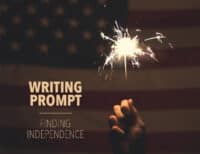
Submit a Comment Cancel reply
Your email address will not be published. Required fields are marked *
Submit Comment
Join over 450,000 readers who are saying YES to practice. You’ll also get a free copy of our eBook 14 Prompts :
Popular Resources
Best Resources for Writers Book Writing Tips & Guides Creativity & Inspiration Tips Writing Prompts Grammar & Vocab Resources Best Book Writing Software ProWritingAid Review Writing Teacher Resources Publisher Rocket Review Scrivener Review Gifts for Writers
Books By Our Writers

You've got it! Just us where to send your guide.
Enter your email to get our free 10-step guide to becoming a writer.
You've got it! Just us where to send your book.
Enter your first name and email to get our free book, 14 Prompts.
Want to Get Published?
Enter your email to get our free interactive checklist to writing and publishing a book.
Best Short Stories for Teaching the Hero’s Journey

Looking to shake up your approach to teaching the Hero’s Journey? Whether you’re looking to replace a novel with a range of short stories or to use them as additional texts, this post reveals 8 short stories that will get the job done.
Gearing up to teach the Hero’s Journey? Before you grab your go-to book from the shelf, I urge you to consider an alternative approach—using short stories.
While there are plenty of great novels out there to emphasize the Hero’s Journey, it was always a challenge to choose just one. Did I want to go with a popular classic, like The Odyssey ? Or an engaging modern text, like The Hunger Games ? That very challenge is what first got me thinking—What if my students could dive into multiple examples of the Hero’s Journey? Besides, heroes come in all shapes and sizes, right? So, in an attempt to expose my students to a classic narrative archetype and a variety of texts, I turned to short stories. And, honestly, I haven’t turned back since.
Whether you’re looking for short stories to take center stage or serve as a stepping stone before jumping into a full-length novel, they make the perfect addition to a Hero’s Journey unit. Keep reading to learn the advantages of teaching the Hero’s Journey using short stories and 8 short story titles that are sure to enhance your lessons.
What Is the Hero’s Journey?
Whether this is your first time teaching the Hero’s Journey or you need a quick review, let’s go over the basics. The Hero’s Journey is a narrative framework coined by Joseph Campbell in his book called The Hero With A Thousand Faces , published in 1949. However, the concept and pattern of the journey have been around since the earliest days of storytelling. It outlines the transformative journey of a protagonist who overcomes obstacles, faces inner and outer challenges, and emerges with newfound strength and wisdom.
While variations certainly exist across different narratives, cultures, and uses, the classic phases of the Hero’s Journey include the following:
- The Ordinary World: An introduction to the protagonist’s everyday life, relationships, and any challenges or limitations they face are first introduced.
- The Call to Adventure: The protagonist receives a compelling invitation or challenge that initiates the on the heroic journey.
- Refusal of the Call: The protagonist resists the call to adventure due to fear, doubt, or a sense of inadequacy.
- Meeting the Mentor: The protagonist encounters a mentor figure who provides guidance, advice, and assistance needed for the journey.
- Crossing the Threshold: The protagonist leaves the familiar and ordinary world behind and enters the unknown.
- Tests, Allies, and Enemies: The protagonist encounters various obstacles,enemies, and allies that test their will, determination and character.
- Approach to the Inmost Cave: The protagonist prepares for a significant challenge or confrontation, symbolizing their innermost fears, doubts, or weaknesses.
- Ordeal: The protagonist is pushed to their limits when faced with their greatest challenge, undergoing a transformative experience.
- Reward: After overcoming the ordeal, the protagonist is rewarded with something, often knowledge, that empowers them to continue their journey.
- The Road Back: The protagonist begins a journey back to the ordinary world.
- Resurrection: They face a final challenge, where they must apply everything they have learned and experienced.
- Return with the Elixir: The protagonist returns and is reunited with the ordinary world, having been transformed by “the elixir”—an object, knowledge, or insight—for the greater good.
Why Teach the Hero’s Journey with Short Stories?
You can apply the Hero’s Journey to a wide variety of literary texts, including myths, fairy tales, novels, short stories, and plays. Heck, you can even track the Hero’s Journey in movies, too. No matter which avenue you use, the Hero’s Journey encourages students to analyze plot structure, character motivation and development, and universal themes.
It gets them shrinking about essential questions like, are heroes born or are they made? What defines a hero? How can an individual change through taking heroic action? What can we learn about ourselves through studying a protagonist’s Hero’s Journey?
While many teachers opt for teaching the Hero’s Journey through a novel, here’s why I love using short stories to do so:
- Concise Storytelling: Short stories allow students to explore the Hero’s Journey in a concise format. This brevity allows for you to utilize short stories in various ways. Have students explore multiple examples of the Hero’s Journey, comparing and contrasting the variations. Alternatively, you can use a short story as Hero’s Journey review or as an introductory experience before diving into a full-length novel.
- Engaging Narratives: Given the waning attention spans of today’s students, it can be challenging to keep them engaged and on track with a longer text. On the other hand, short stories captivate students with their fast-paced narratives and intriguing characters. Short stories can make it through a 12-phase Hero’s Journey in a matter of pages. They often pack a punch with their themes and conflicts, giving students plenty to work with.
- Diverse Perspectives: Heroes come from different places and backgrounds, and possess various strengths and skills. It’s not a one-size-fits-all thing. Therefore, short stories allow you to expose your students to a range of protagonists and the different journeys they take. In fact, students can analyze multiple heroes in the same amount of time it would take to read an entire novel. In turn, you expose students to different voices, perspectives, and cultural experiences, fostering empathy and understanding in addition to highlighting the Hero’s Journey. Talk about two birds with one stone!
- Accessibility and Differentiation: Short stories are a great way to make literature accessible for students of varying abilities and interests. Teaching the Hero’s Journey through these shorter narratives is a great way to set students up for success by assigning a text based on their reading and comprehension level. And, if you ask me, it’s far easier for teachers to manage various short stories than multiple novels.
8 Short Stories for Teaching the Hero’s Journey
If you’ve made it this far down in the post, I’ve convinced you to at least consider using short stories when teaching the Hero’s Journey. (You won’t regret it.) But, let’s take it one step further, shall we? Instead of starting from the drawing board, here are 8 short stories that are perfect for teaching the Hero’s Journey in secondary ELA.
1. “A Sound of Thunder” by Ray Bradbury
Would it be a great short story list without at least one Bradbury title? “A Sound of Thunder” may not follow every stage of the Hero’s Journey in a traditional sense, but the protagonist, Eckels, certainly experiences his own form of the journey. Bradbury’s story incorporates elements of the hero’s transformation, the challenges faced, and the revelation of the consequences of their actions as Eckles ultimately learns the hard truth that even the smallest actions can have big consequences.

2. “The Secret Life of Walter Mitty” by James Thurber
This is another short story that doesn’t completely follow the journey in the most traditional sense. However, students will enjoy tracking protagonist Walter Mitty’s own form of his Hero’s Journey. Walter Mitty’s journey involves vivid daydreams that serve as an escape from his mundane reality. Students can track the stages of the Hero’s Journey as Mr. Mitty sets out on a quest for self-expression, courage, and embracing the extraordinary within.
3. “The Yellow Wallpaper” by Charlotte Perkins Gilman
This is not your average Hero’s Journey, making it the perfect challenge text for advanced students. Students can track how the unnamed narrator turns to the titular yellow wallpaper as her supernatural aid, becoming the catalyst for her journey of self-discovery.

4. “Thank you, Ma’am” by Langston Hughes
Students will appreciate the simple realness of Roger’s Hero’s Journey. What begins as an attempted purse robbery, Roger is faced with a different kind of call to “adventure.” Ironically, the woman he tried to steal from, Mrs. Luella Bates Washington Jones, serves as his mentor during this journey, ultimately leading him to gain a newfound understanding of the importance of kindness and compassion.
5. “The Most Dangerous Game” by Richard Connell
The story’s protagonist and skilled hunter, Sanger Rainsford, goes on a harrowing Hero’s Journey when he falls off his yacht and winds up stranded on a mysterious island. Suddenly, he finds himself caught in a deadly game of survival. (Dun, dun, dun.) However, by the end of his journey, Rainsford returns to civilization with a newfound perspective and appreciation for life.
6. “Raymond’s Run” by Toni Cade Bambara
Squeaky, the story’s young protagonist, is a talented runner who unexpectedly embarks on her own Hero’s Journey. While she is initially focused on her own ambitions, Squeaky’s perspective shifts as she heads down a path of self-discovery and compassion. By the end of her journey, Squeaky transforms from a self-centered competitor to a caring sister who is able to support her brother.
7. “Marigolds” by by Eugenia Collier
The story’s protagonist, Lizabeth, finds herself on a transformative journey initiated by frustrations with the poverty and hopelessness in her community. By the end, despite the struggles around her, she is able to find moments of beauty and to approach others with kindness and understanding. Ultimately, Lizabeth’s Hero’s Journey is one of learning empathy and self-realization in the face of adversity.
8. “To Build a Fire” by Jack London Does this story follow the traditional Hero’s Journey? Nope. But that’s what makes it the perfect companion text to a storyline that follows the traditional journey structure and stages. In London’s story, the protagonist, simply known as “the man,” sets out on a journey through the frozen Yukon wilderness. The man’s survival skills and overall resilience are tested again and again as he faces numerous challenges and tests throughout his journey. Rather than ending with a traditional elixir or triumphant return, the man learns the power of nature and the consequences of overestimating one’s abilities. (Yikes!)
There you have it, my teacher friend! If you’re looking to shake up your approach to the Hero’s Journey, short stories may just be what you need. The stories above offer diverse examples of the Hero’s Journey, showcasing different characters, settings, and themes. As a result, your students can explore variations of this classic narrative structure, laying the groundwork for engaging discussions, a cumulative compare and contrast activity, or analytical essay.
Have any other titles to add to the list? Don’t forget to share your favorite short stories for teaching the Hero’s Journey in the comments below!
1 thought on “Best Short Stories for Teaching the Hero’s Journey”
I was searching for short stories that fit the monomyth and came across “Through the Tunnel” by Dorris Lessing. It’s fantastic and fits beautifully. Thanks for your list!
Leave a Reply Cancel reply
Your email address will not be published. Required fields are marked *
Save my name, email, and website in this browser for the next time I comment.
31 Best Hero’s Journey Books to Add to Your Reading List
Interested in learning more about the hero’s journey stories? Discover the best hero’s journey books to begin your reading adventure !
Writers and readers love hero’s journey stories . From the origin stories of cultures to the twelfth-century poems that make up The Mabinogion (themselves derived from earlier oral traditions) to today’s blockbuster SF-laden movies, the monomyth is a part of our collective, subconscious experience .
These stories feature certain archetypes and follow a set pattern. The hero sets off on a quest from his/her ordinary world (The Departure), subsequently learns a lesson or obtains new knowledge , and uses this to triumph over something, someone, or a set of circumstances (The Initiation).
The hero then returns to his/her own world, transformed or with the tools needed to enact positive change (The Return). Below, we take a look at the 31 best books to add to your reading list if you’re a fan of the genre. This list pairs nicely with our roundup of movies that follow the hero’s journey .
1. The Hobbit by JRR Tolkien
2. the odyssey by homer, 3. harry potter and the sorcerer’s stone by jk rowling, 4. the alchemist by paulo coelho, 5. the inferno by dante alighieri, 6. the goose girl by shannon hale, 7. the wizard of oz by l frank baum, 8. the hunger games by suzanne collins, 9. to kill a mockingbird by harper lee, 10. where the mountain meets the moon by grace lin, 11. don quixote by miguel de cervantes, 12. the 5th wave by rick yancey, 13. beowulf, 14. siddhartha: an indian novel by hermann hesse, 15. a separate reality by carlos castaneda, 16. across the universe by beth revis, 17. american gods by neil gaiman, 18. little briar rose (sleeping beauty) by the brothers grimm, 19. jane eyre by charlotte bronte, 20. the pilgrim’s progress by john bunyan, 21. the hound of the baskervilles by arthur conan doyle, 22. treasure island by robert louis stevenson, 23. argonautica by apollonius, 24. the fault in our stars by john green, 25. holes by louis sachar, 26. interstellar by greg keyes, 27. divergent by veronica roth, 28. the buried giant by kazuo ishiguro, 29. alice in wonderland by lewis carroll, 30. the lion, the witch and the wardrobe by c.s. lewis, 31. fight club by chuck palahniuk, here are the best books that follow the hero’s journey.
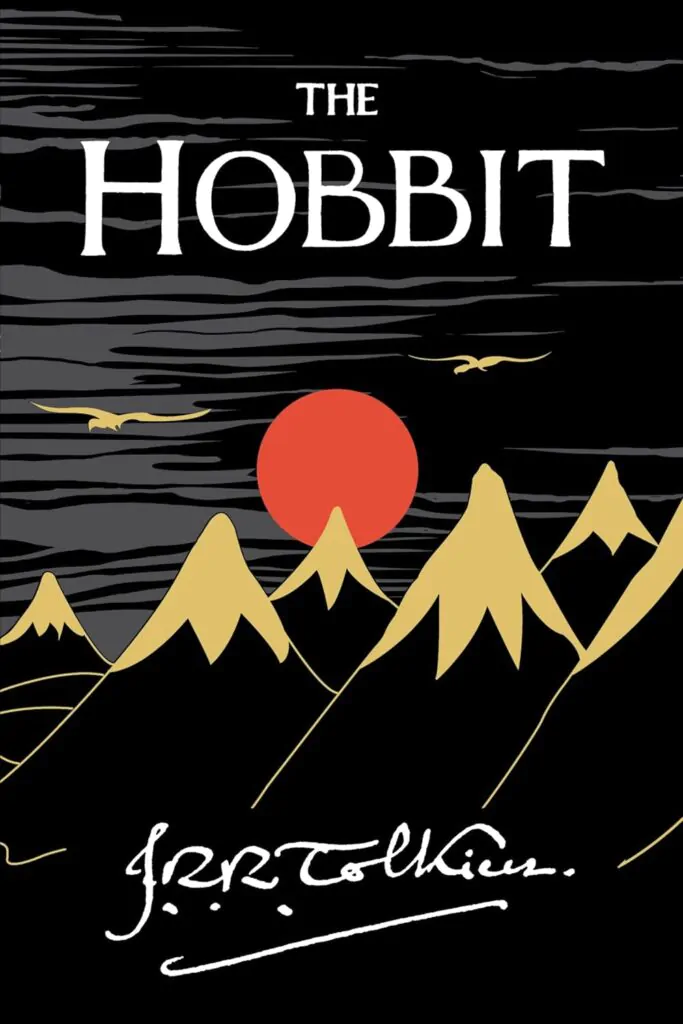
The Hobbit by J.R.R. Tolkien has featured regularly on best-seller lists since its first publication in 1937 and is widely cited as one of the twentieth century’s most beloved and influential novels. It’s a classic hero’s journey genre tale, too – featuring an unlikely hero in the form of Bilbo Baggins.
This unassuming hobbit is swept off on an adventure when Gandalf, the wizard, and a company of dwarves appear on his doorstep. He finds himself part of a mission to reclaim a fabulous horde of treasure from under the very nose of the fearsome dragon Smaug the Magnificent. For more, check out our guide to the best fantasy authors. You can also check out our guide on hero’s journey archetypes .
“This is a story of how a Baggins had an adventure , and found himself doing and saying things altogether unexpected.” JRR Tolkien
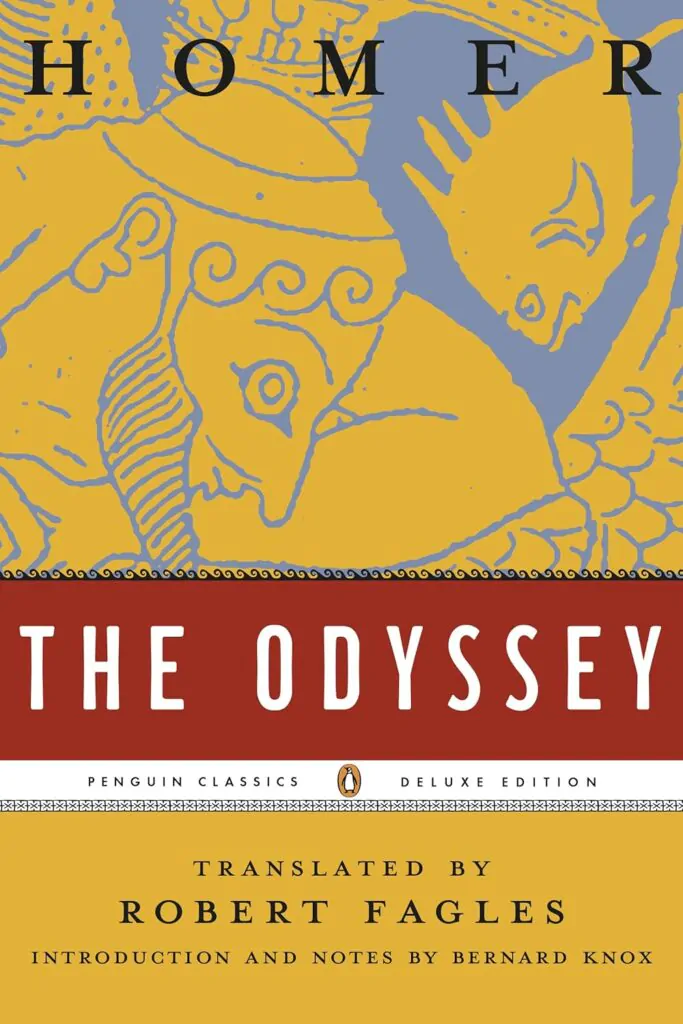
The Odyssey tells the story of Odysseus and is one of the oldest surviving works of literature that’s still being read by audiences today. This epic story tells the tale of the wandering king, trying to get home to his wife Penelope following the end of the Trojan War. The tale features all the tropes of a hero’s journey story, from its opening.
Odysseus is portrayed in his ordinary life, through to the Crossing the Threshold section, where the Gods become enraged with the hero and his company, summoning a storm to throw their boat off course, to The Return, whereby after completing a final challenge, Odysseus is returned to his royal life with Penelope.
“A man who has been through bitter experiences and traveled far enjoys even his sufferings after a time.” Homer
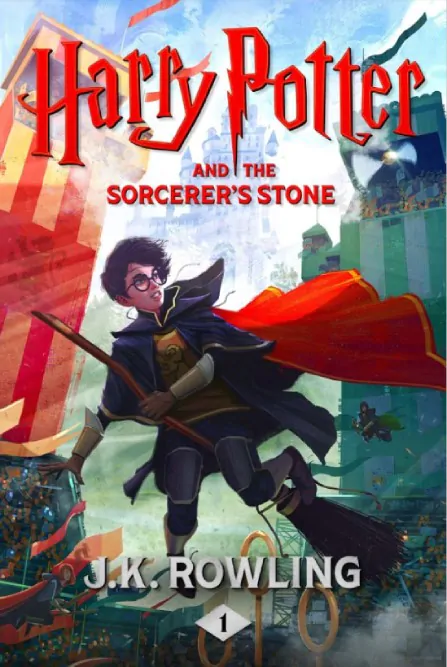
JK Rowling’s worldwide best-seller Harry Potter is a prime example of the hero’s journey tale. The book starts with Harry in the ordinary world before moving through all of the typical hero’s journey stages, as detailed by Joseph Campbell in his book The Hero with a Thousand Faces. Harry receives the invitation letter to Hogwarts (The Call to Adventure ), struggles to accept this sudden turn of events (Refusal of the Call), and Meets the Mentor – in the first book, this is Hagrid.
The Crossing the Threshold stage is his literal passing through the wall to access Platform 9 3/4 at the station. The Ordeal is represented by the various challenges the young wizard encounters at his new school, culminating in his temporary triumph over Voldemort. At the end of the book, he returns to the world of the muggles for the summer vacation, happy that he’ll be returning to Hogwarts soon (The Return).
“A breeze ruffled the neat hedges of Privet Drive, which lay silent and tidy under an inky sky, the very last place you would expect astonishing things to happen.” JK Rowling
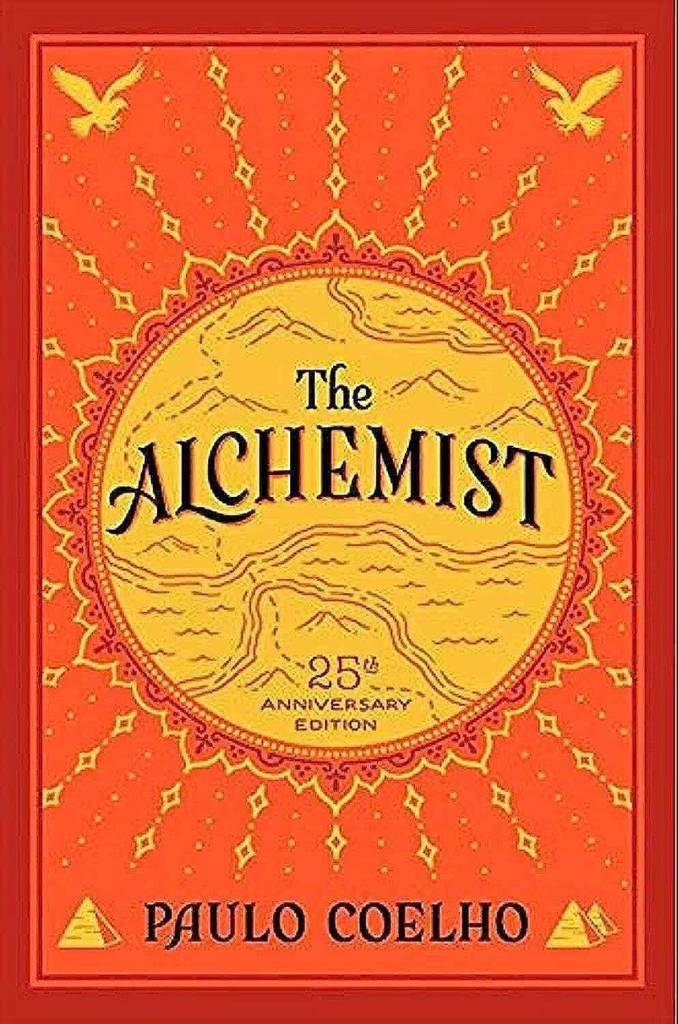
The hero’s journey takes many different forms: it’s not always about defeating villains or finding lost treasure. The genre can also be powerfully deployed in the service of a spiritual quest tale, as in this novel. While the young protagonist, who is a perfect example of the Innocent/Orphan hero archetype, might start his journey looking for real-world riches, what unfolds is a beautiful story of self-discovery. Ultimately, The Alchemist is about the importance of heeding our hearts and the transformative power of dreams.
“Remember that wherever your heart is, there you will find your treasure.” Paulo Coelho

The first volume of The Divine Comedy is considered a literary masterpiece, following the hero’s journey on a quest through the various Circles of Hell. After meeting Virgil (the Mentor), our narrator progresses, facing numerous trials and tests, always seeking his beloved Beatrice. Although he sometimes has ‘weapons’ with which to face his adversaries, his most potent weapon is his faith in his journey , which is a blend of both a spiritual and a physical mission.
“Soon you will be where your own eyes will see the source and cause and give you their own answer to the mystery.” Dante Alighieri

New York Times bestselling author Shannon Hale has written the book The Goose Girl that, although aimed at middle-schoolers, has become much loved by kids and adults alike. Drawing on the tradition of folktales, it’s a heroine’s journey story, recounting the tale of Ani, who’s uncomfortable around people but able to communicate easily with animals. She leaves her world behind. However, when she’s sent away to marry. Despite disaster striking, she finds herself in a job where she can use her unique talents and give voice to her inner self.
If we don’t tell strange stories, when something strange happens we won’t believe it.” Shannon Hale
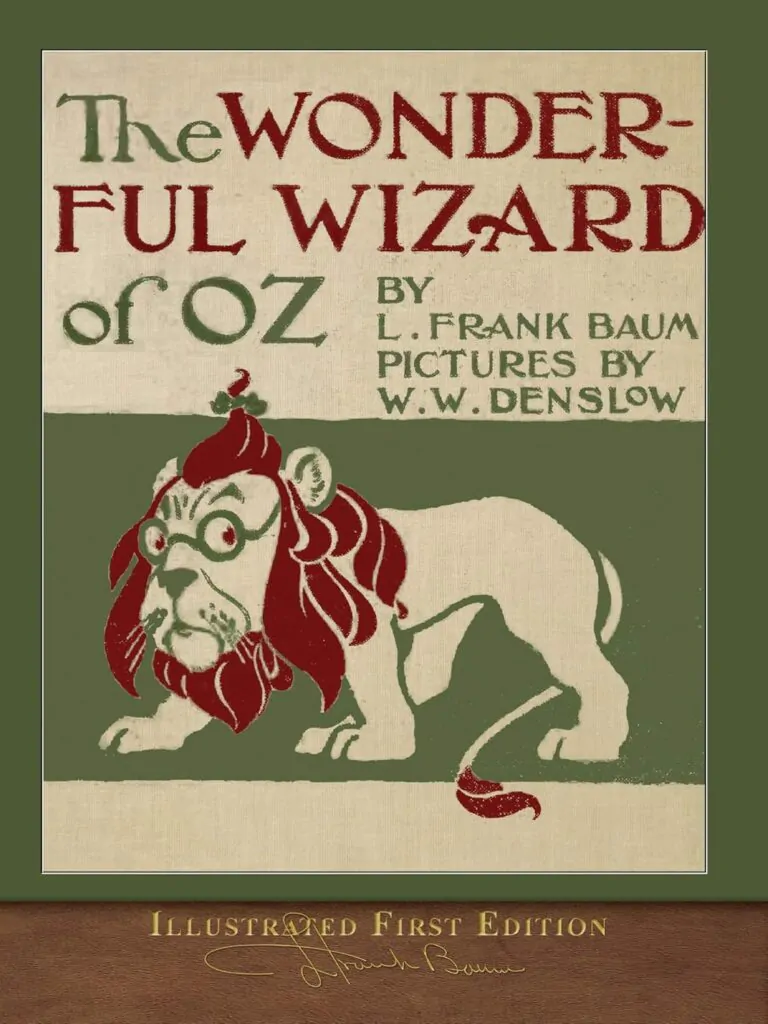
A key element of the heroine’s journey is, while it maintains recognizable archetype qualities, there is an overcoming or subversion of society’s expectations regarding women. Rather than staying at home in Kanas, Dorothy, in the book The Wizard of Oz has the adventure she longs for.
While the hero’s journey stories tend to move from the inner world to the outer (from the darkness to the light), the heroine’s journey is usually the inverse of this, with characters moving from the outer world to a deeper communion with their inner selves and desires.
“The true courage is in facing danger when you are afraid, and that kind of courage you have in plenty.’“ L Frank Baum
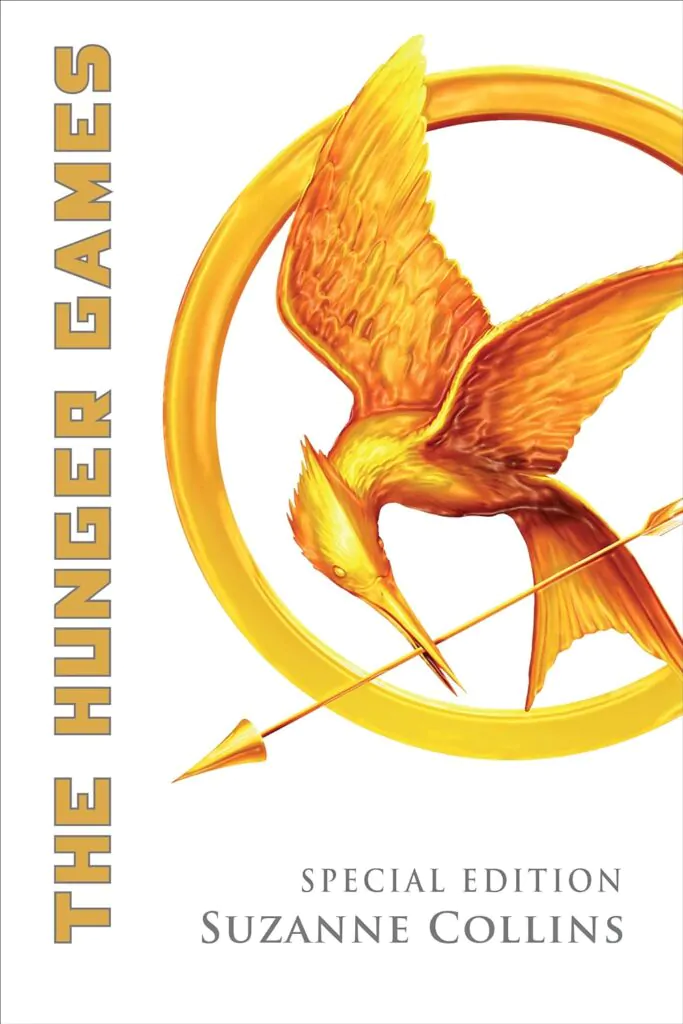
Envisioning a dystopian new world in which each District is compelled to send two children between the ages of twelve and sixteen to compete in the annual Hunger Games , Suzanne Collins’ novels are widely cited as examples of the hero’s journey genre. Now a Hollywood blockbuster series of movies, the story demonstrates how the tropes inherent in Homer’s tale of Odysseus, written nearly 3,000 years ago, are still alive and kicking today.
Looking for the perfect reads for teens? Explore our comprehensive guide featuring the best books for teenagers . Whether they’re into fantasy, adventure, or real-life stories, our list has something for every young reader. Check out the top picks now!
“I’m more than just a piece in their Games.” Suzanne Collins
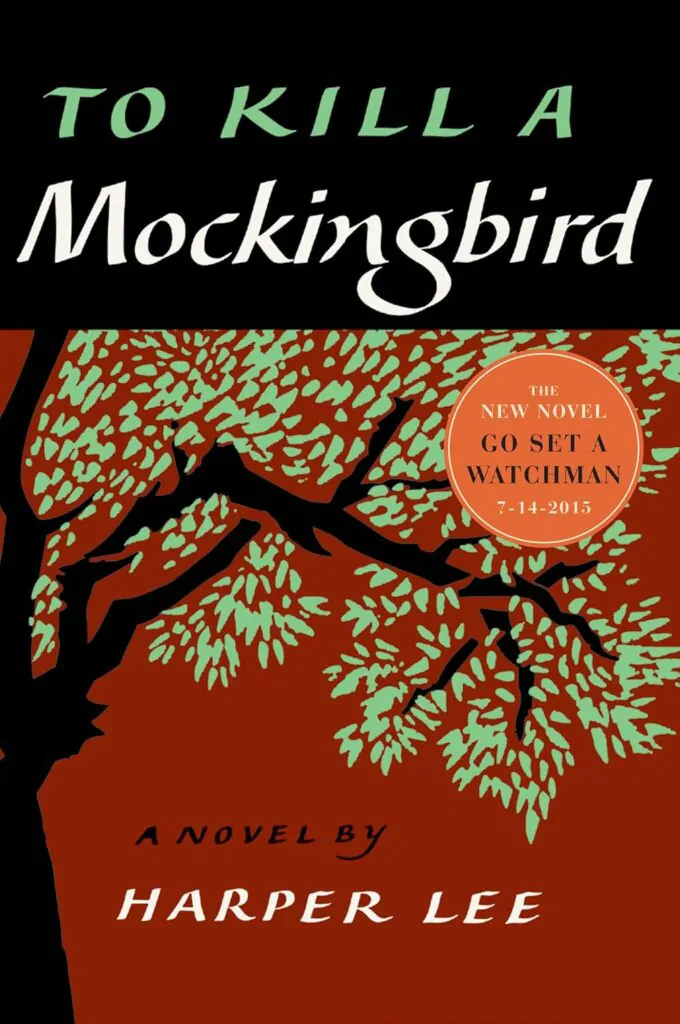
To Kill a Mockingbird is set in 1930s Alabama, Atticus Finch is a lawyer attempting to defend and prove the innocence of Tom Robinson, a black man wrongly accused of raping a white woman. Atticus’s hero’s journey is largely a psychological one, in which he faces his own innermost beliefs, and is forced to confront morality and prejudice in the south of the US, how this manifests, and its impact on the individual and society – as well as the delivery of justice.
“You never really understand a person until you consider things from his point of view. Until you climb inside of his skin and walk around in it.” Harper Lee
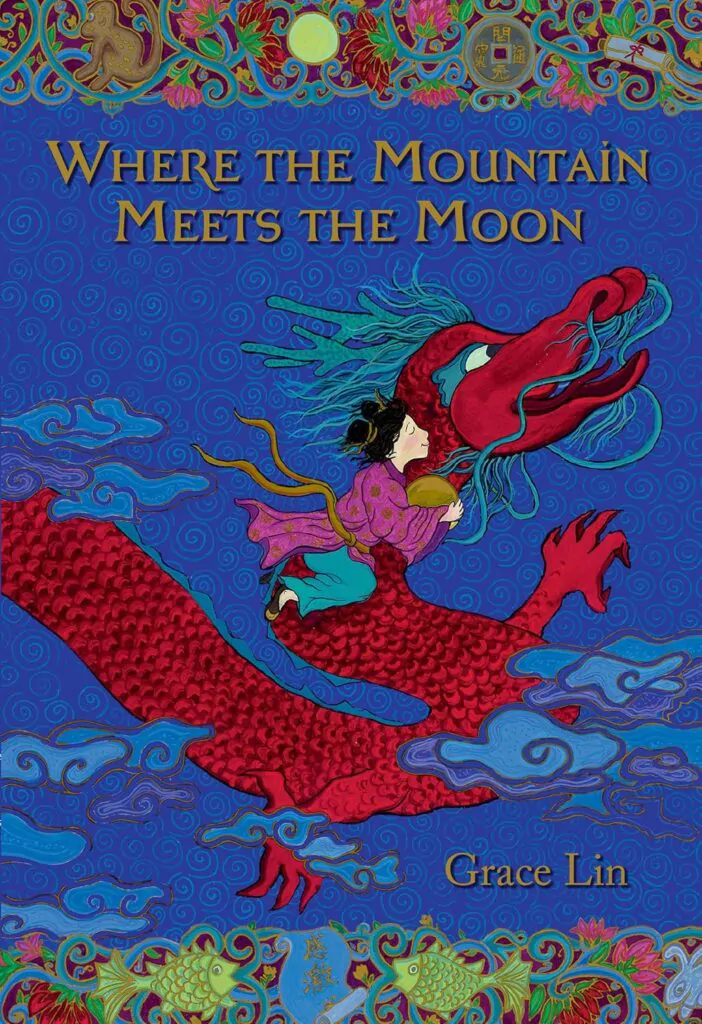
Another bestselling novel adored by adults and children alike, Where the Mountain Meets the Moon chronicles Minli’s quest as she journies to find the Old Man on the Moon. Drawing on Chinese folktales, this rich fantasy, accompanied by the author’s beautiful illustrations, follows Minli as she encounters a range of otherworldly characters in her quest to find the answers to some of life’s biggest questions.
“If you make happy those that are near, those that are far will come.” Grace Lin
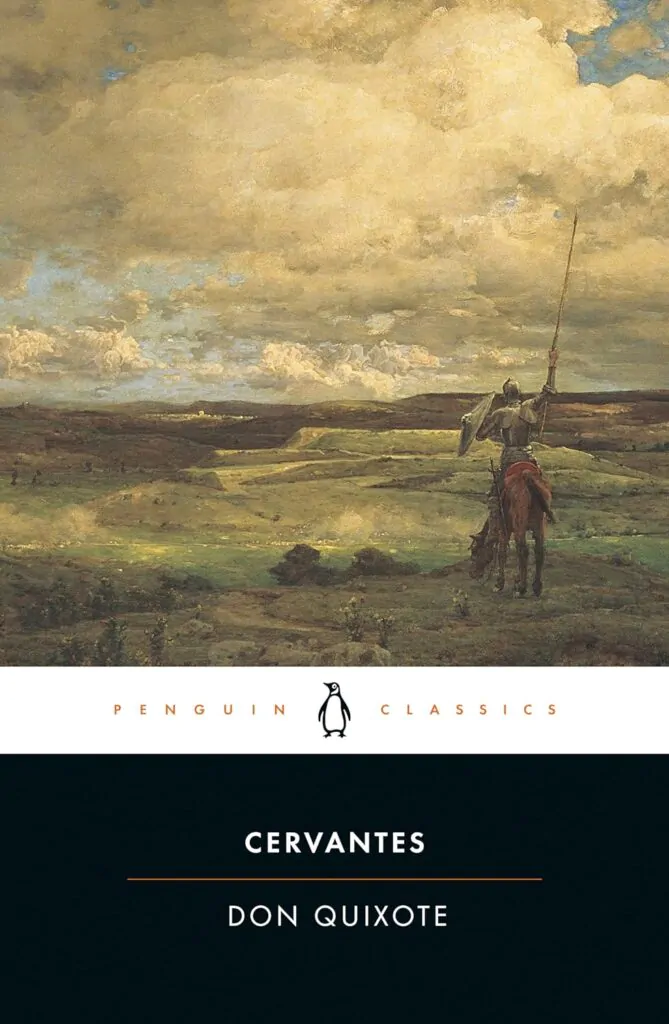
The Spanish masterpiece, Don Quixote , first published in 1605, begins in the ordinary world of Alonso Quijano, a middle-aged man who loves nothing more than reading stories about knights and their adventures. Deciding to leave behind his own life to become a knight errant himself, Alonso changes his name to Don Quixote and sets off on a series of heroic deeds – some more successful than others!
“It is by rugged paths like these they go that scale the heights of immortality, unreached by those that falter here below.” Miguel de Cervantes
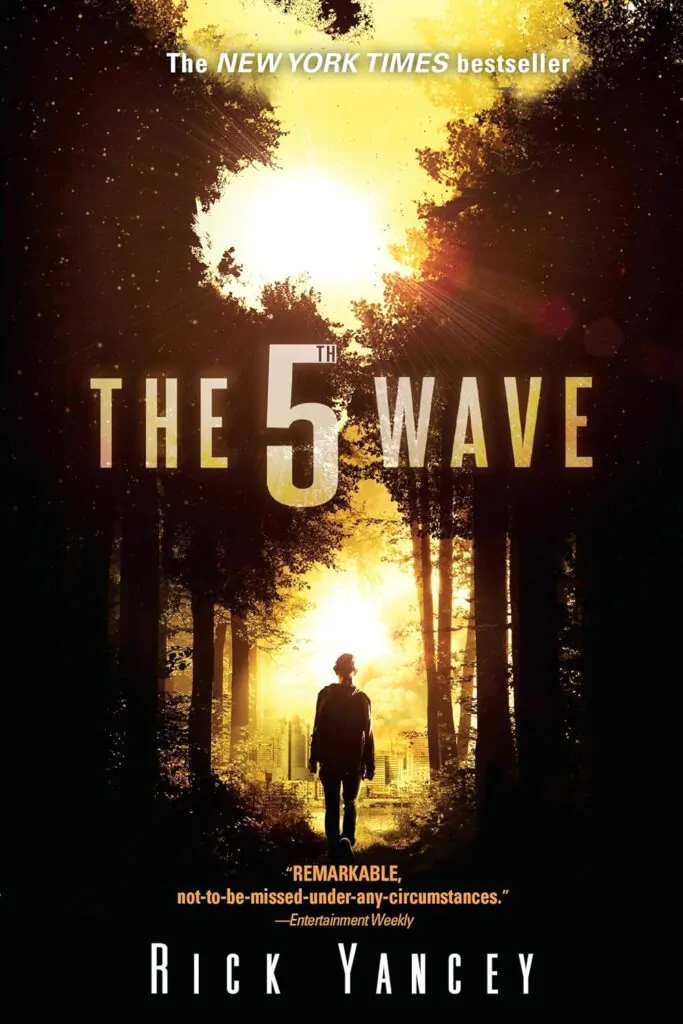
This Amazon bestseller by Rick Yancey received the Goodreads Choice award. The Fifth Wave focuses on Cassie and Evan, two of the last human survivors on Earth following an alien invasion, dreading the imminent fourth wave. As a hero’s journey tale, Cassie must tackle both a physical, dangerous quest and attempt to understand the truth of the terrifying new world she’s inhabiting.
“Some things you don’t have to promise, you just do.” Rick Yancey
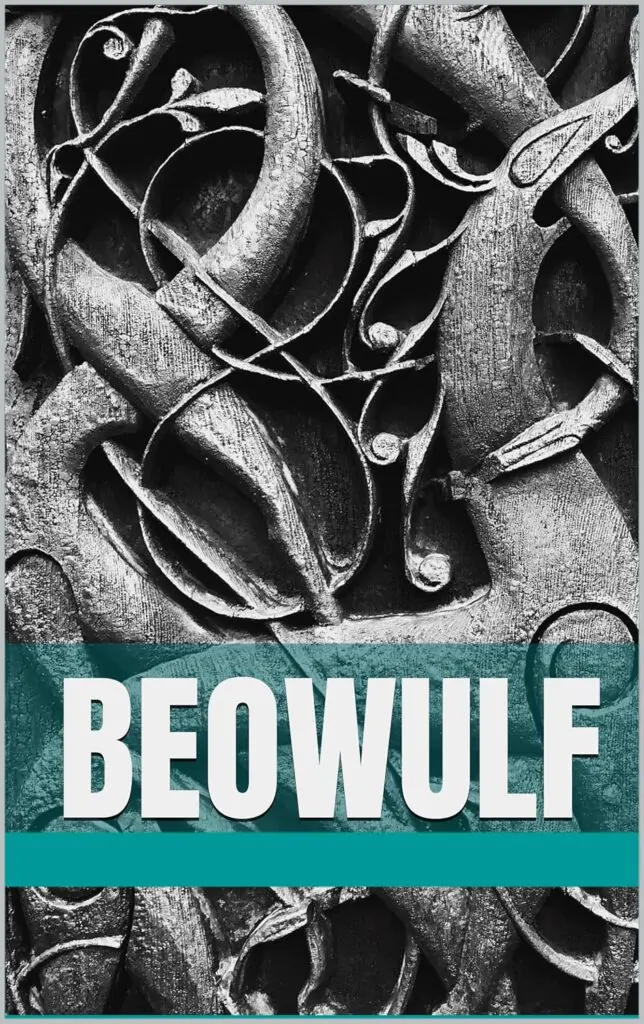
The hero in this Old English epic poem Beowulf from an unknown author follows precisely the steps outlined by Joseph Campbell in The Hero with a Thousand Faces. From the Call to Adventure and the Refusal of the Call and all the way through to The Return – otherwise known as The Elixir- in which the hero brings something back from his adventure to benefit society. In the case of Beowulf, it’s the insight he has gained, that will keep his people safe going forward, and his blessing of peace,
“In the time I was given I lived in my own land, ruling my people well, never turning to treachery, or swearing to oaths contrary to right.” Beowulf

A much-loved novel published in 1951 that follows the classic hero’s journey template, Siddhartha concerns the titular character on his quest for self-discovery. Deciding to leave his home in the ancient Nepalese kingdom of Kapilavastu, Siddhartha sets out as a wandering beggar seeking spiritual enlightenment. Through his journeying, the hero learns the importance of loving the world in its entirety and that a single, fixed belief does not constitute truth.
“ Knowledge can be communicated, but not wisdom. One can find it, live it, do wonders through it, but one cannot communicate and teach it.” Hermann Hesse
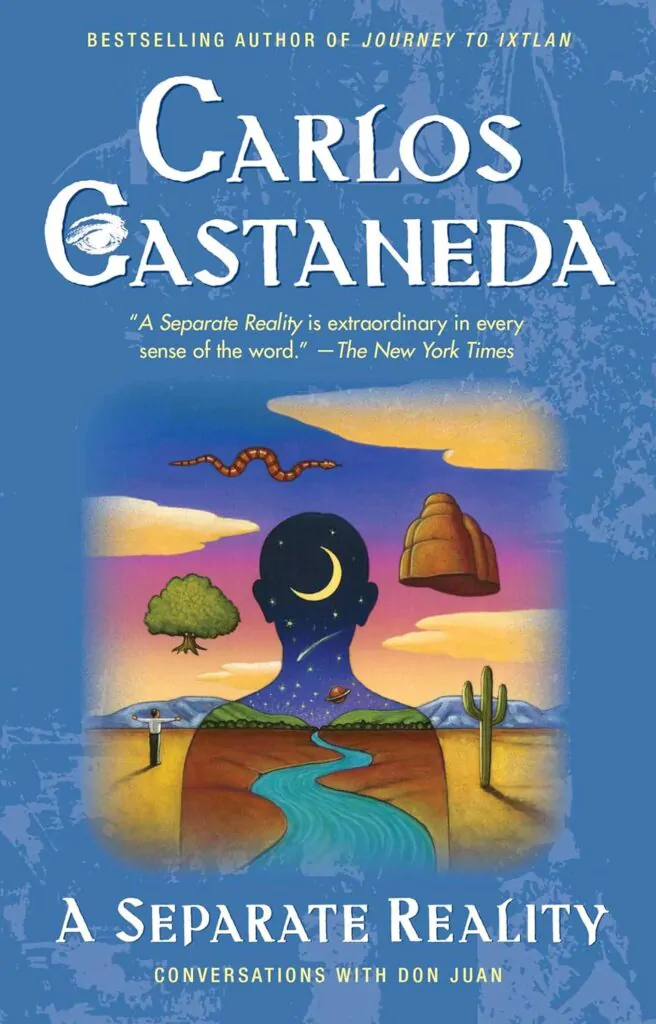
With its mind-bending perspectives and mythic structure, it’s unclear how much of this book A Separate Reality is fictional and how much is based on reality. With its clear mentor character (the Yaqui Indian shaman, Don Juan) and the dangerous journey at its heart that the protagonist is compelled to undertake, it’s a clear example of the hero’s journey story – though possibly one that pushes the boundaries of the genre more than any you’ve come across!
“We are men and our lot in life is to learn and be hurled into inconceivable new worlds.” Carols Castaneda
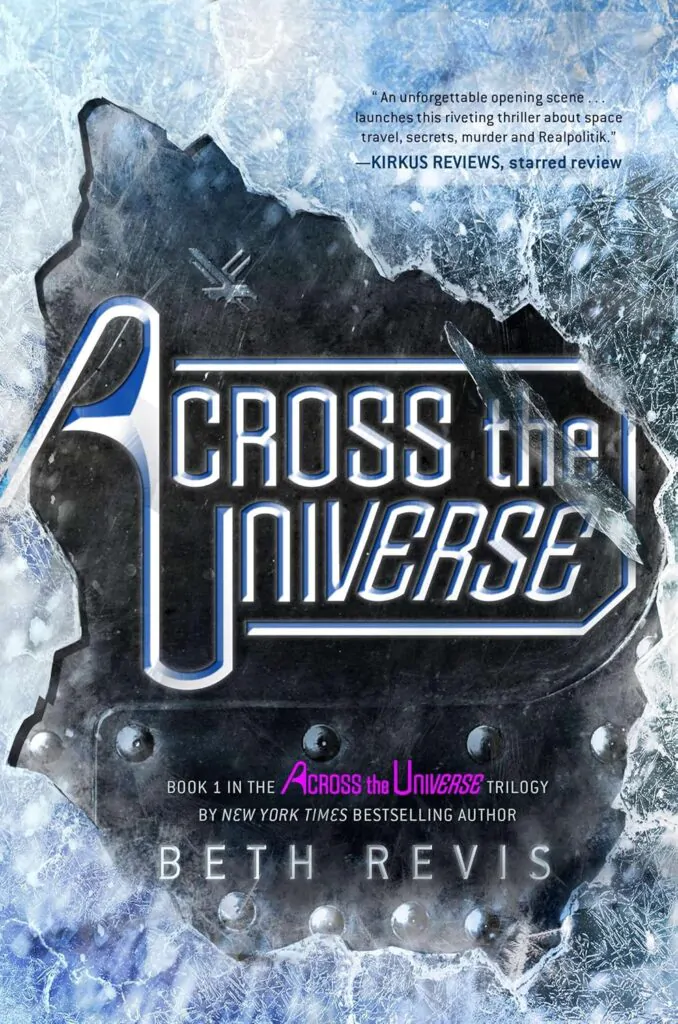
In the book Across the Universe , Amy awakens fifty years too soon from cryosleep, she finds herself aboard the spaceship Godspeed and in a terrifying situation. Realizing that her awakening didn’t happen by accident (The Call to Action), Amy has to accept the truth that someone else on board wants her dead – and that her parents, still in cryosleep, could be the next victims if she doesn’t figure out what’s going on. But meeting Eldest, the future leader of the ship, changes everything.
“Even when you are silent, even when you block out all noise, your body is still a cacophony of life.” Beth Revis
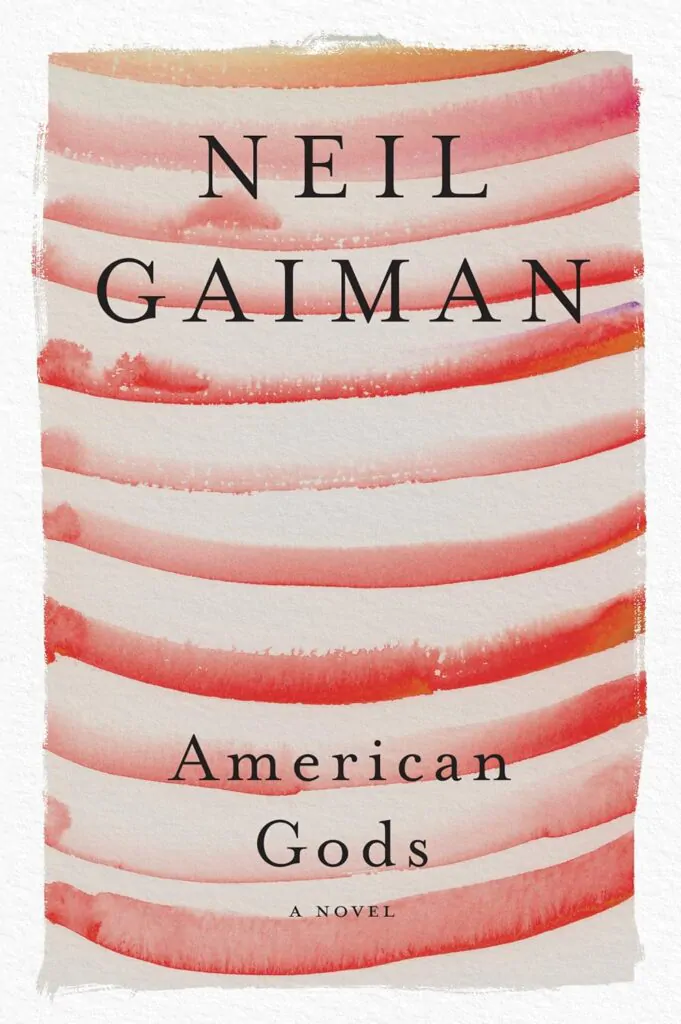
American Gods blend fantasy and world mythology (both old and new), this novel widely divides its audience: it falls into the love it or loathe it category. But whatever your views on the plot and the writing, it’s an innovative take on the hero’s journey trope that reimagines the genre.
Even its archetype, Shadow, is a vivid and disturbing (yet recognizable) hero figure – although, in typical Neil Gaiman style, the name ‘Shadow’ is also one of the character archetypes set out by Christopher Vogler’s author of the influential book, The Writer’s Journey .
“Even nothing cannot last forever.” Nail Gaiman
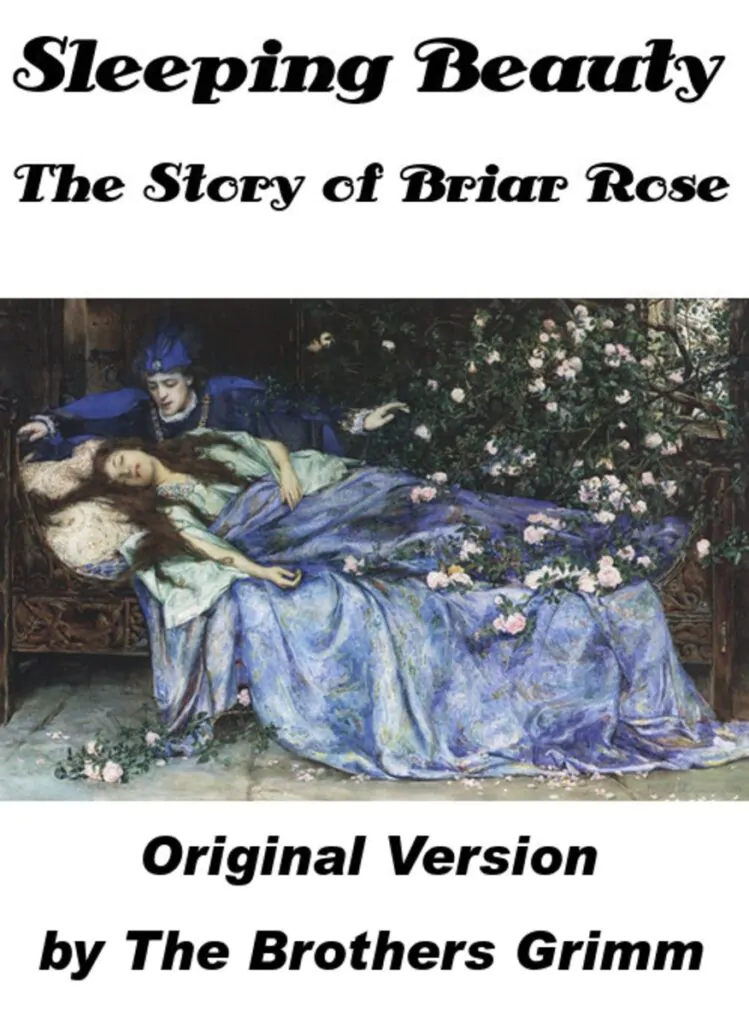
Fairy tales are great places to look for the hero’s journey stories themselves, born from ancient folktales, legends, and myths. There are many versions of this tale, many of which feature very dark and disturbing themes, but the Grimms’ version of Little Briar Rose (Sleeping Beauty) is relatively tame.
While reading , consider the extent to which the story is a hero’s or a heroine’s journey tale – thinking about the journey from outer to inner (and vice versa) and how this relates to the narrative of both the prince and Briar Rose herself.
“The pigeons upon the roof pulled out their heads from under their wings, looked round, and flew into the open country; the flies on the wall crept again; the fire in the kitchen burned up and flickered and cooked the meat; the joint began to turn and fizzle again.” Brothers Grimm

In his writings, the renowned psychiatrist and psychoanalyst Carl Jung outlined his ideas about archetypes, including archetypal journies, contending that humans’ unconscious minds are remarkably similar. This is why the hero’s journey stories have always permeated literature and art and continue to do so.
At its heart, the journey of Jane Eyre is the same as that taken by Luke Skywalker in Star Wars, despite the time and genre divide between the two. Just as Luke’s quest is about discovering truth and recognizing potential, so Jane’s journey is concerned with growth and independence – and there’s a disturbing truth in the attic to confront along the way, too.
Just as with Skywalker, Jane emerges at the end of the tale as a strong, loyal, passionate character who has faced a devastating reality and emerged from the ordeal with even greater reserves of tenacity than before. For more, check out our guide to the best British authors .
“I am no bird; and no net ensnares me: I am a free human being with an independent will.” Charlotte Bronte
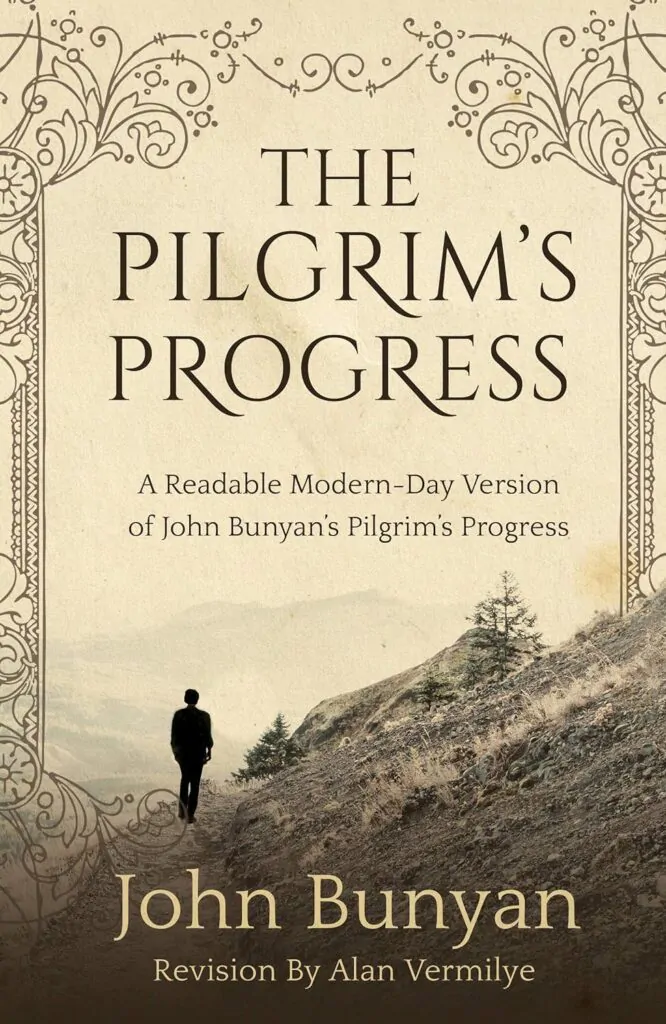
The Pilgrim’s Progress is a classic hero’s journey tale and, at times, the most widely read book in the world, second only to The Bible, Bunyan’s book is concerned with the importance of learning and reading and the innate value of community. The hero, Christian, leaves his home and must face a series of trials – key to the genre. However, each tribulation or challenge must be thoroughly understood if a pilgrim is to progress. There’s even a final trial – a test of faith – which Christians must pass to access the Celestial City.
“The road of denial leads to the precipice of destruction.” John Bunyan

The greatest literary detective of all time, Sherlock Holmes, is a hero archetype: The Researcher (the character of Indiana Jones also falls within this hero category). The Hound of the Baskervilles is one of the most well-known stories featuring Holmes and his trusty sidekick Dr. Watson. This is a great book for those interested in the hero’s journey genre, as the stages are so clearly delineated, from the Call to Action (Holmes’ enlistment to the case) through to The Return, whereby Watson files the case closed.
“The world is full of obvious things which nobody by any chance ever observes.” Arthur Conan Doyle
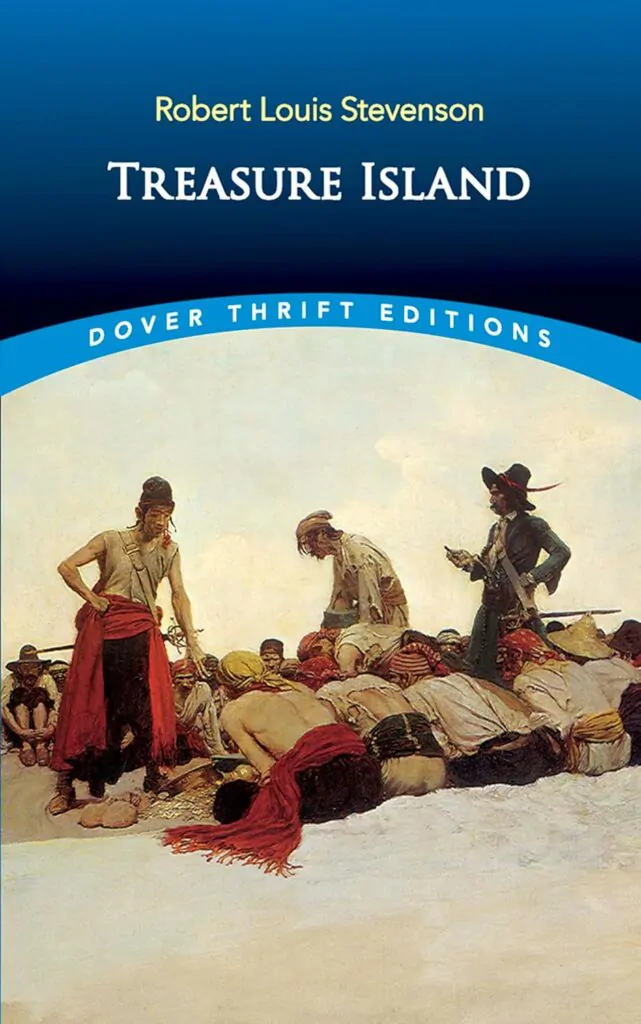
In this classic novel Treasure Island by a 19th-century author, we meet Jim going about his daily life in the inn that his family owns. Following the Call to Action, where the boy becomes fascinated with the ‘black spot’ presented to the old captain, Billy Bones, who’s staying at the inn, Jim becomes embroiled in an epic adventure on the high seas in search of buried treasure.
“We are all travelers in the wilderness of this world, and the best we can find in our travels is an honest friend.” Robert Louis Stevenson

Testament to the power of myth is the enduring popularity of this story, which recounts the adventures of Jason and the Argonauts as they quest for the golden fleece. The epic, written – incredibly – in the third century BC, remains so widely read that there are not only multiple versions available on Amazon, but you can listen to it as an audiobook, too! Argonautica features all the archetypal stages of the genre, including the Refusal of the Call, whereby Jason initially urges the heroes to elect another leader for the voyage. Once chosen, though, Heracles insists that Jason can take up the mantle, confident he can lead the band to victory.
“But friendly Juno shrouds/Her favorite heroes in a veil of clouds.” Apollonius
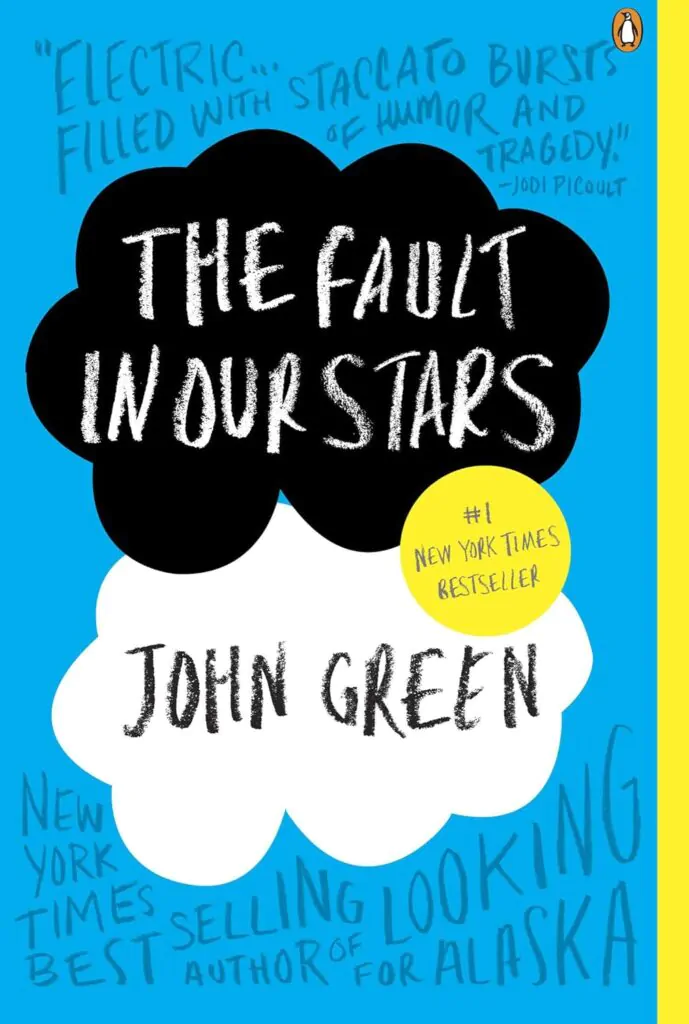
The Fault in Our Stars , a bestseller that was also received extremely well by critics, this novel is a hero’s journey tale with a difference. Hazel, our protagonist, is sixteen years old and suffering from thyroid cancer that has spread to her lungs. Her parents insist she attends a support group (Crossing the Threshold) where she meets Augustus Walters, a seventeen-year-old osteosarcoma survivor. It’s now a Hollywood blockbuster movie that captures Amy’s journey into love.
“My name is Hazel. Augustus Waters was the great star-crossed love of my life.” John Green

When fourteen-year-old Stanley is wrongly convicted of stealing, he’s sent to a correctional camp where the inmates are forced by the warden to dig holes, seemingly at random. The story of Holes is comprised of three individual but interconnected tales. It makes for a fascinating take on the hero’s journey genre, the pattern of which can be seen both in the three stand-alone stories and in the overarching triptych.
“You’re responsible for yourself. You messed up your life, and it’s up to you to fix it.” Louis Sachar

This novelization of the Hollywood movie Interstellar is an exciting account of a team of interstellar explorers sent through a newly discovered wormhole – and what the ramifications of this mean for humanity. Despite being written thousands of years after Argonautica, the story shares a remarkably similar bone structure, as our hero literally navigates new worlds in a quest to return with the solution that will save the human race from extinction.
“We’ve always defined ourself by our ability to overcome the impossible.” Jonathan Nolan

Divergent by Veronica Roth offers a dystopian version of a future in which society is divided into five factions, each representing a certain virtue. Beatrice has been assigned the Abnegation faction but feels a Call to Action: in her heart, she knows she belongs to Dauntless. While set in a distant future, the tale follows the traditional archetypal hero’s journey ; after the Call, Beatrice (now Tris) must resist several temptations, cross a threshold, and must survive a final ordeal to emerge at the novel’s finale, transformed and triumphant.
“I feel like someone breathed new air into my lungs. I am not Abnegation. I am not Dauntless. I am Divergent.” Veronica Roth
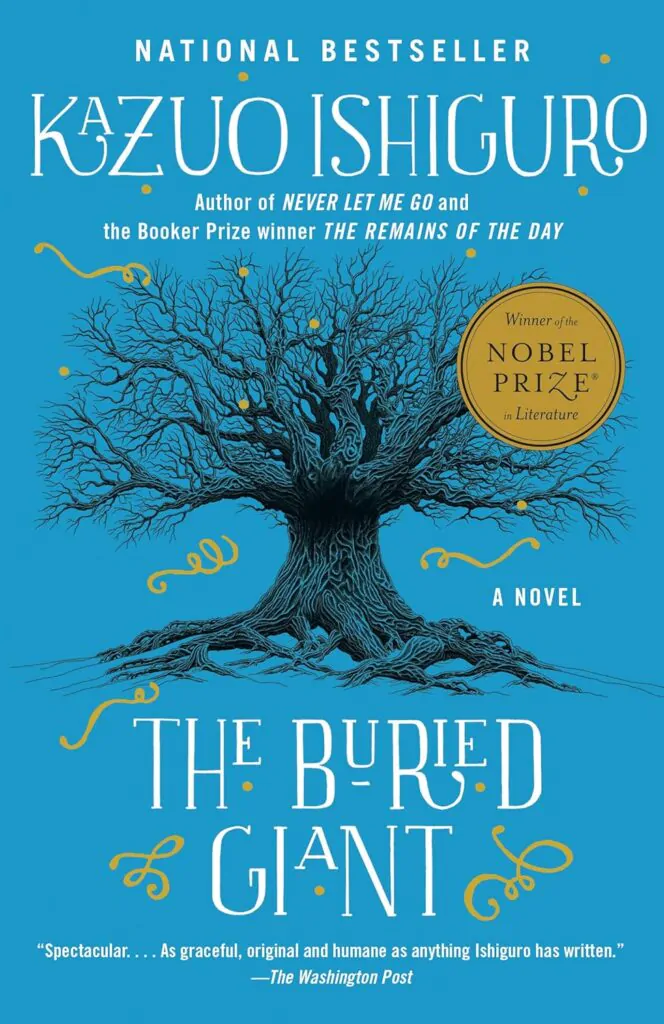
Beautiful and strange, The Buried Giant uses the mythic structure as both framework and plot. We follow a couple across a mystical, fiction, post-Arthurian landscape that is as shrouded in mist as their fast-disappearing memories. Both are convinced that they once had a son and so set out on a quest to find him. The author wrote the book as a meditation on collective memory, making it both an example and an interrogation of the hero’s journey tale.
“I’m wondering if without our memories, there’s nothing for it but for our love to fade and die.” Kazuo Ishiguro
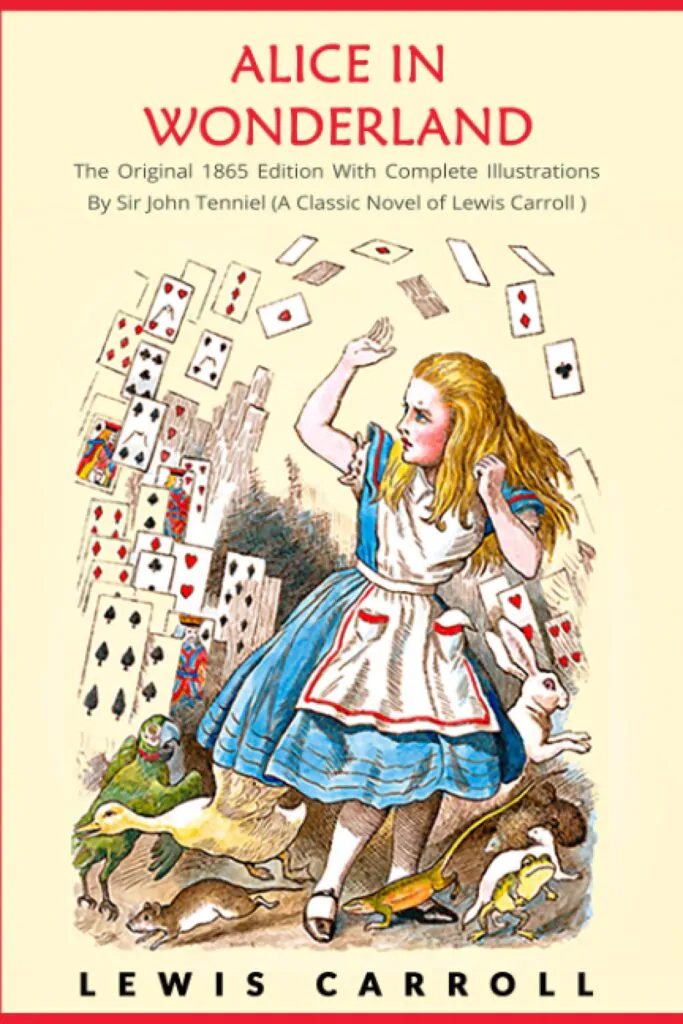
Crossing the threshold via a fall down a rabbit hole, Alice arrives in Wonderland, where nothing is as it seems, and both adventure and danger lurk around every corner. But is the Caterpillar, The White Rabbit, or The Mad Hatter the Mentor? Just as with everything else in the story of Alice in Wonderland , it’s a riddle. But what’s for sure is that the story follows the classic monomyth template as set out by Joseph Campbell.
“‘I could tell you my adventures – beginning from this morning,’ said Alice a little timidly: ‘but it’s no use going back to yesterday because I was a different person then.’” Lewis Carroll
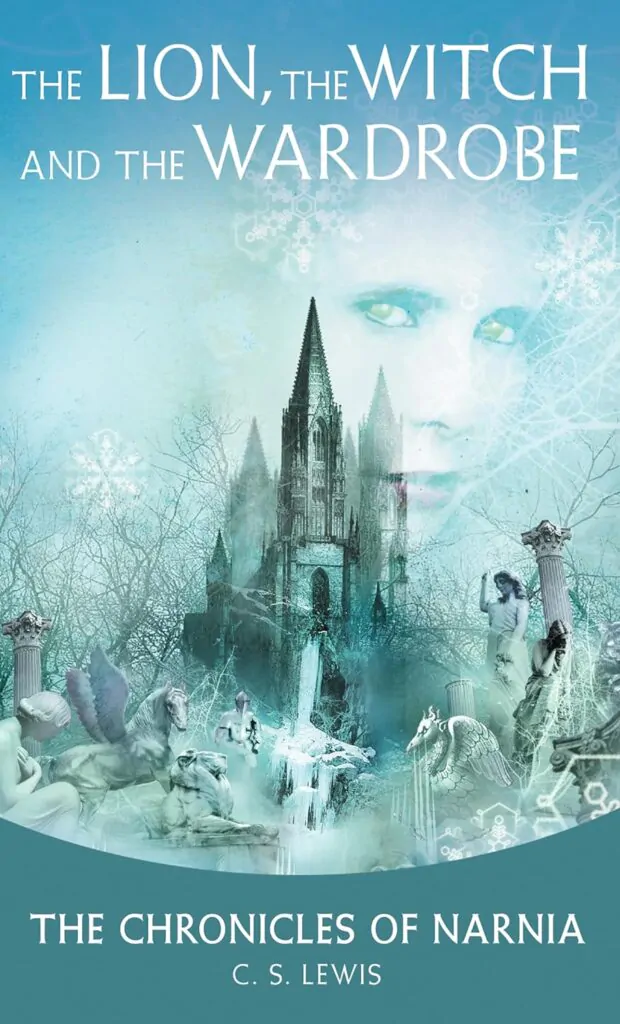
In some hero’s journey books, the stages are subtle – you can find them, but you may need to look closely. As in Alice in Wonderland, the phases are made obvious in this novel The Chronicles of Narnia : the kids literally step over the threshold of the magical wardrobe and into the enchanted world of Narnia. The Refusal of the Call comes when the children initially turn back, fearful of their ability to navigate their way home. They return and take on the challenges set for them by one of literature’s ultimate Mentor figures, Aslan.
“All shall be done, but it may be harder than you think.” C.S. Lewis
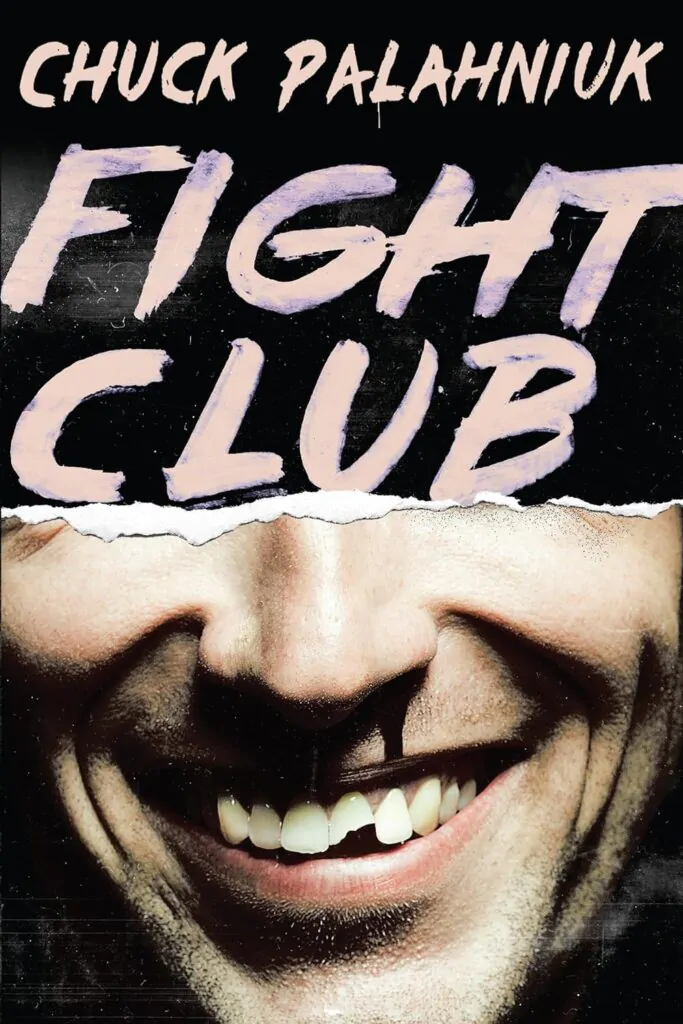
Just because the hero’s journey genre is as old as time doesn’t mean it’s not subject to continual innovation – as in this novel, where the hero’s Mentor and biggest challenge to overcome is…literally himself. Fight Club is a cult phenomenon that’s made the leap to mainstream hit, helped along by the success of the great screenwriting featured in the Hollywood movie version of the book. Visionary, satirical, and a personal enlightenment journey like no other, Fight Club gleefully reimagines the hero’s journey genre to spectacular effect.
“If I could wake up in a different place, at a different time, could I wake up as a different person?” Chuck Palahniuk

- The Writer’s Journey: A Must-Read for Storytellers
by Melissa Donovan | Jul 25, 2024 | Writing Resources | 0 comments
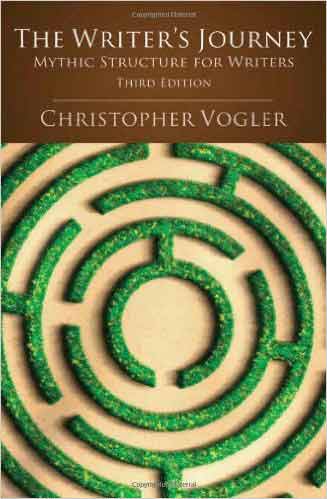
The Writer’s Journey by Christopher Vogler.
If you read only one book on storytelling, make it The Writer’s Journey by Christopher Vogler.
Over the years, I’ve read a lot of books on writing fiction. Many have been helpful, but some have left me feeling disappointed, especially those that promise their methods will result in a successful story or make grand claims that their way is the only correct way to write a story. I’ve seen these claims made in books on the writing process and in books on story structure.
The Writer’s Journey makes no such claims, but it does provide us with a story structure that was discovered, not created. It’s based on universal patterns in storytelling that are flexible yet proven. As you read through it, you’ll immediately recognize these patterns in almost every story you’ve read or watched.
A Little History
“The pattern of the Hero’s Journey is universal, occurring in every culture, in every time. It is as infinitely varied as the human race itself and yet its basic form remains constant.” — Christopher Vogler, The Writer’s Journey
Joseph Campbell was a mythologist who discovered recurrent patterns in myths, legends, and folklore. These patterns occurred in stories throughout human history and all around the globe. He recorded these observations in a book called The Hero with a Thousand Faces . This is the book that gave us the Monomyth, which is more commonly known as the Hero’s Journey.
Although it was brilliant, Campbell’s work was dense, highly academic, and spent a lot of time on the connection between psychology and mythology (as well as stories from scripture and religious traditions). It identified common patterns in storytelling, but it focused on myths, legends, and folklore, leaving out other genres. It was also rooted deep in the past, because it was based mostly on ancient tales. Human culture has since evolved, and so has storytelling.
Enter Christopher Vogler, a Hollywood script analyst who studied Campbell’s work and produced a seven-page memo for his peers to help them improve the stories in the films they were making. Vogler had reworked Campbell’s discoveries into a simple model for storytellers — a model that was applicable to all stories, not just myths and ancient legends. The memo became legendary in the storytelling world and was eventually expanded into a book called The Writer’s Journey .
The Hero’s Journey
“The self-conscious, heavy-handed use of this model can be boring and predictable. But if writers absorb its ideas and recreate them with fresh insights and surprising combinations, they can make amazing new forms and original designs from the ancient, immutable parts.” — Christopher Vogler, The Writer’s Journey
You’ve probably heard of the Hero’s Journey. There are hundreds of articles, videos, and blog posts about it all over the internet. Many authors have created their own variations. I’ve studied various incarnations of the Hero’s Journey over the years, but nothing is as clear or useful as The Writer’s Journey .
The Hero’s Journey is a structure for storytelling — a form, not a formula. It was observed, not invented, so it already existed and had a proven track record long before Campbell unearthed it or Vogler refined it. The pattern can be observed in stories such as The Wizard of Oz , which was created long before Campbell or Vogler came along.
The Hero’s Journey can be used to write stories, troubleshoot stories, or analyze and study stories. It also provides us with language for discussing common elements in stories, like the Herald, the Mentor, or the Call to Adventure.
I’ll provide a brief overview of the Hero’s Journey, but you’ll only get a fraction of what it’s all about if you don’t read Vogler’s book, which, by the way, is a fun and delightful read.
“The Hero’s Journey is not an invention, but an observation.” — Christopher Vogler, The Writer’s Journey
The Hero’s Journey starts with eight archetypes. They are often characters, but archetypes are better viewed as functions or energies in a story:
- Hero: Protagonist who undergoes a meaningful transformation through the story.
- Herald: Signals that an adventure (or change) is imminent.
- Mentor: Teacher and guide.
- Threshold Guardian: Blocks a threshold that the Hero must pass.
- Shadow: The villain and other characters that stand in the Hero’s way; often they embody the Hero’s negative or undesirable traits.
- Shapeshifter: A character or entity whose motives or intentions are unclear.
- Trickster: Comic relief; tricksters are often catalysts for change.
- Allies: The Hero’s friends and helpers.
Each of these archetypes has a very specific job to do in a story. Some characters may perform the functions of multiple archetypes, and some archetypal roles may be fulfilled by events or objects (such as when a book provides the function of a mentor).

Stages of the Journey
“The model only shows the most likely place for an event to occur.” — Christopher Vogler, The Writer’s Journey
The Hero’s Journey then delves into twelve stages of a story. This is not an outline or formula. The stages can occur out of order, and they can overlap one another. This is a very loose guide that we can use to assess a story’s structure and identify its core beats:
NOTICE: This section includes spoilers for The Wizard of Oz , Star Wars: Episode IV A New Hope, Harry Potter , and Titanic , which are used as examples.
1. Ordinary World: We see the Hero’s world before the story really kicks in. In The Wizard of Oz , this is Dorothy in the gray world of her family’s Kansas farm.
2. Call to Adventure: Something (usually a Herald) signals that change is afoot. A classic example is the first appearance of white rabbit in Alice in Wonderland .
3. Refusal of the Call: The Hero refuses to answer the call to adventure, often citing excuses. In Star Wars , Luke Skywalker insists he can’t accompany Obi-Wan Kenobi because he must stay and help his uncle on the farm.
4. Meeting with the Mentor: The Hero encounters a Mentor, who will provide guidance and bestow necessary tools and skills. In Harry Potter , Hagrid (and many other characters) provide Harry and his friends with guidance and magical objects that will be essential in overcoming the series of challenges they will face.
5. Crossing the First Threshold: The Hero passes the first Threshold, leaving the Ordinary World and entering the Special World of the story. In the film Titanic , Rose boards the ship with her mother and fiance. This is an example without a Threshold Guardian, but often the Hero must pass a test and get past a guard to cross the threshold into the Special World.
6. Tests, Allies, and Enemies: The Hero acquires allies (often building a team), faces tests, and establishes enemies. In The Wizard of Oz , Dorothy finds allies in the Scarecrow, Tin Man, and Cowardly Lion. The Wicked Witch of the West issues a threat, becoming Dorothy’s enemy. Dorothy and her friends overcome a series of challenges as they journey toward the Emerald City.
7. Approach to the Inmost Cave: The Hero (usually accompanied by Allies) approaches the story’s central Ordeal. In Star Wars, this is when the Millennium Falcon is being sucked into the Death Star.
8. Ordeal: The Ordeal often occurs underground or inside the enemy’s lair. The Hero (and team) face their biggest threat and undergo a metaphorical death and rebirth. In some stories, this is a love scene, such as in Titanic , when Jack and Rose consummate their relationship in the vehicle storage section of the ship.
9. Reward: The Hero is rewarded for surviving the Ordeal. In The Wizard of Oz , Dorothy gains possession of the Wicked Witch of the West’s broom after she successfully kills the witch.
10. The Road Back: There’s one more big challenge ahead. In Star Wars , Luke and his team are going to attempt to take out the Death Star.
11. Resurrection: This big challenge includes another metaphorical death and rebirth. In Titanic Rose almost drowns but wakes up and swims through the freezing water to grab a whistle and get herself rescued.
12. Return with Elixir: The Hero has successfully completed the journey and can now return to the Ordinary World, often bringing an elixir, which can be something that saves the people of the Ordinary World but can also be personal improvement. In The Wizard of Oz , Dorothy returns to Kansas with a new appreciation for home and family, and having integrated and balanced the three traits of kindness, intelligence, and courage.
The Writer’s Journey is a Must-Read for Anyone Interested in Storytelling

The Writer’s Journey is a guide, not an instruction manual, for storytellers. And while the overview above will give you a broad sense of how it works, the book itself delves deep into each archetype and stage of the Hero’s Journey, providing clear yet detailed descriptions along with examples from well-known films, so you can easily relate the concepts to real-world examples. There are also in-depth analyses of films like The Wizard of Oz , Titanic, and Pulp Fiction to show how the Hero’s Journey works in some of the most successful stories of all time.
I cannot recommend this book strongly enough. And I’m glad it’s available in paperback, because I marked it up with notes and highlights, and I’m sure that I will return to it again and again, both in my work as a storyteller and as a writing coach.
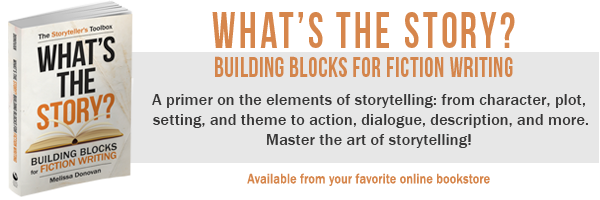
Submit a Comment Cancel reply
Your email address will not be published. Required fields are marked *
This site uses Akismet to reduce spam. Learn how your comment data is processed .

Subscribe and get The Writer’s Creed graphic e-booklet, plus a weekly digest with the latest articles on writing, as well as special offers and exclusive content.

Recent Posts
- Punctuation Marks: The Serial Comma
- Getting Creative with Essay Writing
- Tips for Crafting Language
- A Selection of Journal Prompts from 1200 Creative Writing Prompts
Write on, shine on!
Pin It on Pinterest
- Sep 7, 2018
The Hero's Journey: 12 of the Best Books about Quests
Updated: Sep 26, 2018

The quest narrative is one of the oldest and more enduring types of stories. It has played a prominent role in folklore and myth around the world and continues to appear in fiction and film. Closely tied to the monomyth of the Hero’s Journey, the quest narrative is centred on a character who must set out on a journey in order to achieve a goal. This journey usually takes the character and the readers through exotic or fantastical landscapes, as well as through a series of obstacles and perils. The object of the quest typically centres on the search for a person, place, or thing, as seen in the stories of The Wizard of Oz , the hunt for El Dorado, and the quest for the Holy Grail, respectively. The desire, or wish to return home after the object is found also plays a prominent role in many quest narratives.
Quests have appeared in literature throughout the ages, usually in the most popular genre of that era. They came to prominence in the chivalric romances of the Middle Ages, and the figure of the knight-errant has remained closely tied to the conception of quests ever since. This is particularly notable in the adventure fiction of the 19th century, which saw not only a resurgence of quest stories, but also of novels set in the medieval era, such as Walter Scott’s Ivanhoe . This medievalist approach has continued into modern fantasy literature where the quest continues to play a prominent role in some of the most popular books of today. Here we have listed some of the great examples of quests in literature across the ages.

The Odyssey by Homer
Homer’s epic poems, the Iliad and the Odyssey are among some of the oldest
surviving examples of Western literature. While the story of the Odyssey happens chronologically directly after the events in the Iliad, in that it charts the journey home of a group of soldiers involved in the Trojan War, the two poems have a very different tone and style. Where the Iliad is tragic, the Odyssey has much more of an adventurous feel. The Odyssey’s quest is unusual in that it is centred on the ‘returning home’ aspect rather than the going out. Within this overarching quest however is a series of smaller quests and adventures that take Odysseus and his comrades into the lairs of cyclops, through the waters of sirens and into the underworld. An enduring classic for a reason, it’s hard not to get swept up in the trials and exploits of Odysseus and his comrades in their quest to return home.
Le Morte Darthur by Thomas Malory
While The Odyssey remains one of the most iconic quests in the literary canon, as already noted the conception of quests is often much more associated with medieval courtly romances. Of these, the Arthurian legends are perhaps the most enduring. Completed in 1470, Sir Thomas Malory’s Le Morte d’Arthur is considered the definitive English account of King Arthur’s life, from his ascent to the throne and his founding of the Knights of the Round Table, to the fall of the golden age of chivalry culminating in his death. Although not the only quest described, the greatest part of the text is given to the individual efforts of the various knights to find the Holy Grail. In this Le Morte d'Arthur is perhaps the quintessential quest story.
Sir Gawain and the Green Knight
Where Le Morte d’Arthur takes a serious look at the expectations of heroism and the need for true chivalry, another medieval Arthurian story, Sir Gawain and the Green Knight takes an altogether more light-hearted approach. It is an outlandish and playful tale and the quest in this case is an unusual one, as it is a journey towards death. Set on New Year’s day, an unexpected guest, in the form of the Green Knight, appears at the Camelot festivities. He
challenges any of the knights to strike him with their axe, on the condition that he may return the blow in exactly one year. Sir Gawain agrees, striking the green knight on the neck, but the beheaded knight simply picks up his own head and walks away. Gawain must then set out to find the castle of the Green Knight and receive his agreed blow. The story which was recorded in the 14th century, here receives a modernized rendering by J.R.R. Tolkien, who will be
returned to later in this list for his own quest stories. This edition also contains another medieval quest story, Sir Orfeo , in which a knight must enter the fairy world in order to retrieve his stolen wife, making this particular edition an excellent place to explore medieval quests.
The White Company by Sir Arthur Conan Doyle
In moving on to the adventure fiction of the 19th century, we find ourselves right back in the medieval world, with Arthur Conan Doyle’s knightly historical tale The White Company . While Doyle is most famous for creating the iconic detective Sherlock Holmes, he himself found much greater pride in his carefully researched and lovingly crafted historical fiction adventures. Set during the Hundred Years War, The White Company follows two young men, Allenye and John Hordle, who both leave their lives in the abbey for very different reasons, but find themselves united in joining the mercenary regiment known as The White Company . They set out for France on a quest to fight for England, a journey which takes them through many perils and adventures. The length of this novel, in comparison to the serialised Holmes stories, gives Doyle space to demonstrate his truly masterful talent. He balances a romantic and rose tinted perspective of the medieval era while carrying the wealth of carefully researched knowledge and detail.

The Man who would be King by Rudyard Kipling
Kipling is iconic for his evocative stories set in the Indian subcontinent. His writing, blending exoticism with verisimilitude, captures the reader’s imagination almost instantly, making it perfect for adventure. In this novella, Kipling describes the exploits of two men, Dravot and Carnehan, who make the audacious claim that: “India isn’t big enough for such as us.” They embark on a quest to set themselves up as kings in Karifistan. While they find initial success, their quest ultimately ends in disaster. Kipling’s work is often critiqued now for it’s positive views on colonialism, however The Man Who Would Be King also serves as a reproach to self-interested rulers and the dangers of implanting yourself as the leader of a culture you don’t understand. It’s an atmospheric and unsettling story of the dark side of a quest.
A Modern Telemachus by Charlotte M. Yonge
The writings of Charlotte M. Yonge are sadly forgotten by most modern readers, but she was widely read and well-respected during her life in the nineteenth century. Her admirers included many famous literary figures including George Eliot and Lewis Carroll. She was prolific in her work, producing over 50 novels in a range of genres and settings. Her novel The Lances of Lynwood may be the most obvious recommendation for this list, however we feel we
can move away from courtly romance for a moment and instead embrace the perils of the high seas in A Modern Telemachus . When the Countess of Bourke set out to sail from France to Spain in order to see her husband, her ship is attacked by pirates and wrecked on the coast of North Africa. A young man on board, Arthur Hope Maxwell, rescues the Countess’ young son Ulysse but both are swept further down the coast by the current. The two then set out on a quest to rescue the survivors of the shipwreck, who they learn have been captured by natives. Yonge’s gripping details of the conflicts and dangers make this a bombastic and entertaining tale of adventure and heroics.
In Search of the Castaways by Jules Verne
Verne’s writing is almost synonymous with adventure fiction. While we could talk about some of his more famous titles, In Search of the Castaways is a regrettably overlooked story that encompasses some of the best elements of quests and adventure fiction. After finding a letter in a bottle, retrieved from a shark’s stomach, the story’s protagonist, Lord Glenarvan, goes on a quest across three continents in order to find the shipwrecked author of the letter, Captain Grant. The only clue is Grant’s last known latitude, and so Glenarvan and his companions set out to circumnavigate the world along the 37th parallel south. Verne lets loose on all the expected adventure fare, his characters experience piracy, cannibals, and earthquakes. Parts of the story are certainly of its time, but then so is that spirit of adventure.

Going After Cacciato by Tim O'Brien
So far, our suggestions have stayed within the classic expectations of quests, but there have been plenty of stories that play with the expectations. Turning to a more modern example, O’Brien’s Going After Cacciato is a quixotic quest that blends hallucination and reality. In the middle of the Vietnam War, Cacciato announces to his squad that he plans to walk from Vietnam to Paris. When he subsequently goes missing. his squad must then set off on their own quest to find and capture Cacciato for deserting. Drawing on his own experiences as a soldier in Vietnam, O’Brien draws the reader into the world with great immediacy, managing to balance the graphic realities of his characters, with the fantasy world the characters slip into in order to deal with their surroundings.
The Hobbit by J. R. R. Tolkien
Going After Cacciato shows the way in which quests can figure in contemporary literature, but for the most part, modern fiction has seen the quest move into genres such as fantasy. Perhaps most famous for this is Tolkien. He created his fantasy world with the hope of crafting a truly English mythology. This means that his fiction features many of the elements we have already seen in the classical and medieval stories, including that of the quest. Some people may consider Tolkien’s Lord of the Rings trilogy as his ultimate quest narrative, however it is his first novel The Hobbit that actually ties closest to the genre, with its light-hearted tone and Romantic setting. The Hobbit takes the protagonist Bilbo Baggins through the landscapes of Middle-Earth in order to help his friends reclaim their dwarven kingdom. There are many perils but the story stays jovial and adventurous.
Rumo and His Miraculous Adventures by Walter Moers
Walter Moers is famed for his exuberant and hare-brained fantasy stories, filled with eccentric creatures and bizarre landscapes. While most of his novels involve long and meandering journeys of some kind, Rumo and His Miraculous Adventures best fits the characteristics of questing literature. The eponymous Rumo is a Wolperting, a canine creature with small horns, famed for their intelligence and strength, and the first half of the book follows Rumo as he discovers a town of fellow Wolpertingers, trains to become a warrior and falls in love. The second half of the book however, sees all of Rumo’s companions disappear into the Netherworld. Rumo sets out on a quest to traverse the Netherworld in order to rescue his friends from the despotic underworld king, Gornab the Ninety-Ninth. There are a host of joyously outlandish characters to be met along the way, from Dandelion, the sentient sword, to General Tick-Tock, the mechanical and maniacal commander of Netherworld’s forces.
The Letter for the King by Tonke Dragt
Tonke Dragt is recognised as one of The Netherland’s greatest children’s authors. Her most famous work The Letter for the King , set in an enchanted version of the Middle Ages, is one of those classic children’s stories that are eminently readable for adults. The story opens with 16-year-old Tiuri sitting vigil the night before he becomes a knight when he hears a desperate knock on the chapel door. He is forbidden to answer it but he feels compelled to help. On the other side of the door Tiuri finds an old man with an urgent letter that must reach King Unauwen. Tiuri finds himself drawn into a secret mission, where he must abandon his dreams of becoming a knight, travel across the dangerous lands and keep both the letter and his identity hidden. Pursued by vengeful knights and overcoming daunting trials Tiuri’s quest is a delightful modern fairy tale.
Momo by Michael Ende
Michael Ende is perhaps most famous for The Neverending Story , but before writing that series he wrote the also excellent and sadly neglected Momo . Ende’s main character Momo is an orphan who lives in the ruins of an amphitheatre where many people come to see her for her incredible power of listening. One day sinister men in grey arrive and persuade the city’s inhabitants to part with their time, only Momo is able to resist. With the help of the administrator of Time, Master Hora, and his strangely gifted tortoise, Cassiopeia, Momo sets off on a quest to restore time to her community. She must travel into the underground lair of the grey men to find and retrieve their hoards of stolen time. It’s an enchanting and intricate story that plays with the role that time plays in society.

As we mentioned in the beginning of this article, stories about quests appear the world over, in a variety of different forms and contexts. This list is but a brief introduction to some great examples of questing narratives. If there are any other examples you feel are sorely missing, please feel free to mention them in the comments below. As any hero will tell you, there’s always more to explore.
This article was originally written for Bookwitty.com and published on April 6th, 2017.
- Previously Published
Recent Posts
A Modern and Mythic Storyteller: An Interview with Kevin Crossley-Holland
To the Waters and the Wild: 14 Quotes about the Beauty of Nature
Changing the SySTEM: Illustrating the Lives of Women in Science
Summaries, Analysis & Lists
Stories About Journeys: Short Stories About Quests or Journeys
In these stories about journeys, characters make some sort of physical trip or quest and sometimes have a psychological journey as well. See also:
- Time Travel
Stories About Journeys
The Outcasts of Poker Flat | Bret Harte
In an effort to improve their town, the citizens of Poker Flat expel a group of undesirables from their midst. They set out for the next settlement, making a difficult mountain journey. On the way, they meet up with a couple headed for Poker Flat, who share some provisions and direct them to a cabin to rest.
This is the first story in the preview of Big Book of Best Short Stories: Western .
“The Story of a Letter” by Carlos Bulosan
A man receive a letter from his son Berto who left home eight years prior. It’s in English, so neither he nor his younger son, the narrator, can read it. He has some ideas on how to get it translated. ( Summary )
Read “The Story of a Letter”
“At the Fall” by Alec Nevala-Lee
Eunice, a robotic hexapod, is deep under water along with her toroid companion, Wagner. They discover a fallen gray whale. They use it to recharge. Eunice was part of a five member crew that were mapping, analyzing and observing the underwater ecosystem and bringing their data to the surface. Now they’re on a dangerous journey.
This story can be read in the preview of The Year’s Top Hard Science Fiction Stories 4 . (46% into preview)
“The Golden Apples of the Sun” by Ray Bradbury
A rocket ship is nearing the sun and the temperature outside reaches a thousand degrees. Inside, the temperature is a thousand degrees below zero, maintained by many refrigeration units. The crew wears protective suits. They plan to fly right up to the sun. ( Summary )

“Precious Cargo” by C. H. Hung
The USS Marilyn Barton is a bioship, carrying a large human delegation. One of Marilyn’s rooms is sagging and has turned a sickly yellow. Doctor Thrasher is working to fix the problem. The life of the ship and the passengers are at risk. Normally, a bioship knows what is wrong with it, but the deterioration happened too quickly in this case. Marilyn needs to be healthy enough to get everyone to Aurigae Prime.
This story can be read in the preview of Beyond the Stars: Infinite Expanse . (23% into preview)
“20/20” by Linda Brewer
Bill and Ruthie are on a road trip. Bill finds her conversation simplistic; she refuses to argue anything. She says what she sees along the way. ( Summary & Analysis )
Blue Winds Dancing | Tom Whitecloud
A young American Indian man, lonely and disillusioned with school, leaves for home to be with his own people again. ( Summary )
A Forward Movement | Louisa May Alcott
Miss Tribulation’s quest to become an army nurse continues as she boards a night-train in New York. Afterward, she reaches a boat in New London. She relates her interactions with other passengers and the difficulties of the trip.
This story can be read in the preview of 100 Great American Short Stories . (25% into preview)
“Man and Woman” by Erskine Caldwell
A dejected and exhausted man and woman are walking at dawn. When they see a farmhouse in the distance, Ruth believes they’ll be able to get something to eat there.
This story can be read in the preview of The Stories of Erskine Caldwell . (29% into preview)
“A Little Journey” by Ray Bradbury
Mrs. Bellowes is on Mars staying at Mr. Thirkell’s Restorium in preparation for a rocket trip to heaven which will bring her closer to God. She’s been there a week now, and it’s almost time for take off. ( Summary )
“A Journey” by Edith Wharton
A married couple are taking a train back home to New York. They have been away for the husband’s health, but he hasn’t improved. His wife still loves him, but she feels constrained by the situation. She wants her old life back. ( Summary )
Read “A Journey”
“The Walk Up Nameless Ridge” by Hugh Howey
Over sixty thousand feet up Mount Mallory on the planet Eno, one of the three climbing teams rests. The narrator is ashamed to admit he doesn’t want either of the other teams to make it. He wants the glory of being the first to summit this mountain. Governments and alpine clubs gave up conquering it long ago. Now, individuals who have climbed the highest peaks on their own worlds try to immortalize themselves on Mount Mallory.
This story can be read in the preview of Machine Learning: New and Collected Stories . (30% in)
“Tower of Babylon” by Ted Chiang
The Babylonians are building a tower to heaven. Hillalum arrives from Elam as part of the mining crew who will dig through at the top into the vault of heaven. On the ascent, Hillalum learns how the construction of the tower takes place, and what the plans are when the top is reached. There are many workers as well as people who live at various points on the tower.
A lot of this story can be read in the preview of Stories of Your Life and Others .
“A Newspaper Story” by O. Henry
The movement of a daily newspaper is tracked, along with the uses it’s put to. ( Summary ) It’s the newspaper that goes on a “journey” in this story.
Read “A Newspaper Story”
“Wild Honey” by Horacio Quiroga
Gabriel Benincasa, an accountant, feels a need to leave city life for a while to test himself in the jungle. His godfather warns him that he won’t last in the jungle and tries to discourage him from going off himself. ( Summary )
Read “Wild Honey”
“That Feeling, You Can Only Say What It Is In French” by Stephen King
Carol and Bill, married twenty-five years, are on their second honeymoon, driving to their destination. Carol experiences déjà vu; voices and images keep coming to her mind. Their drive comes to an end and she finds herself at an earlier point in their trip.
“Che Ti Dice La Patria?” by Ernest Hemingway
Two men travel near Savona. They let a man ride on the outside of their car with them into Spezia. They stop to eat at a restaurant where the waitresses are very friendly. They continue through the suburbs of Genoa.
Paul’s Case | Willa Cather
Paul gets suspended from his Pittsburgh High School. His father wants him to be a responsible wage-earning family man when he grows up, but Paul is drawn to a life of wealth and glamour, so he decides to go to New York.
Read “Paul’s Case”
Journey Stories, Cont’d
Here’s Your Hat What’s Your Hurry | Elizabeth McCracken
Aunt Helen Beck, a woman in her eighties, outspoken and eccentric, travels around to all her relative’s homes to stay for a while.
The Train | Flannery O’Connor
Haze, nineteen, is travelling by train to Taulkinham. The porter reminds him strongly of a man he used to know; he might even be the man’s son. He tries to find a way to talk to him.
Read “The Train”
Falling in Love | Sandra Birdsell
Lureen’s boyfriend leaves her as he’s done several times before. She tries to go back to her family by bus, but misses her connection, and has to walk thirty miles in the heat.
A Worn Path | Eudora Welty
An elderly African-American woman, Phoenix Jackson, walks through the Mississippi forest to get into town. She encounters many obstacles along the way.
The Swimmer | John Cheever
While relaxing at a friend’s pool, an affluent man decides to make his way home by swimming the length of the pools in his neighborhood.
The Furnished Room | O. Henry
A young man searches boarding houses looking for the woman he loves, a small-town girl trying to break in to show business.
Read “The Furnished Room”
Greyhound People | Alice Adams
The narrator boards a greyhound express bus to San Francisco with the feeling that she’s in the wrong place. On the way, a man angrily demands her seat, a woman tells a boy to be quiet and the boy’s mother confronts her, she listens to conversations, and has other interactions.
The Ultimate Safari | Nadine Gordimer
The narrator, a young girl, tells us that her mother and father left one day and never came back. Her village has been targeted by bandits who have taken everything. Fearing for their lives, the girl and her extended family set out on a long and difficult trek through South Africa to a refugee camp.
What I Have Been Doing Lately | Jamaica Kincaid
An unidentified and unnamed narrator answers the door but doesn’t find anyone there. After having a look around, the narrator goes on a dreamlike walk.
Stalking | Joyce Carol Oates
A thirteen-year-old girl, Gretchen, is pursuing her Invisible Adversary through the suburbs. She follows it through fields and across roads, and eventually into a shopping center.
Tears of Autumn | Yoshiko Uchida
Hana Omiya is on a ship going from Japan to the United States. She is seasick and nervous; she has some regret about the trip. She’s going to America to marry a man she has never met.
The Ugliest Pilgrim | Doris Betts
Violet Karl is traveling to Tulsa, Oklahoma to get healed by a televangelist—she was struck by an axe head as a child which disfigured her face. As she travels by bus, she meets several people who react to her in different ways.
The Facts of Life | Somerset Maugham
Nicky Garnet is a well liked young man who’s never given his parents any trouble. An opportunity arises for him to play in a tennis tournament in Monte Carlo. Nicky’s father doesn’t want him to go unsupervised.
The Hiltons’ Holiday | Sarah Orne Jewett
After a long day of hard work, John Hilton talks to his wife about their lives and daughters. He has the idea of taking his daughters on a small trip so they can see the world off the farm.
The Blue Jar | Isak Dinesen
A rich Englishman who only cares about collecting rare China is sailing with his daughter when the ship catches fire. His daughter is left behind in the confusion. She is rescued by a young sailor, and they float in the lifeboat for nine days before being picked up.
“The Blue Jar”
By the Waters of Babylon | Stephen Vincent Benet
The narrator, a young man, is the son of a priest, and will one day be a priest himself. The people are forbidden to go east to the Dead Places, or to cross the river to the Place of the Gods, except for a priest. There is another more primitive group called the Forest People. He sets out to the east on a journey.
Read “By the Waters of Babylon”
The Sun-Dog Trail | Jack London
Sitka Charley is relaxing after a day on the Alaskan trail. He and the narrator start talking about a painting, which reminds Sitka of an arduous journey he once made. When he was a letter carrier on Lake Linderman, a young woman hired him to take her to Dawson. Then she hires him to travel with her. She is desperately looking for something but doesn’t tell him what.
Read “The Sun-Dog Trail”
The Other Side of the Hedge | E. M. Forster
A man stops to rest on the side of the road. He is passed by some people, and also thinks of his brother whom he left behind. He notices a small opening in the hedge that lines the road. He pushes his way through it.
The Town of Cats | Hagiwara Sakutaro
The narrator used to take many drug-induced voyages. They had a bad effect on his health. He starts taking long walks, ending up in an unfamiliar, charming town. He relates one such walk he took while staying at a resort.
Identities | W. D. Valgardson
Moved by childhood memories, a man leaves his own affluent neighborhood and goes exploring. He ends up in a seedy area. He can’t blend in because he’s driving a Mercedes.
The Greatest Thing in the World | Norman Mailer
Al Groot, a young adult, enters a lunch wagon and tries to get a deal on a doughnut and coffee. He has been walking and hitch-hiking, trying to get to Chicago. When three men come in for a meal, Al tries to get a ride with them.
The Wisdom of the Trail | Jack London
Sitka Charley is an Indian who has left his own people to learn the white man’s sense of honor and the law. He’s a member of a traveling party led by Captain Effingwell. Only Sitka and the Captain are armed. Sitka warns two other Indians with their crew to carry out their duties properly.
Read “The Wisdom of the Trail”
Bitter Grounds | Neil Gaiman
The narrator is dead in every way that counts. He starts driving. He throws away his cell phone and withdraws all the money he can. After staying over at a motel, he meets a man in the lobby who’s waiting for a cab. He offers the man a ride.
Read “Bitter Grounds”
The White Silence | Jack London
Mason, Ruth (his wife), and the Malamute Kid are on the Yukon trail, low on food, with a long trip in front of them. They know they will have to eat some of the dogs. They reach a high bank that proves difficult for the weakened dogs to climb.
Read “The White Silence”
The Truth is a Cave in the Black Mountains | Neil Gaiman
The narrator, an unusually small man, is looking for a cave on the Misty Isle. He wants to hire Calum MacInnes as a guide. MacInnes is reluctant to go because of the legends about those who take gold from the cave. It is a long journey.
Read “The Truth is a Cave in the Black Mountains”
Passage | Kevin Jared Hosein
The narrator was drinking at a pub, The Tricky Jester. One of the regulars, Stew, told a story of when he hiked El Tucuche. He claims to have come across a house in the middle of the mountain, and to have seen a young woman there. The narrator works for the Forestry Division, and knows the wilderness well. He has doubts about Stew’s story. He decides to check for himself.
The Road from Colonus | E. M. Forster
Mr. Lucas is getting old—slowing down and losing interest in things. A forty year dream of his has been to go to Greece, and now he’s there. While traveling with his party on muleback, he pulls ahead of them and arrives at a small inn. It’s surrounded by plane trees, including one that is hollowed out and hanging over it, with water flowing from it. Mr. Lucas is struck by the scene.
Read “The Road from Colonus”
Rock Springs | Richard Ford
Earl is getting out of Montana—he’s had trouble with the law and with women. He leaves in a stolen car with his girlfriend, Edna, and his daughter, Cheryl. He hopes for a new start, but he seems to attract trouble.
Read “Rock Springs” (Pg. 48)
I’ll keep adding short stories about journeys or quests as I find more.
- Skip to primary navigation
- Skip to main content
- Skip to primary sidebar
Live Life Happy
7 Beautiful and Inspiring Short Stories About Life
We’ve collected 7 of the best inspirational and beautiful short stories to help you get through life’s challenges. Enjoy!
The Story of Life
Sometimes people come into your life and you know right away that they were meant to be there, to serve some sort of purpose, teach you a lesson, or to help you figure out who you are or who you want to become. You never know who these people may be (possibly your roommate, neighbor, coworker, longlost friend, lover, or even a complete stranger) but when you lock eyes with them, you know at that very moment that they will affect your life in some profound way.
And sometimes things happen to you that may seem horrible, painful, and unfair at first, but in reflection you find that without overcoming those obstacles you would have never realized your potential, strength, willpower, or heart.
Everything happens for a reason. Nothing happens by chance or by means of luck. Illness, injury, love, lost moments of true greatness, and sheer stupidity all occur to test the limits of your soul. Without these small tests, whatever they may be, life would be like a smoothly paved, straight, flat road to nowhere. It would be safe and comfortable, but dull and utterly pointless.
The people you meet who affect your life, and the success and downfalls you experience help to create who you become. Even the bad experiences can be learned from. In fact, they are probably the most poignant and important ones. If someone hurts you, betrays you, or breaks your heart, forgive them, for they have helped you learn about trust and the importance of being cautious when you open your heart. If someone loves you, love them back unconditionally, not only because they love you, but because in a way, they are teaching you to love and how to open your heart and eyes to things.
Make every day count!!! Appreciate every moment and take from those moments everything that you possibly can for you may never be able to experience it again. Talk to people that you have never talked to before, and actually listen. Let yourself fall in love, break free, and set your sights high. Hold your head up because you have every right to. Tell yourself you are a great individual and believe in yourself, for if you don’t believe in yourself, it will be hard for others to believe in you. You can make of your life anything you wish. Create your own life then go out and live it with absolutely no regrets.
An 87 Year Old College Student Named Rose
The first day of school our professor introduced himself and challenged us to get to know someone we didn’t already know.
I stood up to look around when a gentle hand touched my shoulder. I turned around to find a wrinkled, little old lady beaming up at me with a smile that lit up her entire being.
She said, “Hi handsome. My name is Rose. I’m eighty-seven years old. Can I give you a hug?”
I laughed and enthusiastically responded, “Of course you may!” and she gave me a giant squeeze.
“Why are you in college at such a young, innocent age?” I asked.
She jokingly replied, “I’m here to meet a rich husband, get married, and have a couple of kids…”
“No seriously,” I asked. I was curious what may have motivated her to be taking on this challenge at her age.
“I always dreamed of having a college education and now I’m getting one!” she told me.
After class we walked to the student union building and shared a chocolate milkshake. We became instant friends. Every day for the next three months, we would leave class together and talk nonstop. I was always mesmerized listening to this “time machine” as she shared her wisdom and experience with me.
Over the course of the year, Rose became a campus icon and she easily made friends wherever she went. She loved to dress up and she reveled in the attention bestowed upon her from the other students. She was living it up.
At the end of the semester we invited Rose to speak at our football banquet. I’ll never forget what she taught us. She was introduced and stepped up to the podium.
As she began to deliver her prepared speech, she dropped her three by five cards on the floor. Frustrated and a little embarrassed she leaned into the microphone and simply said, “I’m sorry I’m so jittery. I gave up beer for Lent and this whiskey is killing me! I’ll never get my speech back in order so let me just tell you what I know.”
As we laughed she cleared her throat and began, “We do not stop playing because we are old; we grow old because we stop playing. There are only four secrets to staying young, being happy, and achieving success. You have to laugh and find humor every day.
You’ve got to have a dream. When you lose your dreams, you die. We have so many people walking around who are dead and don’t even know it! There is a huge difference between growing older and growing up.
If you are nineteen years old and lie in bed for one full year and don’t do one productive thing, you will turn twenty years old.
If I am eighty-seven years old and stay in bed for a year and never do anything I will turn eighty-eight.
Anybody can grow older. That doesn’t take any talent or ability. The idea is to grow up by always finding opportunity in change. Have no regrets.
The elderly usually don’t have regrets for what we did, but rather for things we did not do. The only people who fear death are those with regrets.”
She concluded her speech by courageously singing “The Rose.”
She challenged each of us to study the lyrics and live them out in our daily lives.
At the year’s end Rose finished the college degree she had begun all those years ago. One week after graduation Rose died peacefully in her sleep.
Over two thousand college students attended her funeral in tribute to the wonderful woman who taught by example that it’s never too late to be all you can possibly be .When you finish reading this, please send this peaceful word of advice to your friends and family, they’ll really enjoy it!
These words have been passed along in loving memory of ROSE.
REMEMBER, GROWING OLDER IS MANDATORY. GROWING UP IS OPTIONAL.
We make a Living by what we get, We make a Life by what we give.

The Starfish Story
An old man walked across the beach until he came across a young boy throwing something into the breaking waves. Upon closer inspection, the old man could see that the boy was tossing stranded starfish from the sandy beach, back into the ocean.
“What are you doing, young man?” He asked. “If the starfish are still on the beach when the sun rises, they will die,” the boy answered. “That is ridiculous. There are thousands of miles of beach and millions of starfish. It doesn’t matter how many you throw in; you can’t make a difference.”
“It matters to this one,” the boy said as he threw another starfish into the waves. “And it matters to this one.”

The Seasons of Life
There was a man who had four sons. He wanted his sons to learn to not judge things too quickly. So he sent them each on a quest, in turn, to go and look at a pear tree that was a great distance away.
The first son went in the winter, the second in the spring, the third in summer, and the youngest son in the fall.
When they had all gone and come back, he called them together to describe what they had seen.
The first son said that the tree was ugly, bent, and twisted.
The second son said no – it was covered with green buds and full of promise.
The third son disagreed, he said it was laden with blossoms that smelled so sweet and looked so beautiful, it was the most graceful thing he had ever seen.
The last son disagreed with all of them; he said it was ripe and drooping with fruit, full of life and fulfilment.
The man then explained to his sons that they were all right, because they had each seen but one season in the tree’s life.
He told them that you cannot judge a tree, or a person, by only one season, and that the essence of who they are – and the pleasure, joy, and love that come from that life – can only be measured at the end, when all the seasons are up.
If you give up when it’s winter, you will miss the promise of your spring, the beauty of your summer, fulfilment of your fall.
Don’t judge a life by one difficult season. Don’t let the pain of one season destroy the joy of all the rest.
A well known speaker started off his seminar by holding up a $20 bill. In the room of 200, he asked, “Who would like this $20 bill?”
Hands started going up.
He said, “I am going to give this $20 to one of you but first, let me do this.” He proceeded to crumple the dollar bill up.
He then asked, “Who still wants it?”
Still the hands were up in the air.
“Well,” he replied, “What if I do this?” And he dropped it on the ground and started to grind it into the floor with his shoe.
He picked it up, now all crumpled and dirty. “Now who still wants it?” Still the hands went into the air.
“My friends, you have all learned a very valuable lesson. No matter what I did to the money, you still wanted it because it did not decrease in value. It was still worth $20.
Many times in our lives, we are dropped, crumpled, and ground into the dirt by the decisions we make and the circumstances that come our way.
We feel as though we are worthless. But no matter what has happened or what will happen, you will never lose your value. You are special – Don’t ever forget it!
Building Your House
An elderly carpenter was ready to retire. He told his employer-contractor of his plans to leave the house-building business to live a more leisurely life with his wife and enjoy his extended family. He would miss the paycheck each week, but he wanted to retire. They could get by.
The contractor was sorry to see his good worker go & asked if he could build just one more house as a personal favor. The carpenter said yes, but over time it was easy to see that his heart was not in his work. He resorted to shoddy workmanship and used inferior materials. It was an unfortunate way to end a dedicated career.
When the carpenter finished his work, his employer came to inspect the house. Then he handed the front-door key to the carpenter and said, “This is your house… my gift to you.”
The carpenter was shocked!
What a shame! If he had only known he was building his own house, he would have done it all so differently.
So it is with us. We build our lives, a day at a time, often putting less than our best into the building. Then, with a shock, we realize we have to live in the house we have built. If we could do it over, we would do it much differently.
But, you cannot go back. You are the carpenter, and every day you hammer a nail, place a board, or erect a wall. Someone once said, “Life is a do-it-yourself project.” Your attitude, and the choices you make today, help build the “house” you will live in tomorrow. Therefore, Build wisely!

Find Happiness
Once a group of 50 people were attending a seminar. Suddenly the speaker stopped and decided to do a group activity. He started giving each attendee one balloon. Each one was asked to write his/her name on it using a marker pen. Then all the balloons were collected and put in another room.
Now these delegates were let into that room and asked to find the balloon which had their name written within 5 minutes. Everyone was frantically searching for their name, colliding with each other, pushing around others and there was utter chaos.
At the end of 5 minutes no one could find their own balloon. Now each one was asked to randomly collect a balloon and give it to the person whose name was written on it. Within minutes everyone had their own balloon.
The speaker then began, “This is happening in our lives. Everyone is frantically looking for happiness all around, not knowing where it is.
Our happiness lies in the happiness of other people. Give them their happiness; you will get your own happiness. And this is the purpose of human life…the pursuit of happiness.”
Well done, my friend! You’ve made it to the end… so what do you think? Did any of these inspirational life stories help you shift your thinking? I know they did for me. Actually, the one about the carpenter made had me crying like a baby! Anyhooo, if there’s a short inspirational story that you’d like to share with our community, please do not hesitate to post it below in the comment section. I may add it to this list if enough people comment on it.
Again, thanks for taking the time to read these stories. It means the world to me 🙂
P.S. Looking for more stories? Check out the ones below 🙂
30 Days of Carrying My Wife
Ubuntu Story
Every Successful Story Has a Painful Beginning
Reader Interactions
February 3, 2012 at 5:29 pm
March 27, 2012 at 11:41 pm
live life happy
March 31, 2012 at 2:51 am
Awsm stories
April 6, 2012 at 9:31 pm
Itz jz awwwesoomee n encouraging stories! Amen.
April 6, 2012 at 9:33 pm
Its just awesome and encouraging stories! Amen.
April 8, 2012 at 8:02 pm
Nice and Touching stories
April 12, 2012 at 11:57 pm
dis is extremely good stories, soo encouragin nd extra-odinary!
April 21, 2012 at 7:45 am
Extremely nice stories……………….
April 22, 2012 at 9:22 am
the wise, will achieve from the story, but the fool will ll see it as a lagh & joke story….The story somuch make sence
April 24, 2012 at 11:57 pm
Nice and encouraging stories
April 30, 2012 at 4:19 pm
May 1, 2012 at 5:06 am
Infact, dis story is educative , phycological it is great,
May 1, 2012 at 2:00 pm
Very inspiring stories
May 8, 2012 at 6:53 pm
nice stories pls i need more.
May 30, 2012 at 7:21 pm
These Stories r inspiring.
June 2, 2012 at 8:04 am
Inspiring stories! It’s as if the stories are actually meant 4 me.
June 3, 2012 at 5:01 am
l love this stories
June 15, 2012 at 7:05 am
Life changing stories ..thumbs up!!
June 16, 2012 at 7:04 pm
luv ur writing.
June 24, 2012 at 12:27 am
love it please mention the writer
June 25, 2012 at 8:18 pm
Dis is great
June 28, 2012 at 12:49 pm
I think dis great or real life stories
June 28, 2012 at 4:33 pm
Awesome n motivational.
July 1, 2012 at 2:52 pm
Excellent stories!
July 5, 2012 at 11:49 am
They ar nice and encouraging
July 11, 2012 at 9:09 pm
Nice and educative story
July 12, 2012 at 4:46 pm
I got new things to learn…….
July 14, 2012 at 9:33 am
i am 14 years of age and i have lost my father 5 days ago in a fatal car crash and was taken too soon. he is still here with me in my memories and in my heart. Although i have been kicked around by life in this never ending night mare that unfortunately cant wake up out of. these story’s have inspired me. i just needed some inspiration and motivation to keep me going in these rough times. it has helped so much! thankyou livelifehappy!
love you dad. miss you! your son Mitchell.
July 20, 2012 at 4:22 am
stories are really ,,,,,,,adorable
July 20, 2012 at 4:23 am
i wish u will come acroos this phase really soon……………
July 21, 2012 at 9:21 am
live changing stories- so good.
July 27, 2012 at 6:30 pm
May our gud Lord grant u happiness in ur heart so as to live pleasant life.we are with u in prayers and i send my sincere gratitudes to livelife happy 4 inspirational and life encouraging stories.thnx.
August 2, 2012 at 6:25 pm
Great stories, great lessons. I love them like the Bible
August 5, 2012 at 12:32 pm
Inspiring story,its amazing & encouraging. Tnx 2 u livelifehappy
August 19, 2012 at 11:40 am
i liked and loved these stories very very very very very very very very much because these are the real stories which are passing in our life
August 21, 2012 at 2:07 pm
Tough time won’t last but tough people do. God bless you
August 25, 2012 at 8:19 am
exactly it gv me hope n courages….
August 27, 2012 at 7:35 pm
This are actuly nice mind blowing stories. The hv the leasons every life nid to tak, ma adoration as i nid more
August 29, 2012 at 12:23 pm
diz storiez r de best
August 29, 2012 at 12:26 pm
nice stories
August 30, 2012 at 7:18 am
I got you jst in time, your stories are such encouraging. keep it up!
September 3, 2012 at 5:54 am
Really was awesome stories thanks live life happy
September 3, 2012 at 1:10 pm
This stories make me to re-adjust my movement in life,it makes me to understand that my life and what am going to become in life is in my hand.thank very much livelifehappy for this wonderful stories.
September 10, 2012 at 7:29 am
Awesome Stories ; I will implement with immediate effect.
September 12, 2012 at 11:13 am
encouraging stories.thanks live happy life
September 13, 2012 at 2:48 am
September 19, 2012 at 6:49 pm
So makin my life so bright nd clear. Thank u so much 4 ur stories of encouragement. God bless u livelifehappy.
September 27, 2012 at 4:13 am
its one the best site ,i visit everyday… awsome word’s and stores ..keep on !!!
September 28, 2012 at 11:58 pm
Nothing has ever in my life touches me, but this story is very important to the strong heart, I appreciate you so much, the story has just change my way of reasoning.
October 4, 2012 at 10:17 am
This stories help us know that thing always Work out for the best and that we should never lose hope or judge for one day we will need someone to see our beauty.
October 9, 2012 at 2:48 pm
Hey livelifehappy, is there a way I can join the crew? I’m a 12 year old girl dreamer, and I’m turning 13 pretty soon. I made my own website for those who want to live life the way they want, but are drawn back by fear, aka-stargazers. Maybe visit it sometime? I feel like this website really helped me a lot, and whoever wrote these quotes, and the owner of the site, has a lot in common with me. Please send me an email, I really want to be able to work with those who understand and can relate. I feel like people like us are one in a million, and it would be a honor to help/contribute, since I think we feel/think in a similar way. I feel like other people will be able to understand, but I felt like I can relate. I know I’m young, but I’ve been through a tough life of bullying and the death of my brother, and three best friends. Faith was what saved me. So now, I feel like I would do anything, ANYTHING, to find somewhere I belong and somebody to write with. Please consider me! ~ Victoria Lee
October 24, 2012 at 11:42 am
these are some of the wonderfull stories by reading them one can bring positive feeeling in his or her life… really such a great inspireing stories…..
October 25, 2012 at 4:43 pm
November 1, 2012 at 9:40 pm
This stories are very encouraging because i learnt a lot from it these past few days.They are inspirational stories.
November 8, 2012 at 5:09 pm
Inspirational Stories.! Very 9ce Work On The Site..LiveLifeHappy Always : )
November 11, 2012 at 7:26 pm
Better To Be a Failure I honestly think, as put by George Burns, it is better to be a failure at something you love than to be a success at something you hate. It is not a failure if you enjoyed the process. Even if you fall down, don’t worry. Have a fresh view. The world looks different from the ground. You can take from every experience what it has to offer you. Do better the second time. You never know when you success is at threshold. It’s very difficult to come up with new, creative, and novel ideas unless you are passionate about your work. Leave your reputation and invest in character. Cheers to a new year; another chance for us to get it right with a new resolution.
November 28, 2012 at 12:16 am
I’m at a pretty low point right now and these stories and site in general has stirred some hope for me. Thank you for these!
December 3, 2012 at 9:22 am
i luv ur quotes,ur quotes nd stories are elements dat touches d heart..keep it up
December 9, 2012 at 5:15 pm
These stories are like magic words. They have spark something within me to help me live wisely.
December 18, 2012 at 2:39 pm
these are so good stories and so touching and filled with messages……….
December 18, 2012 at 8:33 pm
LOVE THIS GOOD TO SEE REFRESHING IN THIS NEGATIVE WORLD SOMETIMES THANKYOU AND GOD BLESS
December 21, 2012 at 6:01 am
hi its good to read these type of stories who are weak in their life or career like me. after reading it brings a positive attitude thankyou one & all who upload it please upload more
December 26, 2012 at 12:00 pm
Thank you so much for these stories…and thank you to all those who made it possible…
January 8, 2013 at 2:29 am
i want to thank you for these wonderful stories they help in planning for my future!
January 14, 2013 at 9:00 pm
a well life enchantin quotes nd stories wish i kud b getin lots of life on my email daily ….KUDOOS TO SITE OWNER u’ve inspired lives unknwd
January 23, 2013 at 3:34 am
hmmm…. Very touchn story
February 1, 2013 at 10:27 am
Thank you I love it I need this story in my e mail every day one story per day or whatever thank you.
February 1, 2013 at 12:50 pm
i too lked you bt ore important s i want to be ur friend.will u be my….
February 1, 2013 at 12:52 pm
This site is just awesome .!!!
February 5, 2013 at 5:02 am
these story are most eventful if u want something do to urself ……………
February 7, 2013 at 4:20 pm
Very inspiring stories. Very motivational! will keep them at heart!
February 9, 2013 at 12:14 pm
i loved these stories and please tell me how can i get more of them
February 12, 2013 at 1:25 pm
The stories are so nice n encouraging.i felt stronger after reading them.nice!
February 25, 2013 at 5:56 am
good stories
February 28, 2013 at 11:19 am
very much inspiring…
February 28, 2013 at 8:20 pm
This is awesome live life happy.
March 9, 2013 at 5:05 am
Genesis, I feel the same. Instead, lets make our own.
March 14, 2013 at 6:25 pm
Live life to the fullest:)
March 19, 2013 at 3:24 pm
Lovely website. Very inspiring and refreshing.
March 22, 2013 at 5:54 am
This is awesome
March 24, 2013 at 7:14 pm
Hi Mitchell, Thank you so much for sharing that story, u didn’t have to but u didid. I am going through so much right now, and literally feel like the world is on top of me and I cannot get out from underneath. I don’t know why, but something made me read your comment, I was scrolling down to see if there aren’t more stories, but could only see comments, somehow something told me to read your story and I am so sorry for the pain you have to go through without having your dad in your life. I just want you to know that your story just made me look at life differently, made me think “hey, u still have your mom and dad, why are u complaining” I guess everyone has a different kind of pain, guess that’s what life does. But what I do know for a fact is that nothing stays the same for too long. There might be lighting storms but the sun always comes out eventually. As much as It hurts to live in this world, there are amazing things about this hurtful world too. We will get through it all, we are made to make it through. We are created in the image and likliness of God, so we can do anything and have so much strenght in us, it is in our darkest hours that we discover who we are. Ur dad is with you always and will continue to be. God bless Mitchell and thank you once again…
April 1, 2013 at 7:12 pm
I love this story very ancorageing and very very impirational
April 11, 2013 at 11:54 am
Very encouraging, I needed to read this.I came accross it at a very relevant time. Thank u guys for sharing.
April 12, 2013 at 4:52 pm
Thank You for these beautiful stories 🙂
April 14, 2013 at 7:05 am
YAA sometimes life takes our test of trust ,that situtaion very hard for us to decide whether we did mistake so that we r faceing problem,that time we should convince our self thae gods dos every thing for our careing.
April 15, 2013 at 11:35 am
awesome stories….Thanks a lot
April 26, 2013 at 11:27 pm
So very interesting…I love these story
April 27, 2013 at 4:14 pm
Your story raises my spirit.
April 30, 2013 at 1:52 pm
Excellent justification given by you, felt really nice to read your comments it really inspires us. thanks
May 5, 2013 at 3:28 pm
that was lovly is great
May 19, 2013 at 4:59 am
Awesome Life story 1st blog
May 23, 2013 at 2:31 pm
Hi, very nice, thought provoking, above par … list goes on… May I know the intervals for new stories.
May 25, 2013 at 8:21 pm
Really impressive stories…..I get a new view of life. Thanks
May 29, 2013 at 8:40 pm
great indeed
June 3, 2013 at 8:29 am
wow great story
June 10, 2013 at 11:43 am
Nice, luv dis page
June 22, 2013 at 11:06 am
I want to be receiving your posters, pictures, stories, and quotes. They are very interesting. Thank you
July 7, 2013 at 3:52 pm
These stories are very inspiring. It made me feel better when I read them. Thank you livelifehappy!
July 12, 2013 at 7:29 am
I’m so very inspired from this story.. especially “your value” and “seasons of life”… make more inspiring quotes… 🙂
July 12, 2013 at 7:31 am
may God bless you more.. the person who wrote this stories …..
July 15, 2013 at 10:46 pm
Thank yo very much for your great words!!
July 16, 2013 at 9:01 am
Very Nice stories
July 19, 2013 at 5:42 am
so nice to read and it is very much useful for the yong generations
July 20, 2013 at 11:12 am
Thank You so much for sharing all above stories … I was feeling so depressed and wanted to end my life at any cost…. after reading all above stories for an hour i forget all my problems and pain… I just enjoyed and learned alot…. thanks again …..
July 21, 2013 at 7:19 am
Truly inspiring and transforming. The principles encountered from the stories will not only inspire us but will lead us on a journey of life that will bring about potential change.
July 21, 2013 at 8:56 am
i give thanks to the person who wrote these stories. I was really inspired. And I learned a lot. thank you.
July 24, 2013 at 6:00 am
I am inspired to live my life as what God has planned for me..:)
July 25, 2013 at 9:45 am
Very inspiring stories. It gives me more pleasure. Some times we forgot to love ourselves because of the things happening around us and we feels that we doesn’t have any value at all. But instead of suffering with these regrets, if we feel that as odd season and if we take a step with belief and prove ourselves, then obviously we can get back the value in the society. By following these kind stories, we can achieve a better life i feel.
July 25, 2013 at 11:59 am
Thank you for all these wonderful life lessons stories, I am really touched & have learn lots from it. Life is a process, Its Beautiful & meant to live it no matter what we face in the journey.
July 26, 2013 at 3:15 pm
These stories have helped me re-evalate my self worth and appreciate things differently, hopefully we get to see some more up here soon 🙂
July 29, 2013 at 11:37 am
I m just Speechless..!! This Is Really Worth..<3 Even Couldn't Explain with my words
July 29, 2013 at 3:49 pm
I am Speechless and i couldn’t explain from my words..:) Really Inspirational
July 30, 2013 at 6:43 am
yaaaaa ful agree wid u. “leave your reputation and invest in character” is bst line in al ds.
July 30, 2013 at 9:22 am
July 30, 2013 at 7:43 pm
Hi Mitchell,
Just read your comment now..this is my first time readinglivelifehappy.com, and your comment above really got my attention and i cant explain how’s my feeling right now. I wanna say after a year that you posted it, prioritize your education and aim to finish it whatever happens..you can do more if you’ll be graduated from your chosen course..in this modern world your weapon is education..you can learn more ideas, knowledge and etc.. to understand more deeper what is life are all about and how can we handle things when we encounter such trials,difficulties, losing happiness and etc.. Be a good girl always huh? dont forget to pray god..avoid making friends of bad influence people..just focus to your goal..and I’m sure you can definitely make it..Wish you to have a happy life and succesful career.
July 30, 2013 at 7:58 pm
I am so inspired on your stories, reading of these made me realize that there are so many ways to be a better person, just find ways and do it.
August 1, 2013 at 12:03 pm
I’ve learned to believe in myself or else no one believe in me. Thank u live life hapy.
August 2, 2013 at 8:30 pm
Nice stories, Your stories are really inspring. Thnx 2 live Life 4 leting me knw that it is never too late to be all i can possibly be. Keep the good work.
August 5, 2013 at 9:58 am
August 5, 2013 at 3:22 pm
frankly am inspired,thank you for sharing with us…..!
August 6, 2013 at 2:01 am
thanx for posting these stories..i believe these small stories will bring big difference in life….
August 6, 2013 at 7:42 pm
So inspiring am touched positively
August 6, 2013 at 11:03 pm
I really want to thank the person to teach me what decisions i should take i am 19 years old people around me always told me what to do and what not to but i guess never ever forget these stories
August 8, 2013 at 6:23 pm
August 10, 2013 at 5:16 pm
Dis stories are really, inspirational, Motivational and Adorable. I love it
August 12, 2013 at 12:14 pm
Really positive thinking is must, it gives positive results by default.
August 12, 2013 at 12:26 pm
Good inspirational quotes/stories are life experience.
August 12, 2013 at 5:06 pm
I WILL IMPLEMENT THE WONDERFUL THOUGHTS FROM THE STORIES IN MY LIFE………
August 13, 2013 at 10:04 am
im so inspire by this site full of encouragement.. happiness and i feel blessed while reading those stories/..thank you lord..!
August 13, 2013 at 4:50 pm
’twas so wonderful to have read all these.i CAN’T afford to be unhappy!
August 14, 2013 at 9:44 am
Wow! Fascinating…..Am highly blessed with these stories.
August 14, 2013 at 2:31 pm
wonderful storis woooooow juana dast xosh
August 15, 2013 at 5:39 am
Realy touching story….
August 15, 2013 at 7:55 am
so many things in a few simple words… brief and precise! I loved it!
August 15, 2013 at 8:12 am
i was a man who lost my hope and dream but this remind me once again the my failar is nothing but its a lesson of achievement in our life.
August 15, 2013 at 9:29 am
Wooow !!! I can’t believe such inspirational stories are documented… I love these stories… What a great way to start my Morning…
August 16, 2013 at 11:22 am
Nice stories. I learnt so much. so much inspired me
August 17, 2013 at 12:44 pm
REALLY, WORTH THOUSANDS APPLAUDS. I AM ABLE TO LEARN LITTLE MORE THAN I USE TO HAD BEFORE READING THEM. THANKS A LOT.
August 17, 2013 at 1:12 pm
What a great story.. I’m so inspired with this ur blog….u deserve d best bcuz u ar already the best….long live u for us….one love
August 17, 2013 at 5:58 pm
nice & inspiring stories………
August 18, 2013 at 6:32 am
iliked and loved these stories very very nice storeis realy
August 18, 2013 at 6:40 am
August 19, 2013 at 1:17 am
these stories are really inspirational
August 20, 2013 at 12:54 pm
Great inspiring stories. By reading one gets a lot of strength and lessons to learn about life. These stories are filled with a lot of encouragement. Thanks for sharing.
August 21, 2013 at 5:08 pm
There were that were lost on our way far from our families and friends hiding something because we dont want to be critisized or to be judge and were looking for someone, something that could help out us speak tell the truth these inspirational stories shed me a light thank you very much!
August 21, 2013 at 10:03 pm
August 22, 2013 at 9:22 am
Inspirational and life transforming stories. great work.
August 22, 2013 at 11:37 am
the dollar note has not lost its value.we are also into many difficult situations,threw ourselves away feeling sorry to our selves..but we are still what we are..we also dont lose our value..i told about it to my friend she was in depression..once she realised..she is doing very well now.it is motivating
August 23, 2013 at 8:01 am
Excellent stories. They are helping to reshape my life.. Thanks a lot for sharing.
August 23, 2013 at 2:56 pm
THANKS FOR ALL THIS STORIES ..
August 24, 2013 at 12:06 pm
I am touched and encouraged by these life changing stories. It has really helped me to reshape and refocus my priorities in life.
August 24, 2013 at 12:25 pm
Amazing stories! Real life lessons
August 25, 2013 at 7:21 am
Thank you! I appreciate all your stories. Pls keep on writing, keep inspiring.
August 26, 2013 at 5:36 am
This is really very nice and the important thing is that, these type of stories give us courage, strength and make people strong and give a feeling to do something in your life. Helping out to make our dreams come true and gives a lots of experiences. Thanks “live life happy” for posting some inspirational stories.l
August 27, 2013 at 6:18 pm
The stories were truly heart mending,we needed to be constantly aware of d fact that wat ever a man speakth he becometh . Thanks a lot 4building courage true media,i think dis is of d incomparable benefits of media. Keep it up.
August 29, 2013 at 6:00 pm
oh i’m touch with these stories God bless u all.
August 29, 2013 at 9:47 pm
They stories are really cool!!! It av really been an inspiration 2 mi @ also to many others… More power to your elbow.
September 2, 2013 at 10:04 am
-excellent, w0nderful, amazing, magnificent, enthusiasm, perfectly, and flamb0yantly pr0ud t0 salute this kind 0f irresistable st0ries, it shares deeper th0ughts, deeper meanings and pr0ductive analysis . . . t0 me, n0t 0nly in me but even th0se m0tivati0nal pe0ple and admiring people to transf0rm, change 0r ev0lve- 🙂 c0ngratulati0ns!
September 14, 2013 at 12:22 pm
Thatz xo inspiring,thanx alot.
September 17, 2013 at 1:02 am
Wow! Al the stories are amazin and wonderful, am realy touched
October 3, 2013 at 3:45 pm
you enlighten my life thank you for this wonderful and encouraging story..
October 10, 2013 at 9:59 pm
Simply Amazing
October 13, 2013 at 4:30 pm
Wow thanks fot the great stories am blessed i used to devalue my self due to my past but thank God that i have known i have known. May he bless you mightly.
October 14, 2013 at 11:22 am
what an interesting story?it is real inspiring me.amen
November 22, 2013 at 1:40 pm
very nice and touching stories
December 1, 2013 at 12:46 pm
Thank u livelifehappy,im in a foreign land and this is my story….this year 2013 my work permit expired and my salary was cut in july.early november i got involved in a near fatal accident,i cant have my car fixed because of the salary issue.After submitting my permit to my employer i was told that i would only be paid for two months i.e. November and December only.As if that was not enough,they told me that i have been terminated due to the late submission of documents…..i just wanted 2 say thank you livelifehappy for your inspiring quotes.
December 14, 2013 at 3:17 am
This is so true
December 16, 2013 at 2:58 pm
This massages are inspiring and incouraging us dat we hav to work hard for ourlives
January 11, 2014 at 2:57 am
Our true character is revealed through adversity. Our mistakes, hardships, difficult times etc do not define who we are and ppl shouldn’t judge on that basis. It is how we react to adversity…whether or not we can shoulder our mistakes and be able to look into the mirror. It takes incredible courage to accept and own our faults in order to become better, wiser people. I admire those who have gone thru unthinkable times in their lives and are able to stand back up. If the adversity was self-inflicted, can they accept it openly rathen than make excuses? If they were betrayed, do they allow the hurt to destroy them or use it to gain perspective and grow. To me, these type of examples will show the true character of a person
January 24, 2014 at 4:35 pm
These short stories are great reading. I find them to be inspirational and motivating, Thanks.
February 19, 2014 at 3:33 am
Great stories and very inspiring!
March 14, 2014 at 9:48 pm
wow what the inspiring stoies im greatful.im back on my feet again,keep up the good work by motivating us.
March 25, 2014 at 1:45 pm
life is really the hardest exam ever..,everyone ought to tackle his or her own life differently since we all have varying abilities…these stories have given me ago ahead in life despite the many challenges that i have undergone.I sure have a future as everyone else depending on how i handle life and every situation that comes my way.Lets all remember that everything always has a purpose in this world….LETS ALL BE HAPPY AND JOVIAL ALWAYS FOR LIFE IS SHORT!!!!!!!!!!!! Thanks for the stories.
March 31, 2014 at 2:52 pm
I’d almost everything… Thank you so much for such a lovely sharing. It’s all .. Rest all have already praised about your website and I’m sure my word won’t be best describe it.. except “Thank you!”
April 24, 2014 at 4:57 pm
Just amazing stories its really motivating n truely inspiring thank u for sharing it n making us realize the worth value n correct meaning of life
May 22, 2014 at 7:22 am
It is highly inspired;keep the good work going!
June 27, 2014 at 9:07 am
Mind blowing and stories on recontsructing a shattered shabbed life in every ramifications and aspect of life….thumbs up..
July 27, 2014 at 3:47 pm
All the stories are motivating,inspirative.I will tell to my students at period of moral education…Thank u for such stories!After hearing or reading these stories everyone will get inspiration.
January 20, 2015 at 9:32 pm
Your writing shows deep reflection and insight. Additionally, your writing is clear and concise. Your English teachers would be proud (even with intentional spelling adjustments) and smiling. Continue to write—you have a gift!
February 21, 2015 at 6:52 pm
Wow, what a great site this is – love your images – thanks 😉
March 2, 2015 at 9:16 pm
life has been came so wonderful with this stories I read Here everyday I love this site,its the best place I like to spend my time reading and it makes me wiser and changes me as a person to do better, I thank you very much
March 16, 2016 at 5:23 am
Worth reading! Thank you very much. 🙂
December 8, 2017 at 10:29 am
Wow, what a great site this is – love your images – thanks ?
March 9, 2018 at 12:07 am
This really keep me going . Anytime I feel like giving up and go through this amazing motivational quotes ,it make me strong ? hard times are there to lead us to great places ?
March 9, 2018 at 11:19 pm
I’m glad this could help you…
April 5, 2018 at 12:59 pm
After reading these stories, i realized i missed a lot of things in life. These stories will absolutely change my life.
April 19, 2018 at 8:16 pm
story about old lady is awesome.
April 22, 2018 at 4:47 pm
So much ave missed…anyway am blessed..thumps up..i need more stories..2018• guyz more comments
April 29, 2018 at 7:58 pm
Rose story was awsome
May 2, 2018 at 2:17 pm
these stories are very inspiring and I really felt enthusiastic after reading them. I learned that life is beautiful and whatever happens, happens for the best.thanks for sharing such motivational stories. Hope we will get some more stories to read. Good Luck!
May 6, 2018 at 3:09 pm
Well I’m so inexperienced to articulate what I m feeling right now. This is the first time that I have read livelifehappy.com but I would definitely say this is the best utilization and happy hours for me. I wish I could find lot more of the story. I kept on scrolling down but I could comments section. This has given me different way of looking into things and people as well. Hey Rob that really really wonderful to read this. Waiting for the upcomings. Thankyou so much for making me smile and motivated.
May 9, 2018 at 8:48 am
Thanks for such an inspirational stories… In today’s world people are so busy in making money and they have no time for their family and friends due to which people are facing lots of struggle.. … I am sure that by seeing this inspirational stories everyone will feel better and calm…. Anyone who are facing problems I just want to say that help one people who are in need of your help than I am sure by seeing smile on others face your problem will becomes less…. By helping others you will really feel solace….. When I read this short stories I really feel calm…. So thanks a lot……. Smile……
May 10, 2018 at 7:44 am
nice work and good stories i like it
May 16, 2018 at 5:59 am
Talking in between lectures and get thrown out of the class. This are the best classroom stories to remember. Just like when my crush got thrown out of the class. Even I went out just to talk with her and spend time with her, Some chapters of love stories are best learned outside the classroom love story
May 18, 2018 at 6:23 am
Encouraging stories.actually we need more.
May 22, 2018 at 10:40 am
This is really awesome, obviously these are all inspiration stories and we can share it to friends or family members not to be miserable.
Thanks for this kind of stories, please share more this kind of stories.
May 22, 2018 at 5:38 pm
Glad you enjoyed them my friend
May 25, 2018 at 1:39 am
you have a good article, i want to share this artukel, i hope it will be useful for others .. thanks
May 27, 2018 at 11:37 pm
very touching and so relevant..loved it!
June 8, 2018 at 1:01 pm
Such a great and an awesome story! Thanks for Sharing
June 18, 2018 at 6:47 pm
In the fast pace stressful life, inspirational stories works as energy boosters and pill with no side effects. Thanks for sharing the stories. I write inspirational stuff to inspire and motivate myself and others too. It gives another level of happiness. You may want to check these http://innovativheart.com/thomas-edison-life-lessons-success-story/ http://innovativheart.com/inspirational-story-butterfly/
June 22, 2018 at 6:55 am
at the first ,i was bored to read this long type stories but when i start to read i was really shocked ,it was amazing and power to inspire human.thank you
June 22, 2018 at 2:54 pm
Today I am lucky. I came out of my routine, finding out solutions for mysilly problems. At this age, I am wasting my time, a large part of it, into finding solutions for unnecessary issues. Today I made my first positive step and came to this wonderful and resourful blog post. The post is humarous, real, motivational and touching. I will keep coming to this blogs daily and spend a couple of hours on similar blogs.
June 22, 2018 at 5:29 pm
Everything happens for a reason and I’m so thankful that I happen to find these stories. Truly inspirational
June 28, 2018 at 2:04 pm
What A Wonderfull Stories I Like Them Please Add More
June 29, 2018 at 6:17 am
very nice stories …inspiring and motivating
July 2, 2018 at 9:50 pm
Hi guys, thanks for these inspiring story, indeed they do lift up a dead soul like mine, where by I thought I was worthless, and no longer have value. Thank you so much ?
July 4, 2018 at 2:38 am
i love these stories
July 4, 2018 at 2:40 am
These stories are so inspiring and so much fun to read. I enjoyed them.
July 8, 2018 at 1:58 pm
wow,such a great and inspirational stories
July 10, 2018 at 4:14 am
nice story ..
July 14, 2018 at 8:33 am
this is LOVEEE !…Its so beautiful to see the world with these eyes. A huge thanks for introducing me to these life visions. Pure happiness…
May 7, 2019 at 6:25 am
thank you so much i really loved and inspired with these stories . that’s how your morning should start thank you again.
March 24, 2020 at 10:19 am
May 13, 2020 at 11:09 am
Refreshing and makes you think about them. Thank you soooo much. Love
May 13, 2020 at 11:10 am
Refreshing and makes you think about them. Thank you so much. much love. Keep up the good work
May 13, 2020 at 10:53 pm
wonderful stories and good lessons for life. wish there more people in the world could read these stories.
May 31, 2020 at 9:11 pm
i love your work it has really bless me
June 7, 2020 at 1:53 pm
I ENJOYED THE STORIES I READ FROM YOUR BLOG. KEEP UP THE GOOD WORK
July 11, 2020 at 12:50 pm
August 19, 2020 at 9:52 am
inspiring stories
August 30, 2020 at 5:28 pm
thanks sir your site is good and i will share it my personal blog
September 23, 2020 at 2:16 pm
one day in 2020, I am finding myself
November 3, 2020 at 9:08 am
Hi, Can I know who is the writer of this stories?
March 16, 2021 at 11:18 am
As a rule, pride is at the bottom of all problems and mistakes. The truth will always be hard to swallow when we are choking on our noble.
April 8, 2021 at 5:16 am
Very encouraging stories. Thanks for sharing.
April 19, 2021 at 5:55 pm
Was looking for some takes regarding this topic and I found your article quite informative. It has given me a fresh perspective on the topic tackled. Thanks!
June 11, 2021 at 6:38 am
Thank you for tis stories. I would like more many. Please upload this type of things with in reality reach n teach us. 👍
July 22, 2021 at 5:20 am
October 11, 2021 at 12:48 pm
Good day A bit of my brain tumors Story….. I was about 21 when I was in a major train accident and had major head injuries and it left me paralysed for a few months or sooo as my pelvic bones were broken as well. I am a 51 year woman who worked for Nedbank for 27 years then this traumatic events started : We were moving office from one floor to another and I fell up the stairs with boxes in my arms and aged 22 bumped my head that time my colleague laughed and said they never heard of a person falling up the stairs but only down the stairs.
The doctor that time said my tumours is inherit from 3 generations meningioma and malama passed on to me and is stress related and he suggested that we move out of the residential area. Which we did. But neverless I lost everything my husband my beautifull plot my children my friends all my personal and sentimental belongings due to my personality changes, emotional insecurity, social phobia, memory loss, Nobody understood the changes in me, not even me do now. I had 4 brain operations over a period of 15 years. The first in 2001 half of my hair was shaved off to open my scalp to remove the tumour, the second 2002 the back of my left ear that leave me partial deaf the 3 rd in 2011 on my frontal right lobe eye what started with losing my eye sight the last in 2015 in my right frontal lobe.. which created a personality change which I battled to accept and it is difficult for my family as well. My children think I am putting up a act to get attention. I am losing my eye sight I think the last one was the most difficult one due to my age and it created a personality change which is difficult to accept by myself and family and I am scared for people that I did not know before the operation. I have no words to explain my condition, I cry every day and is tired and sleep most of the time. I am unbalanced and dizzy if I stand to long I cannot even go shopping. I went through a divorce and into a new relationship which made every thing more confused as I did not understand why are everybody treating me like a baby and my bf never left my side for 24/7. It felt that all know something but don’t want me to know. I believed I was crazy but my family rescued me. Well I believe I am able to cure with professional help / sponsorship or even if research is done on me to better technology. I am prepared to relocated for studies to be done on me. I want to be the same or a better person with wealth and health and happiness and success and love than before. I am under 24/7 care but believe I am able to heal 100% with God on my side and professional help. I constantly change living arrangements within the family as they do not know how to handle my moods and I cannot live by myself . I have emotional issues as I cry a lot and my family want me save and happy. I have short term and long term memory loss and it seem that no one understand me and I have no reason to live anymore. I was once admitted to Akeso Clinic as I had a major breakdown and my daugther send me to Randvaal in Walkerville in 2016 a place for old age people and brain damage persons younger than 60 who are under care 24/7 as well, as she has Power of Attorney on all of my financial affairs, but I turned out worse and now I am with family in Heidelberg always family with me 24/7 as I get lost and all funny things happen to me. So I am never alone….. I were everywhere with the family Durban, Cape Town, but had no professional help just loving family protecting and caring for me for the past 5 years. The Brackenhurst clinic referred me to Alberton North pshyco who wanted me go go to Sterkfontein hospital but my family said noooo. Once a month the family comes together and dress me up and make me beautifull for photos but that makes me even more emotional. They love me sooo much and also want to see me as I use to be and I Brain opp photos x15
November 30, 2021 at 3:10 am
These are soo inspiring stories we should put in our lifes.
January 13, 2022 at 6:38 am
Awesome site. Thanks for sharing.
March 1, 2022 at 7:48 pm
All stories inspired my way of thought and my life too. This will always be my power and knowledge to my life.
March 3, 2022 at 9:07 pm
I loved it I read it at school and it was the best ever I had to write a story based off or it.
April 6, 2022 at 9:43 am
The quates are seem to be a considerable and useful for everyone who logically go through them. Thank you. I appericiate your work.
November 7, 2022 at 2:52 pm
Thanks for sharing the stories. It would be nice to have more. I would appreciate if you could upload these kinds of things with in real life reach and teach us. 👍
Best Todays – Best Todays | A website to learn the ways to make money online and reviews. https://bestodays.com/
October 30, 2023 at 9:03 am
Thanks a lot buddy. Really felt happy.
Leave a Reply
Your email address will not be published. Required fields are marked *
Save my name, email, and website in this browser for the next time I comment.
This site uses Akismet to reduce spam. Learn how your comment data is processed .
The Art of Narrative
Learn to write.

A Complete Guide to The Hero’s Journey (or The Monomyth)
Learn how to use the 12 steps of the Hero’s Journey to structure plot, develop characters, and write riveting stories that will keep readers engaged!
Before I start this post I would like to acknowledged the tragedy that occurred in my country this past month. George Floyd, an innocent man, was murdered by a police officer while three other officers witnessed that murder and remained silent.
To remain silent, in the face of injustice, violen ce, and murder is to be complicit . I acknowledge that as a white man I have benefited from a centuries old system of privilege and abuse against black people, women, American Indians, immigrants, and many, many more.
This systemic abuse is what lead to the murder of George Floyd, Breonna Taylor, Ahmaud Arbery, Sandra Bland, Eric Garner, Treyvon Martin, Philando Castile, Freddie Gray, Walter Scott, Tamir Rice and many more. Too many.
Whether I like it or not I’ve been complicit in this injustice. We can’t afford to be silent anymore. If you’re disturbed by the violence we’ve wit nessed over, and over again please vote this November, hold your local governments accountable, peacefully protest, and listen. Hopefully, together we can bring positive change. And, together, we can heal .
In this post, we’ll go over the stages of Joseph Campbell’s Hero’s Journey, also known as the Monomyth. We’ll talk about how to use it to structure your story. You’ll also find some guided questions for each section of the Hero’s Journey. These questions are designed to help guide your thinking during the writing process. Finally, we’ll go through an example of the Hero’s Journey from 1997’s Men In Black.
Down at the bottom, we’ll go over reasons you shouldn’t rely on the Monomyth. And we’ll talk about a few alternatives for you to consider if the Hero’s Journey isn’t right for your story.
But, before we do all that let’s answer the obvious question-
What is the Hero’s Journey?

The Hero’s Journey was first described by Joseph Campbell. Campbell was an American professor of literature at Sarah Lawrence College. He wrote about the Hero’s Journey in his book The Hero with a Thousand Faces . More than a guide, this book was a study on the fundamental structure of myths throughout history.
Through his study, Campbell identified seventeen stages that make up what he called the Monomyth or Hero’s Journey. We’ll go over these stages in the next section. Here’s how Campbell describes the Monomyth in his book:
“A hero ventures forth from the world of common day into a region of supernatural wonder: fabulous forces are there encountered and a decisive victory is won: the hero comes back from this mysterious adventure with the power to bestow boons on his fellow man.”
Something important to note is that the Monomyth was not conceived as a tool for writers to develop a plot. Rather, Campbell identified it as a narrative pattern that was common in mythology.
George Lucas used Campbell’s Monomyth to structure his original Star Wars film. Thanks to Star Wars ’ success, filmmakers have adopted the Hero’s Journey as a common plot structure in movies.
We see it in films like The Matrix , Spider-man , The Lion King , and many more. But, keep in mind, this is not the only way to structure a story. We’ll talk about some alternatives at the end of this post.
With that out of the way, let’s go over the twelve stages of the Hero’s Journey, or Monomyth. We’ll use the original Men In Black film as an example (because why not?). And, we’ll look at some questions to help guide your thinking, as a writer, at each stage.
Quick note – The original Hero’s Journey is seventeen stages. But, Christopher Vogler, an executive working for Disney, condensed Campbell’s work. Vogler’s version has twelve stages, and it’s the version we’re talking about today. Vogler wrote a guide to use the Monomyth and I’ll link to it at the bottom.)
The 12 Stages of The Hero’s Journey
The ordinary world .

This is where the hero’s story begins. We meet our hero in a down-to-earth, or humble setting. We establish the hero as an ordinary citizen in this world, not necessarily “special” in any way.
Think exposition .
We get to know our hero at this stage of the story. We learn about the hero’s life, struggles, inner or outer demons. This an opportunity for readers to identify with the hero. A good idea since the story will be told from the hero’s perspective.
Read more about perspective and POV here.
In Men In Black, we meet our hero, James, who will become Agent J, chasing someone down the streets of a large city. The story reveals some important details through the action of the plo t. Let’s go over these details and how they’re shown through action.
Agent J’s job: He’s a cop. We know this because he’s chasing a criminal. He waves a badge and yells, “NYPD! Stop!”
The setting: The line “NYPD!” tells us that J is a New York City cop. The chase sequence also culminates on the roof of the Guggenheim Museum. Another clue to the setting.
J’s Personality: J is a dedicated cop. We know this because of his relentless pursuit of the suspect he’s chasing. J is also brave. He jumps off a bridge onto a moving bus. He also chases a man after witnessing him climb vertically, several stories, up a wall. This is an inhuman feat that would have most people noping out of there. J continues his pursuit, though.
Guided Questions
- What is your story’s ordinary world setting?
- How is this ordinary world different from the special world that your hero will enter later in the story?
- What action in this story will reveal the setting?
- Describe your hero and their personality.
- What action in the story will reveal details about your hero?
The Call of Adventure

The Call of Adventure is an event in the story that forces the hero to take action. The hero will move out of their comfort zone, aka the ordinary world. Does this sound familiar? It should, because, in practice, The Call of Adventure is an Inciting Event.
Read more about Inciting Events here.
The Call of Adventure can take many forms. It can mean a literal call like one character asking another to go with them on a journey or to help solve a problem. It can also be an event in the story that forces the character to act.
The Call of Adventure can include things like the arrival of a new character, a violent act of nature, or a traumatizing event. The Call can also be a series of events like what we see in our example from Men In Black.
The first Call of Adventure comes from the alien that Agent J chases to the roof of the Guggenheim. Before leaping from the roof, the alien says to J, “Your world’s going to end.” This pique’s the hero’s interest and hints at future conflict.
The second Call of Adventure comes after Agent K shows up to question J about the alien. K wipes J’s memory after the interaction, but he gives J a card with an address and a time. At this point, J has no idea what’s happened. All he knows is that K has asked him to show up at a specific place the next morning.
The final and most important Call comes after K has revealed the truth to J while the two sit on a park bench together. Agent K tells J that aliens exist. K reveals that there is a secret organization that controls alien activity on Earth. And the Call- Agent K wants J to come to work for this organization.
- What event (or events) happen to incite your character to act?
- How are these events disruptive to your character’s life?
- What aspects of your story’s special world will be revealed and how? (think action)
- What other characters will you introduce as part of this special world?
Refusal of the Call

This is an important stage in the Monomyth. It communicates with the audience the risks that come with Call to Adventure. Every Hero’s Journey should include risks to the main characters and a conflict. This is the stage where your hero contemplates those risks. They will be tempted to remain in the safety of the ordinary world.
In Men in Black, the Refusal of the Call is subtle. It consists of a single scene. Agent K offers J membership to the Men In Black. With that comes a life of secret knowledge and adventure. But, J will sever all ties to his former life. No one anywhere will ever know that J existed. Agent K tells J that he has until sunrise to make his decision.
J does not immediately say, “I’m in,” or “When’s our first mission.” Instead, he sits on the park bench all night contemplating his decision. In this scene, the audience understands that this is not an easy choice for him. Again, this is an excellent use of action to demonstrate a plot point.
It’s also important to note that J only asks K one question before he makes his decision, “is it worth it?” K responds that it is, but only, “if you’re strong enough.” This line of dialogue becomes one of two dramatic questions in the movie. Is J strong enough to be a man in black?
- What will your character have to sacrifice to answer the call of adventure?
- What fears does your character have about leaving the ordinary world?
- What risks or dangers await them in the special world?
Meeting the Mentor

At this point in the story, the hero is seeking wisdom after initially refusing the call of adventure. The mentor fulfills this need for your hero.
The mentor is usually a character who has been to the special world and knows how to navigate it. Mentor’s provides your hero with tools and resources to aid them in their journey. It’s important to note that the mentor doesn’t always have to be a character. The mentor could be a guide, map, or sacred texts.
If you’ve seen Men In Black then you can guess who acts as J’s mentor. Agent K, who recruited J, steps into the mentor role once J accepts the call to adventure.
Agent K gives J a tour of the MIB headquarters. He introduces him to key characters and explains to him how the special world of the MIB works. Agent K also gives J his signature weapon, the Noisy Cricket.
- Who is your hero’s mentor?
- How will your character find and encounter with their mentor?
- What tools and resources will your mentor provide?
- Why/how does your mentor know the special world?
Crossing the Threshold

This is the point where your hero finally crosses over from the ordinary world into the special one. At this point, there is no turning back for your hero.
Your hero may not cross into the special world on their own. Or, they may need a dramatic event that forces them to act.
At this point, you’ll want to establish the dramatic question of your story. This is the question will your reader wants to answer by the end of your story. A dramatic question is what will keep your audience reading.
Once J decides to commit to the MIB Agent K starts the process of deleting J’s identity. The filmmakers do a great job communicating the drastic nature of J’s decision. This is done through, again, action and an effective voice-over. J’s social security number is deleted, and his fingerprints are burned off. He dons a nondescript black suit, sunglasses, and a sick-ass Hamilton watch .
This scene is immediately followed by a threatening message sent by aliens called the Arquillians. They tell the MIB they will destroy the Earth unless J and K can deliver a galaxy. The only problem is no one knows what the galaxy is. So, we get our story question. Can J and K find and deliver the MacGuffin before the Earth is destroyed?
Read more about MacGuffins here.
- What event will push your hero into the special world?
- Once they enter the special world, what keeps them from turning back?
- What is the dramatic question you will introduce?
- How will your hero’s life change once they’ve entered the special world?
Tests, Allies, Enemies

This is stage is exactly what it sounds like. Once they’ve entered the special world, your hero will be tested. They will learn the rules of this new world. Your hero’s mentor may have to further teach your hero.
The hero will also begin collecting allies. Characters whose goals align with those of your hero’s. People who will help your hero achieve their goal. These characters may even join your hero on their quest.
And this is also the point where your hero’s enemy will reveal themselves. Now, you’ve may have hinted at, or even introduced the villain in the earlier stages. But, this is where the audience discovers how much of a threat this villain is to your hero.
Read more about creating villains here.
J and K arrive at the city morgue to investigate the body of a slain member of Arquillian royalty. While there, J encounters the villain of the film. He is lured into a standoff with Edgar. Edgar isn’t Edgar. He’s a 10 foot tall, alien cockroach wearing an “Edgar suit.”
J doesn’t know that yet, though.
Edgar has also taken a hostage. He threatens the life of Dr. Laurel Weaver who has discovered the truth about aliens living on Earth. Dr. Weaver becomes an ally of J’s as he continues his search for the Arquillian’s galaxy.
J is faced with a new test as well. Just before he dies, the Arquillian alien tells J that the galaxy is on Orion’s Belt. J must discover the meaning behind this cryptic message if he hopes to save Earth.
- Who is the villain of your story, and what is their goal?
- Who are your hero’s allies?
- How will your hero meet them? And, How do everyone’s goals align?
- How will your hero be tested? Through battle? A puzzle? An emotional trauma?
Approach to the Inmost Cave

The inmost cave is the path towards the central conflict of your story. In this section, your hero is preparing for battle. They may be regrouping with allies, going over important information, or taking a needed rest. This is also a part of the story where you may want to inject some humor.
The approach is also a moment for your audience to regroup. This is an important aspect of pacing. A fast-paced story can be very exciting for the audience, but at some point, the writer needs to tap the breaks.
This approach section gives your audience time to process the plot and consider the stakes of your conflict. This is also a good time to introduce a ticking clock, and it’s perfect for character development.
In Men, In Black the Approach the Inmost Cave involves an interview with a character called Frank the Pug. Frank is a Pug breed of dog. He’s an alien in disguise.
Frank knows important details about the conflict between the Arquillians and Edgar. This is one of the funnier scenes in an overall funny film.
Read more about alliteration here… jk.
Frank also gives J a vital clue to determine the location of the Arquillian’s galaxy. They also discover that the galaxy is an energy source and not an actual galaxy.
Finally, we have the arrival of the Arquillian battleship come to destroy Earth. They give the MIB a warning. If the galaxy is not returned in one hour the will fire on the planet. So, we have a literal ticking clock.
- Where and how will your hero slow down and regroup?
- What information or resources will they need to go into the final battle?
- How can you introduce some humor or character development into this section?
- What kind of “ticking clock” will you introduce to increase the stakes of your final act?
The Ordeal

The Ordeal is about one thing, and that’s death. Your hero must go through a life-altering challenge. This will be a conflict where the hero faces their greatest fears.
It’s essential that your audience feels as if the hero is really in danger. Make the audience question whether the hero will make it out alive. But, your story’s stakes may not be life or death, such as in a comedy or romance.
In that case the death your character experiences will be symbolic. And, your audience will believe that there’s a chance the hero won’t achieve their goal.
Through the ordeal, your hero will experience death whether that be real or symbolic. With this death, the hero will be reborn with greater powers or insight. Overall, the ordeal should be the point in which your character hits rock bottom.
The Ordeal in Men In Black comes the moment when J and K confront Edgar at the site of the World’s Fair. In the confrontation with Edgar, K is eaten alive by Edgar. At this moment J is left alone to confront death. The audience is left to wonder if J can defeat Edgar on his own.
Guided Questions
- What death will your hero confront?
- What does “rock bottom” mean for your character?
- How will your hero be changed on the other side of this death event?
Reward or Seizing the Sword

At this point in the story, your hero will earn some tangible treasure for all their trouble. This can be a physical treasure. In the context of the monomyth, this is often referred to as the elixir or sword.
However, the reward can be inwardly focused. Your hero might discover hidden knowledge or insight that helps them vanquish their foe. Or, your hero can find their confidence or some self-actualization. This reward, whatever it is, is the thing that they will take with them. It is what they earn from all their hard-fought struggles.
Once K is eaten J seems to be on his own with a massive alien cockroach. This is a pretty bad spot for the rookie agent. What’s worse is the Arquillian clock is still ticking. Edgar, the cockroach, is about to escape Earth, with the galaxy, sealing the planet’s fate.
All seems lost until J claims his reward. In this case, that reward comes in the form of an insight J has about Edgar. Being a giant cockroach, J realizes that Edgar may have a weakness for his Earth-bound counterparts. So, J kicks out a dumpster and starts to smash all the scurrying bugs under his foot.
J guesses correctly, and Edgar is momentarily distracted by J’s actions. Edgar climbs down from his ship to confront J. Agent K, who is still alive in Edgar’s stomach, can activate a gun, and blow Edgar in two. J’s reward is the knowledge that he is no longer a rookie, and he is strong enough for this job. J also captures a physical treasure. After Edgar has exploded, J finds the galaxy which Edgar had swallowed earlier in the film. In this scene, both dramatic questions are answered. The MIB can save the world. And, J is strong enough for the MIB.
- What reward will your hero win?
- A physical treasure, hidden knowledge, inner wisdom, or all of the above?
The Road Back
At this point, your hero has had some success in their quest and is close to returning to the ordinary world. Your hero has experienced a change from their time in the special world. This change might make your hero’s return difficult. Similar to when your hero crossed the threshold, your hero may need an event that forces them to return.
The road back must be a dramatic turning point that heightens stakes and changes the direction of your story. This event will also re-establish the dramatic question of your story. This act may present a final challenge for your hero before they can return home.
In Men In Black, the road backstage gets a little tricky. The film establishes that when J crosses the threshold he is not able to go back to the ordinary world. His entire identity is erased. Having J go back to his life as a detective would also undo his character growth and leave the audience feeling cheated. Luckily, the filmmakers work around this by having K return to the ordinary world rather than J.
After Edgar is defeated, K tells J that he is retiring from the MIB and that J will step in as K’s replacement. The movie establishes early that agents can retire, but only after having their memory wiped. So, K asks J to wipe his memory so that he can return to a normal life. Once again, J has to grapple with the question of whether he is strong enough for this job. Can he bring himself to wipe K’s memory and lose his mentor forever? Can he fill K’s shoes as an MIB agent?
- How will your hero have to recommit to their journey?
- What event will push your hero through their final test?
- What final test will your hero face before they return to the ordinary world?
Resurrection

This is the final act of your story. The hero will have one last glorious encounter with the forces that are set against them. This is the culminating event for your hero. Everything that has happened to your hero has prepared them for this moment.
This can also be thought of as a rebirth for your hero. A moment when they shed all the things that have held them back throughout the story. The resurrection is when your hero applies all the things they’ve learned through their journey.
The final moment can be a physical battle, or again, it can be metaphorical. This is also a moment when allies return to lend a last-minute hand. But, as with any ending of a story, you need to make sure your hero is the one who saves the day.
So, here’s where things start to get a little clumsy. There are a couple of moments that could be a resurrection for our hero J. It could be the moment he faces off with Edgar. This is right before Edgar is killed. But, it’s K that pulls the trigger and kills Edgar. Based on our explanation J needs to be the one who saves the day. Maybe by stalling for time J is the one responsible for saving the day? It’s hard to say what the filmmakers’ intention was here.
The second moment that could represent a resurrection for J might be when he wipes K’s memory. It is the final dramatic hurdle that J faces before he can become a true Man in Black. But, this moment doesn’t resolve the conflict of the film.
Notice that the Hero’s Journey framework isn’t always followed to the letter by all storytellers. We’ll get back to this point at the end of the article.
- What final challenge will your hero face?
- How will your hero use the skills they’ve used to overcome their last challenge?
- How will your hero’s allies help save the day?
Return with the Elixir

The ending of your story. Your hero returns to the ordinary world, but this time they carry with them the rewards earned during their journey. They may share these rewards with others who inhabit the ordinary world. But most important, is that you show that your hero has changed for the better.
The elixir represents whatever your hero gained on their journey. Remember, the elixir can be an actual physical reward like a treasure. But, the elixir can also be a metaphorical prize like knowledge or a feeling of fulfillment. This is a moment where your hero will return some sort of balance to the ordinary world.
Be sure to show that the journey has had a permanent effect on your hero.
In the final scene of the movie, we see that J has taken on a mentor role for Dr. Weaver, an MIB recruit now. He has physically changed- his clothes are more representative of his personality. This physical transformation is meant to show that J has fully embraced his new life and journey. No longer a rookie, J has stepped into his mentor, K’s, role.
- How will you show that your character has changed from their journey?
- What reward will they bring back to the ordinary world?
- In what way will they change the ordinary world when they return?

Should I Use the Hero’s Journey for My Story?
This is a question you should ask yourself before embarking on your journey. The Monomyth works well as a framework. This is pretty obvious when you realize how many films have used it as a plotting device.
But there’s a downside to the popularity of the Monomyth. And that’s that audiences are very familiar with the beats of this kind of story. Sure, they may not be able to describe each of the twelve sections in detail. But, audiences know, intuitively, what is going to happen in these stories. At the very least, audiences, or readers, know how these stories are going to end.
This isn’t necessarily a bad thing. If your story is exciting, well-paced, and the stakes are high, people aren’t going to mind some predictability. But, if you want to shock your readers-
(And if you’re interested in how to shock readers with a plot twist, click here. )
this might not be the best story structure. And, despite how popular it is, the hero’s journey ain’t the only game in town when it comes to story structure. And, you can always take artistic liberty with the Hero’s Journey. The fact that audiences are expecting certain beats means you have an opportunity to subvert expectations.
You can skip parts of the hero’s journey if they don’t fit your plot. With my example, Men In Black it was difficult to fit the story neatly into the hero’s journey framework. This is because aspects of the movie, like the fact that it’s a buddy comedy, don’t always jive with a hero’s journey. Agent K has an important character arch, and so he ends up killing the villain rather than J. But, K’s arch isn’t at all a hero’s journey.
The point is, don’t feel locked in by any single structure. Allow yourself some freedom to tell your story. If there’s no purpose to a resurrection stage in your story then skip it! No one is going to deduct your points.
With that said, here are a few resources on the Hero’s Journey, and some alternate plot structures you’ll want to check out!
This post contains affiliate links to products. We may receive a commission for purchases made through these links
Further Reading on Plot Structure and the Hero’s Journey

If you’d like to learn more about the Hero’s Journey, or Monomyth, why not go straight to the source? The Hero With 1000 Faces is a collection of work written by Joseph Campbell. His version of the hero’s journey has 17 stages. This is less of a writing manual and more of an exploration of the evolution of myth and storytelling through the ages.

The Seven Basic Plots , by Christopher Booker, is another academic study of storytelling by Christopher Booker. Booker identifies seven basic plots that all stories fit into. They are:
- Overcoming the Monster
- Rags to Riches
- Voyage and Return

The Snowflake Method is a teaching tool designed by Randy Ingermanson that will take you through a step-by-step process of writing a novel. The Snowflake Method boils down the novel-writing process six-step process. You will start with a single sentence and with each step you build on that sentence until you have a full-fledged novel! If you’re love processes then pick up a copy of this book today.

In The Writer’s Journey: Mythic Structure for Writers, Hollywood consultant, Christopher Vogler teaches writers how to use the Hero’s Journey to write riveting stories.
Resources:
Wikipedia- Joseph Campbell
Wikipedia- Hero With 1000 Faces
Published by John
View all posts by John
6 comments on “A Complete Guide to The Hero’s Journey (or The Monomyth)”
- Pingback: How to Create Stories with the Three-Act Structure - The Art of Narrative
- Pingback: Kishōtenketsu: Exploring The Four Act Story Structure - The Art of Narrative
- Pingback: A Definitive Guide to the Seven-Point Story Structure - The Art of Narrative
- Pingback: What are Character Archetypes? 25 Character Archetypes Explained - The Art of Narrative
- Pingback: How to use the 27 Chapter Plot Structure - The Art of Narrative
I don’t understand the use of all those pictures/graphics you threw in as I was reading. They were extremely distracting and seriously detracted from whatever message you were trying to convey.
Leave a Reply Cancel reply
Copy and paste this code to display the image on your site
Discover more from The Art of Narrative
Subscribe now to keep reading and get access to the full archive.
Type your email…
Continue reading
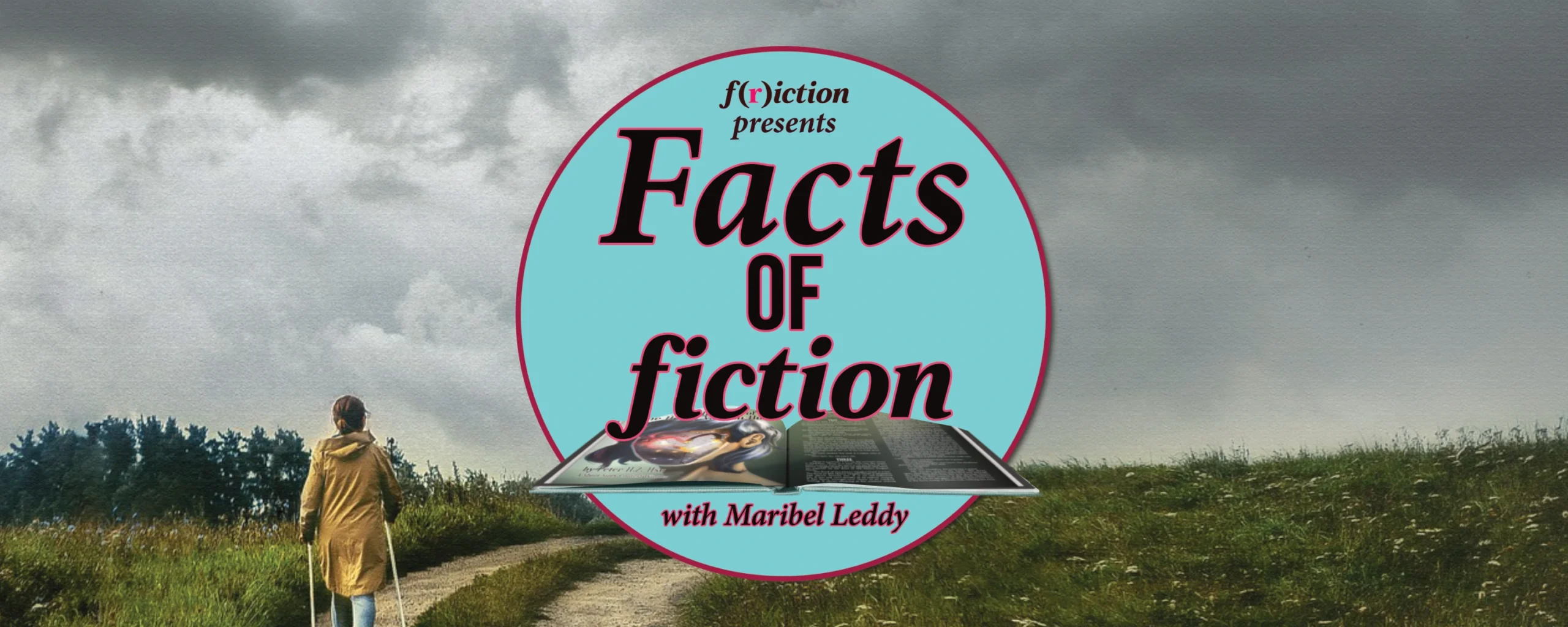
Explaining the Hero’s Journey
Words by maribel leddy, a deep dive into joseph campbell’s monomyth.
Since its publication in 1949, Joseph Campbell’s The Hero With A Thousand Faces has been a hugely influential work in the field of comparative mythology and storytelling. It explores the common patterns found in myths and legends across diverse cultures throughout history. And, most importantly, it introduces the concept of the “monomyth,” or the Hero’s Journey, a narrative structure that Campbell argues transcends cultural boundaries and forms the basis of many of the most compelling and foundational stories ever created.
The Hero With A Thousand Faces provides a comprehensive cross-cultural framework for understanding what makes a story a story. Its impact, particularly that of the monomyth, has shaped the way we perceive and create stories in literature, film, and beyond. In fact, after reading this article, you may find it difficult not to see the monomyth coloring stories all around you.
But why is the Hero’s Journey so important for storytelling? Anyone can write a story. But writing something that captures the attention of readers means knowing how to craft it in a way that will tug on their emotions and stay with them long after reading. The Hero’s Journey is one of the most important structures and tools we have for creating compelling stories. In this edition of Facts of Fiction, you’ll learn what it is, how to use it, and what narrative structures lie beyond.
The Hero’s Journey Demystified
The Hero’s Journey encapsulates a common narrative archetype, or story template, often used in storytelling, particularly from a Western perspective. In it, a hero first departs (or separates ) by going on adventure, is initiated into a new world, and then returns home.
In The Hobbit by J.R.R. Tolkein, for example, Gandalf calls upon Bilbo to join the dwarves of Thorin’s Company on a quest. Thus, Bilbo leaves his peaceful hobbit hole and finds himself on an adventure where he learns and struggles a great deal. Throughout the story, Bilbo gains a new level of maturity, competence, and wisdom—the skills he needs to secure his own kind of victory in ultimately leading to victories against the dragon Smaug, and at the Battle of Five Armies. Bilbo then returns to Bag End with some treasure and more stories, ultimately setting up for the beginning of Lord of the Rings in which Frodo also follows the call to adventure—once again led by Gandalf.
We see here the “nuclear unit” of the monomyth in its full form: separation, initiation, and return.
The first stage of the monomyth, also called the “departure,” has five stages wherein the hero:
- Receives the vocation to their journey , signifying that destiny—in the form of the “herald”—has summoned them. This may appear in the form of a problem or threat, or as a person, such as Gandalf in The Hobbit .
- Refuses the vocation , thus seeing for themselves the banality of their normal life. Campbell notes that “the refusal is essentially a refusal to give up what one takes to be one’s own interest.” In stories that take on the full Hero’s Journey, the hero always ultimately accepts the call.
- Receives unsuspected assistance from a supernatural force , usually a protective figure—often a little old crone or old man—who provides the adventurer with tools against the forces the hero is about to face.
- Crosses the first threshold , officially departing on their heroic journey.
- Enters the realm of the night , also known as the belly of the whale . Here, the hero faces the first of their trials and enters into the unknown. In fairytales, for example, this may be an ogre guarding a bridge that the hero must outwit, bribe, or use the tools granted by the supernatural aid to defeat.
The second stage of the monomyth details the trials and victories of initiation. Our hero must overcome great challenges to fully come into themself as a hero and a person. In this stage, the hero:
- Takes the road of trials , a series of ordeals they must survive in order to reach the next stage. These include trials that test them both physically and emotionally and serve as a means to help the character grow.
- Meets the “goddess,” in which the hero meets the allies who help them on their journey.
- Faces temptation to abandon their journey and must avoid it. Campbell also refers to this stage as “Woman as Temptress” but it signifies any kind of temptation leading the hero away from their fate.
- Atones with the father , or faces a major turning point in the story and discovers the ultimate reason for their journey. This may manifest in a face-off with a villain or a moment of internal doubt, or even a conflict with the herald who issued their quest.
- Reaches the highest point of development or apotheosis —the climax of the story wherein the hero learns how they will face the rest of the journey and gains knowledge that will help them continue.
- Confronts the ultimate boon , fulfilling the reason for their journey.
Finally, at the end of the hero’s journey, the hero must return home and reintegrate into society. During this time, the hero:
- Refuses the return , as they are reluctant to end the journey and return to the banality of real life.
- Goes on the magic flight , or is chased by those who would prevent them from returning home.
- Is rescued from without by an outside force or mentor who guides them home and rescues them from whoever is chasing them.
- Crosses the return threshold and returns to the world they lived in previously.
- Becomes the master of two worlds , learning how to balance the mundane world with the one discovered on the journey.
- Finds freedom to live . The hero acclimates back to their mundane life and lives peacefully.
In short, the Hero’s Journey is a common narrative archetype, or story template, in which a heroic character—the protagonist—goes on an adventure, learns a lesson, wins a victory, or victories, with that newfound knowledge, and returns home transformed.
Character Arcs and Turning Points
Perhaps the most important aspect of Campbell’s monomyth is how it serves as a classic structure to develop characters. Here at Brink and F(r)iction , we place a lot of value on character development and see the monomyth as one of the ideal ways to bring a character through a fully thought-out and satisfying character arc.
The Hero’s Journey as outlined above doesn’t have to be a physical journey. It doesn’t have to take the form of fantasy, as it does in The Hobbit or classic fairytales and myths. It can start with a character getting the call to adventure by accepting a new job or starting at a new school. It can be mundane and every day, but the point is that it changes the protagonist as a person, amplifying both their good traits and their flaws, and bringing them full circle emotionally, mentally, and sometimes spiritually as well.
A great example of the Hero’s Journey outside of genre fiction is Pride and Prejudice by Jane Austen. Our hero, Elizabeth Bennet, lives her ordinary life until she is “called to adventure” by the arrival of Mr. Darcy and Mr. Bingley. In this case, the adventure is love, and most of Elizabeth’s trials are internal. But ultimately, her story follows the structure of the monomyth and brings her to the full circle of “returning home,” only this time, it is her home with Mr. Darcy.
Most importantly to Elizabeth’s Hero’s Journey, however, is her overall character arc. The title Pride and Prejudice gives us a clue: is Elizabeth the prideful one or the prejudiced one? In the end, she is both, and the journey she takes leads her to growing as a person, shedding her pride and her prejudice, and finding love—the very thing she refused at the beginning of the novel.
The point of the character arc in the monomyth is that the hero changes. The stages of the Hero’s Journey amplify this change, unearthing the character’s greatest strengths and weaknesses and how they may use and overcome them, respectively. The transformative power of the Hero’s Journey for character is what makes it so compelling to readers. For example, think of how Aang in Avatar the Last Airbender changes over the course of the show. He goes from being a scared twelve-year-old boy who ran away from his problems (so effectively that he vanished for one hundred years) to accepting his purpose, overcoming his fears, and becoming the hero he was always meant to be.
Or, take “Amorpho & The Leering Freak,” a short story by Jason Baltazar, for example. The protagonist, Amorpho, begins the story feeling uncomfortable at being observed “like an ant under a magnifying glass” as he performs his set at a freak show. He hates being watched and lacks personal connection to most people. By the end of the story, Amorpho has come to accept his new roommate “The Leering Freak” as a friend and has even stood up for him, relishing in The Leering Freak’s watchful gaze.
The Monomyth in Action
Many famous stories adhere to the Hero’s Journey framework. You may begin to notice them all around you. The most popular examples include The Odyssey , Harry Potter , Lord of the Rings , Hunger Games , Star Wars: A New Hope , and many more. If you recognize and enjoy any of these stories, consider revisiting them and examining how they adhere to the monomyth. Or, pick one of your favorite stories and track it to see if it follows the monomyth’s structure. If it does, how? When does the hero get called to their journey? When do they enter the belly of the whale? How do they return home? If it doesn’t, what makes it different from the Hero’s Journey? What does the story do, or not do, that makes it a different narrative?
As outlined with Pride and Prejudice above, the Hero’s Journey is not only used in fantastical stories, but can also apply across genres. Filmmakers, writers, and storytellers all around the world constantly use the framework of the monomyth to create compelling stories that capture an audience and make us care about their characters and plots. Utilizing the monomyth is a sure way to create an engaging narrative, as it truly lends itself to rich character development, drama, and a strong ending that feels complete.
Alternatives to the Hero’s Journey
However, just because the Hero’s Journey is a popular framework for storytelling doesn’t mean it’s the only one out there. Alternative narrative structures, from the three-act structure to a classic tragedy to the anti-hero’s journey and more do exist.
The three-act structure divides a story into three parts, often called the setup, confrontation, and resolution. Films and screenplays often use this structure and it can feel very similar to the Hero’s Journey as it is also made up of three parts that mirror the separation, initiation, and return. However, in the case of the three-act structure, not all of the elements from the Hero’s Journey may be present. Examine classic movies like Jaws , Jurassic Park , and Titanic as prime examples of the three-act structure in action.
Classic tragedies tend to fall into five stages: anticipation, dream, frustration, nightmare, and destruction or death wish. In these stories, the tragic hero has a goal but ultimately fails to get what they want, and the result is complete undoing. In this way, a tragedy may reflect a Hero’s Journey but end in its opposite: the monsters win, the hero dies. Classic examples would be Shakespeare’s tragedies, such as Macbeth , Hamlet , and King Lear , but modern examples such as horror movies and organized crime films also often follow this structure.
Deviating From the Hero’s Journey
The Hero’s Journey provides a solid structure for telling a story that is recognizable across cultures and time. It has been amply analyzed and used to tell all kinds of stories for all kinds of characters. In this sense, the Hero’s Journey has pros and cons to using it as a writer. The pros are that you know it will result in a compelling story. The cons are that it may not feel original. Because of this, we don’t recommend viewing the monomyth as a paint-by-the-numbers template, but rather as a roadmap for sketching out a particular kind of story—one focused on a “hero” character who goes through an impactful change. In the end, storytellers can use what they like and change what they need to to tell their best version of their story.
Crafting Your Own Journey
It’s good practice to study and even create your own Hero’s Journey narrative if you plan to be a writer. Like with all skillsets, storytellers must first master the basics and fundamentals in order to refine and upgrade their craft. Try using the outline below to determine the course of your next story, no matter what world you set it in. Come up with a character who you envision embarking on the monomyth and see how your story develops from there. You may find it’s the easiest story you’ve ever written. You may struggle to differentiate it from others you have read. In the end, doing it for yourself is the best way to see how it serves as such a great formulation for a story—and how it can be adapted to suit many genres and themes.
Hero’s Journey Template
- Establish your hero and what their everyday life is like.
- Have your hero encounter an event, problem, or person that forces them outside of their comfort zone/everyday life.
- Make your hero reluctant to leave behind their everyday life to embark on the adventure.
- Have your hero meet with a mentor who will help them face the challenges ahead.
- Have your hero officially depart on their journey and fully commit to entering the new world.
- As your hero enters this new world, have them encounter obstacles, enemies, and allies to help them on their journey.
- Have your hero approach the place where they will encounter their greatest fear or biggest threat/foe.
- Have your hero confront whatever it is they were approaching above and overcome it.
- Provide your hero with a light at the end of the tunnel: some kind of tool, belief, or resource that they need to finish their journey.
- Take your hero on the journey home—but have them encounter more dangers along the way.
- Make your hero face a final test before getting a happy ending.
- Finally, have your hero return home, changed in some way and with some kind of prize—either an insight or physical object.
Once you have mastered—or at least played with—the Hero’s Journey, try other narrative structures. Experiment for yourself to see what suits your style of writing and your characters. If you find yourself getting stuck, or not liking where a structure is taking you, change it up. There are many diverse narratives to explore.
Think about your favorite short story, novel, movie, or series. What style of narrative does this work employ? Break it down into the “steps” of the Hero’s Journey as outlined above to get a better understanding of why and how it works as a story. An example you could use is Star Wars: A New Hope , which famously follows the Hero’s Journey very closely.
Beyond the Monomyth: Exploring Diverse Narratives
Non-traditional narratives include the circular narrative, parallel plotlines, or a story told from an unconventional perspective, or that plays with time.
In a circular narrative, for example, the story ends where it began. The characters still transform, but they return to the same place they began the story. While this may feel similar to the Hero’s Journey and, in some cases, a Hero’s Journey is cyclical, in a circular narrative the characters don’t necessarily go through all the trials and tribulations of the hero. A great example of circular narrative is One Hundred Years of Solitude by Gabriel Garcia Marquez.
In parallel structure, the story follows multiple storylines that are tied together through an event, character, or theme. Parallel narratives can be found everywhere throughout popular media, but a strong famous example would be “A Midsummer Night’s Dream” by Shakespeare. In this play, multiple plotlines take place at once: the love entanglement of Helena, Hermia, Lysander, and Demetrius; Titania and Oberon’s quarrel; the play being put on by Bottom and the other players; and the wedding of Theseus and Hippolyta. By the end of the play, these plotlines have connected and been resolved.
Another type of story is interactive in which the reader chooses their own adventure, and the choices they make determine how the story proceeds and what narrative it takes. Video games often use this to make a compelling game that may end poorly for the player if they don’t make the right choices. The next blog in this series takes you on a choose your own adventure that will determine a hero’s fate—and hopefully help exemplify the Hero’s Journey as well as these other narrative structures!
Non-Western Narratives
We must acknowledge that the Hero’s Journey and many of the other narratives discussed today largely come from a western understanding of storytelling and literature. Although Campbell brings up non-Western examples of folklore and stories in The Hero With A Thousand Faces , there is debate over whether his analysis truly applies. Narrative structures outside of Western influence do exist.
The East Asian four-act structure , for example, also called kishōtenketsu (Japanese), qǐchéngzhuǎnhé (Chinese), and gi seung jeon gyeol (Korean), is sometimes described as a “story without conflict.” This isn’t necessarily accurate, but it does pinpoint how this structure does not employ conflict to drive the story forward as it does in Western narrative structures. Instead, self-actualization, self-realization, and self-development drive the story. The four acts include the introduction, development, twist/turning point, and conclusion/result, although these can vary depending on the specific culture and story. Many popular manga, anime, K-dramas, and C-dramas utilize this story structure. Popular examples include the Studio Ghibli film Spirited Away , the Korean Movie Minari , and Nintendo’s Super Mario . Some argue that Pulp Fiction uses this structure and Michel He argues that BTS’s “Love Yourself” album trilogy also employs this.
Aside from East Asian four-act structure, Kim Yoonmi outlines multiple worldwide story structures that fall outside of the Hero’s Journey, including Bildungsroman (the coming of age story), Crick Crack or Kwik Kwak from the Caribbean Black community (a performance-based storytelling tradition that utilizes audience interaction), and Harawi from South America (storytelling through lyrical and other forms of poetry). We won’t go into every possible story structure here, but recognize their existence and that a story is a story whether or not it follows a structure we expect.
On Choosing A Story Structure
I encourage you to experiment with multiple story structures but to always keep in mind one thing: be purposeful. Whether you’re choosing to form a narrative around conflict, actively avoiding it, or doing something else entirely, make sure that whatever you choose lends itself to telling the story you are trying to tell. This will result in your best-told and most compelling story.
The Hero’s Journey, Joseph Campbell’s famous monomyth, can be broken down into its nuclear unit of separation, initiation, and return. The hero is called to adventure, must overcome trials and challenges, and returns home changed for the better. The most important aspect of this journey is the way the character develops over it. In storytelling, the characters will always be the most important part of the story as they are what keeps readers reading.
However, while the Hero’s Journey is a common and popular structure, it is not the only one out there. It can be used and adapted as the storyteller wishes for the sake of the story. As you write your own stories, explore multiple narrative structures and see what lends itself to telling your story the best way possible.
In the end, Joseph Campbell’s work, The Hero With A Thousand Faces , has changed forever how we view and analyze literature. It has framed the way we see heroes and the journeys they face. This work has left an indelible mark on storytelling and continues to be an important part of learning how to tell great, compelling stories. After doing the exercise above, consider submitting your own take on the monomyth to F(r)iction and continue revisiting this series to learn more about the fundamentals of storytelling!
Author’s Note: It’s worth pointing out that The Hero With A Thousand Faces does not just detail the Hero’s Journey that we have discussed in depth today. Although Campbell’s major argument and the majority of the work is dedicated to the monomyth and its role in storytelling, he also connects this to psychology in ways that we don’t often acknowledge or discuss today. This is in part because these connections don’t help us tell better stories. It is also because Campbell intertwines them with the Freudian take on human psychology in a way that is often rejected today for lacking evidence and considered a pseudoscience. To learn more about this, I encourage you to read The Hero With A Thousand Faces and check out this article . That said, the monomyth is still important to study when learning how to create stories and, importantly, how to write compelling character arcs.
Maribel Leddy
Maribel Leddy is a passionate writer, editor, and creative content strategist based in New York, New York. She graduated from Johns Hopkins University with a B.A. in Writing Seminars and has been with Brink since 2018. With experience in writing professionally for over five years now, Maribel enjoys crafting engaging, thoughtful, and well-researched content across a variety of topics and industries. For fiction writing, her favorite genres are science fiction and fantasy. She currently lives with her sister and their two cats, Cleo and Chai.
Image by Adam Tumidajewicz from Pixabay
Recent Posts
- A Review of Coup de Grace by Sofia Ajram
- A Review of Divine Mortals by Amanda M. Helander
- July Staff Picks
- The Writer’s Downfall: Exposition 101
- A Review of Apastoral: A Mistopia by Lee Thompson
- Contest Winners
- Creative Nonfiction
- Dually Noted
- Facts of Fiction
- Flash Fiction
- Literary Horoscopes
- Read-alongs
- Short Story
- Staff Picks
- Editor's Note
- Uncategorized
VIDEO COURSE
Finish your draft in our 3-month master class. Sign up now to watch a free lesson!
Learn How to Write a Novel
Finish your draft in our 3-month master class. Enroll now for daily lessons, weekly critique, and live events. Your first lesson is free!

Guides • Perfecting your Craft
Last updated on Nov 22, 2023
Story Structure: 7 Types All Writers Should Know
About the author.
Reedsy's editorial team is a diverse group of industry experts devoted to helping authors write and publish beautiful books.
About Martin Cavannagh
Head of Content at Reedsy, Martin has spent over eight years helping writers turn their ambitions into reality. As a voice in the indie publishing space, he has written for a number of outlets and spoken at conferences, including the 2024 Writers Summit at the London Book Fair.
Nothing makes the challenging task of crafting your first book feel more attainable than adopting a story structure to help you plot your narrative.
While using a pre-existing blueprint might make you worry about ending up with a formulaic, predictable story, you can probably analyze most of your favorite books using various narrative structures that writers have been using for decades (if not centuries)!
This post will reveal seven distinct story structures that any writer can use to build a compelling narrative. But first…
What is story structure?
Story structure is the order in which plot events are told to the reader or audience . While stories can be told in a wide variety of ways, most Western story structures commonly share certain elements: exposition, rising action, climax, falling action, and resolution.
A tightly controlled structure will answer a reader's questions, provide a climax followed by resolution and information at the end of the story, further the characters’ development, and unravel any central conflicts. In other words, it's responsible for a satisfying narrative experience that accomplishes the author’s aims.
Writing is an art, but if there’s one part of the craft that’s closer to science, this would be it. Become a master of story structure, and you will have the world at your feet.

Classic story structure
When people discuss different story structures, they often talk about the different frameworks used to analyze stories. When you boil them all down, all stories have certain shared elements.
Elements of classic story structure:
- Exposition. This first part establishes a protagonist's normal life and greater desires, and usually culminates in the inciting incident.
- Rising action. The protagonist pursues their new goal and is tested along the way.
- Climax. Our hero achieves their goal — or so they think!
- Falling action. The hero now must deal with the consequences of achieving their goal.
- Resolution. The conclusion tying together the plot, character arcs, and themes.
These are all common ‘ beats ’ to most stories. It can be easier to see these moments in genres with higher stakes (such as a military thriller), but you’ll find them in almost any type of story.
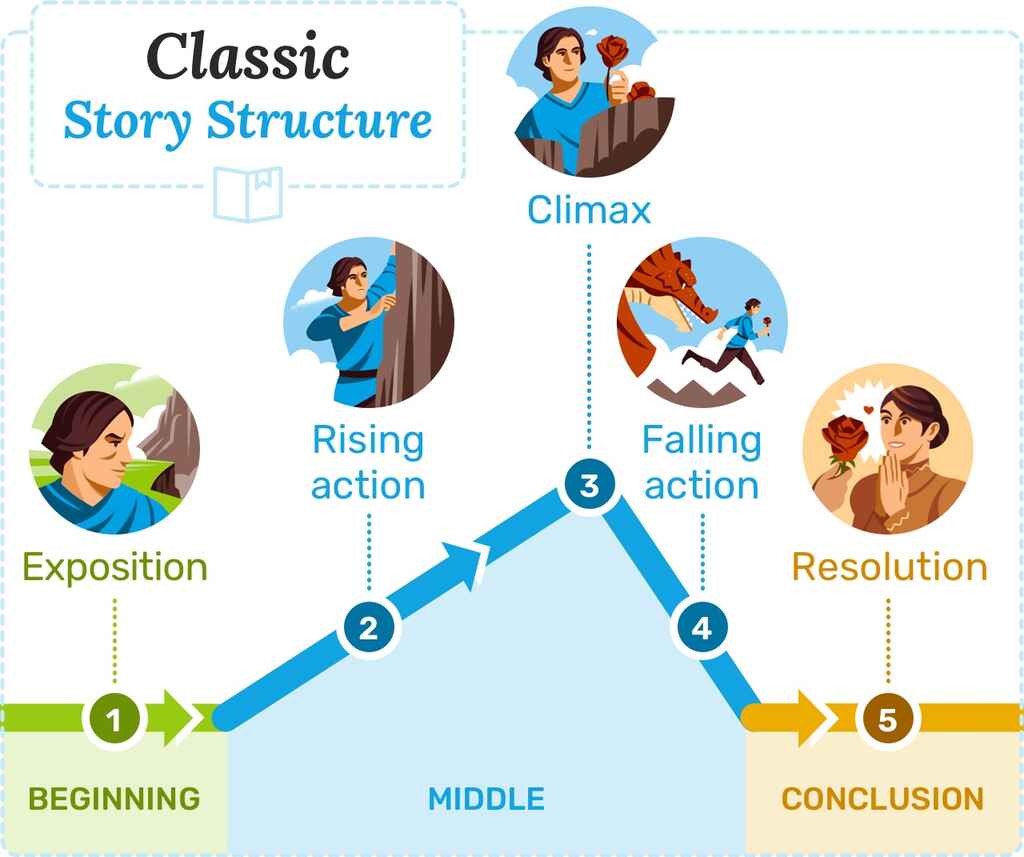
GET ACCOUNTABILITY
Meet writing coaches on Reedsy
Industry insiders can help you hone your craft, finish your draft, and get published.
Seven Story Structures Every Writer Should Know
Now that we’ve established the most essential components of story, let’s look at seven of the most popular story structures used by writers — and how they deploy these components:
- Freytag's Pyramid
- The Hero's Journey
- Three Act Structure
- Dan Harmon's Story Circle
- Fichtean Curve
- Save the Cat Beat Sheet
- Seven-Point Story Structure
1. Freytag’s Pyramid
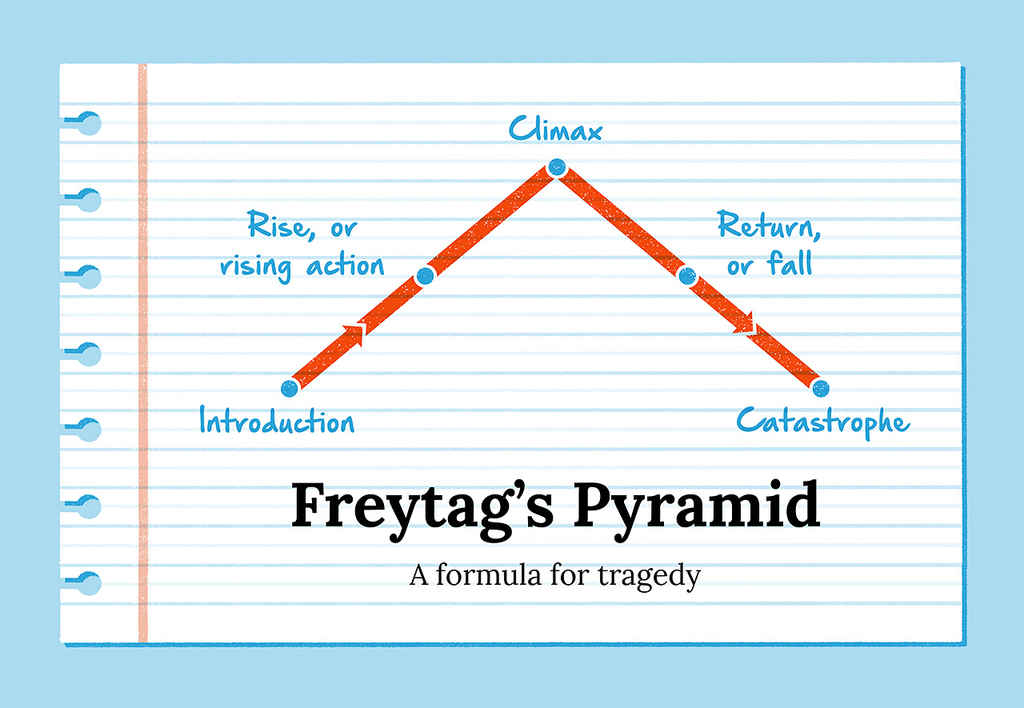
- Introduction. The status quo is established; an inciting incident occurs.
- Rise, or rising action. The protagonist actively pursues their goal. The stakes heighten.
- Climax. A point of no return, from which the protagonist can no longer go back to the status quo.
- Return, or fall. In the aftermath of the climax, tension builds, and the story heads inevitably towards...
- Catastrophe. The protagonist is brought to their lowest point. Their greatest fears have come true.
This structural model is less frequently used in modern storytelling, partly due to readers’ limited appetite for tragic narratives (although you can still spot a few tragic heroes in popular literature today). By and large, commercial fiction, films, and television will see a protagonist overcome their obstacles to find some small measure of success. That said, it’s still useful to understand the Pyramid as a foundational structure in Western literature — and you will still see it occasionally in the most depressing contemporary tales.
To learn more, read our full guide on Freytag’s Pyramid here .
If you struggle to structure a novel, sign up for our How to Write a Novel course to finish a novel in just 3 months.

NEW REEDSY COURSE
How to Write a Novel
Enroll in our course and become an author in three months.
2. The Hero’s Journey

Campbell’s original structure uses terminology that lends itself well to epic tales of bravery and triumph — with plot points like “Belly of the Whale,” “Woman as the Temptress,” and “The Magic Flight.” To make The Hero’s Journey more accessible, Disney executive Christopher Vogler created a simplified version that has become popular amongst mainstream storytellers.
Here, we’ll look at Vogler’s streamlined, 12-step version of The Hero’s Journey.
- The Ordinary World. The hero’s everyday life is established.
- The Call of Adventure. Otherwise known as the inciting incident.
- Refusal of the Call. For a moment, the hero is reluctant to take on the challenge.
- Meeting the Mentor. Our hero meets someone who prepares them for what lies ahead — perhaps a parental figure, a teacher, a wizard, or a wise hermit.
- Crossing the First Threshold. The hero steps out of their comfort zone and enters a ‘new world.’
- Tests, Allies, Enemies. Our protagonist faces new challenges — and maybe picks up some new friends. Think of Dorothy on the Yellow Brick Road.
- Approach to the Inmost Cave. The hero gets close to their goal. Luke Skywalker reaches the Death Star.
- The Ordeal. The hero meets (and overcomes) their greatest challenge yet.
- Reward (Seizing the Sword). The hero obtains something important they were after, and victory is in sight.
- The Road Back. The hero realizes that achieving their goal is not the final hurdle. In fact, ‘seizing the sword’ may have made things worse for them.
- Resurrection. The hero faces their final challenge — a climactic test that hinges on everything they’ve learned over their journey.
- Return with the Elixir. Having triumphed, our protagonist returns to their old life. Dorothy returns to Kansas; Iron Man holds a press conference to blow his own trumpet .
While Vogler’s simplified steps still retain some of Campbell’s mythological language with its references to swords and elixirs, the framework can be applied to almost any genre of fiction. To see how a ‘realistic’ story can adhere to this structure, check out our guide to the hero’s journey in which we analyze Rocky through this very lens.

FREE OUTLINING APP
Reedsy Studio
Use the Boards feature to plan, organize, or research anything.
3. Three Act Structure
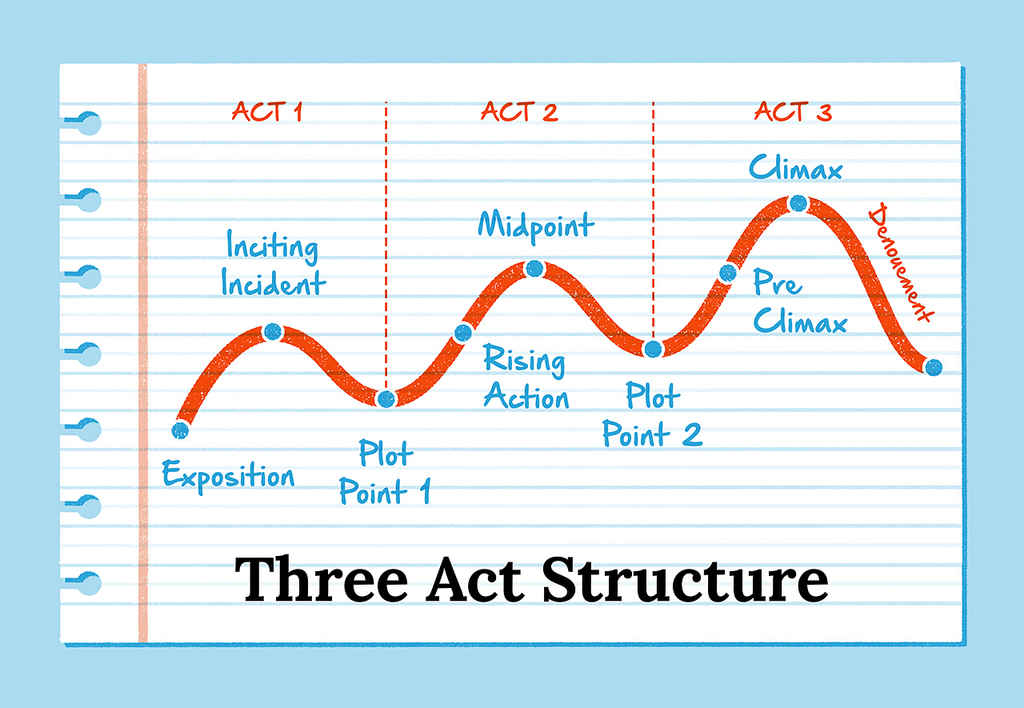
Act 1: Setup
- Exposition . The status quo or ‘ordinary world’ is established.
- Inciting Incident. An event that sets the story in motion.
- Plot Point One. The protagonist decides to tackle the challenge head-on. She ‘crosses the threshold,’ and the story is now truly moving.
Act 2: Confrontation
- Rising Action. The story's true stakes become clear; our hero grows familiar with her ‘new world’ and has her first encounters with some enemies and allies. (see Tests, Allies, Enemies)
- Midpoint. An event that upends the protagonist’s mission. (Similar to the climax in Freytag’s pyramid)
- Plot Point Two. In the wake of the disorienting midpoint, the protagonist is tested — and fails. Her ability to succeed is now in doubt.
Act 3: Resolution
- Pre Climax. The night is darkest before dawn. The protagonist must pull herself together and choose between decisive action and failure.
- Climax. She faces off against her antagonist one last time. Will she prevail?
- Denouement. All loose ends are tied up. The reader discovers the consequences of the climax. A new status quo is established.
When we speak about a confrontation with an antagonist, this doesn’t always mean a fight to the death. In some cases, the antagonist might be a love rival, a business competitor, or merely an internal or environmental conflict that our protagonist has been struggling with the entire story.
If you’re interested in using this model to plot your own story, read our guide to the three-act structure , and be sure to sign up to our free course on the subject.

FREE COURSE
How to Plot a Novel in Three Acts
In 10 days, learn how to plot a novel that keeps readers hooked
4. Dan Harmon's Story Circle
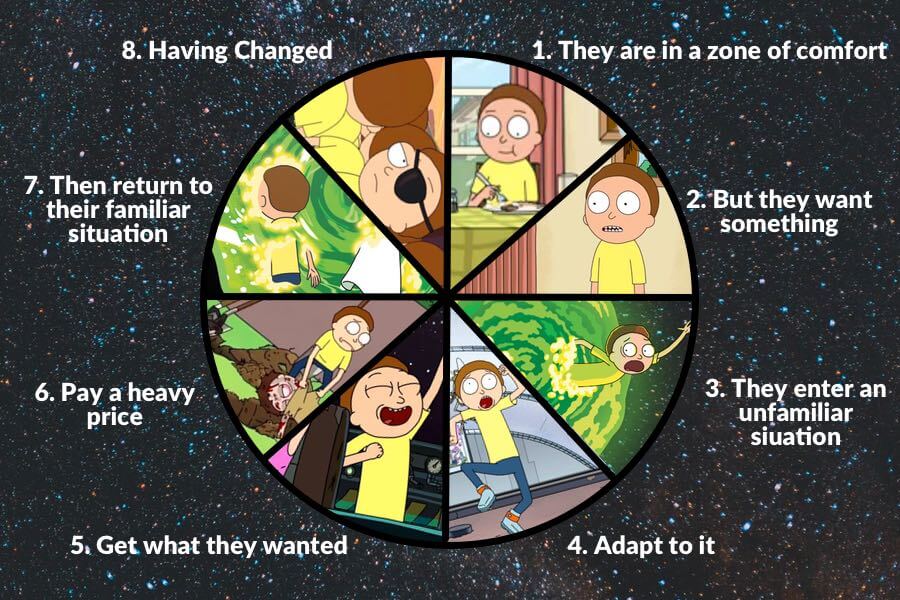
Another variation on Campbell’s monomyth structure, the Story Circle is an approach developed by Rick and Morty co-creator Dan Harmon. Again, heavily inspired by the Hero's Journey, the benefit of Harmon's approach is its focus on the protagonist's character arc. Instead of referring to abstract concepts like 'story midpoint' and 'denouement', each beat in the story circle forces the writer to think about the character's wants and needs.
- A character is in a zone of comfort... This is the establishment of the status quo.
- But they want something... This 'want' could be something long-standing and brought to the fore by an inciting incident.
- They enter an unfamiliar situation... The protagonist must do something new in their pursuit of the thing they want.
- Adapt to it... Faced with some challenges, they struggle then begin to succeed.
- Get what they wanted... Usually a false victory.
- Pay a heavy price for it... They realize that what they 'wanted' wasn't what they 'needed'.
- Then return to their familiar situation... armed with a new truth.
- Having changed... For better or worse.
Created by a writer whose chosen medium is the 30-minute sitcom, this structure is worded in a way that sidesteps the need for a protagonist to undergo life-changing transformations with each story. After all, for a comedy to continue for six seasons (and a movie) its characters can't completely transform at the end of each episode. They can, however, learn small truths about themselves and the world around them — which, like all humans, they can quickly forget about if next week's episode calls for it.
To learn more and see this structure applied to an episode of Rick and Morty, check out our full post on Dan Harmon's Story Circle .
Side note: for this kind of character-driven plot (and, indeed, for all of these structures), you're going to want to know you're protagonist inside and out. Why not check out some of our character development exercises for help fleshing your characters out, like the profile template below.

FREE RESOURCE
Reedsy’s Character Profile Template
A story is only as strong as its characters. Fill this out to develop yours.
5. Fichtean Curve
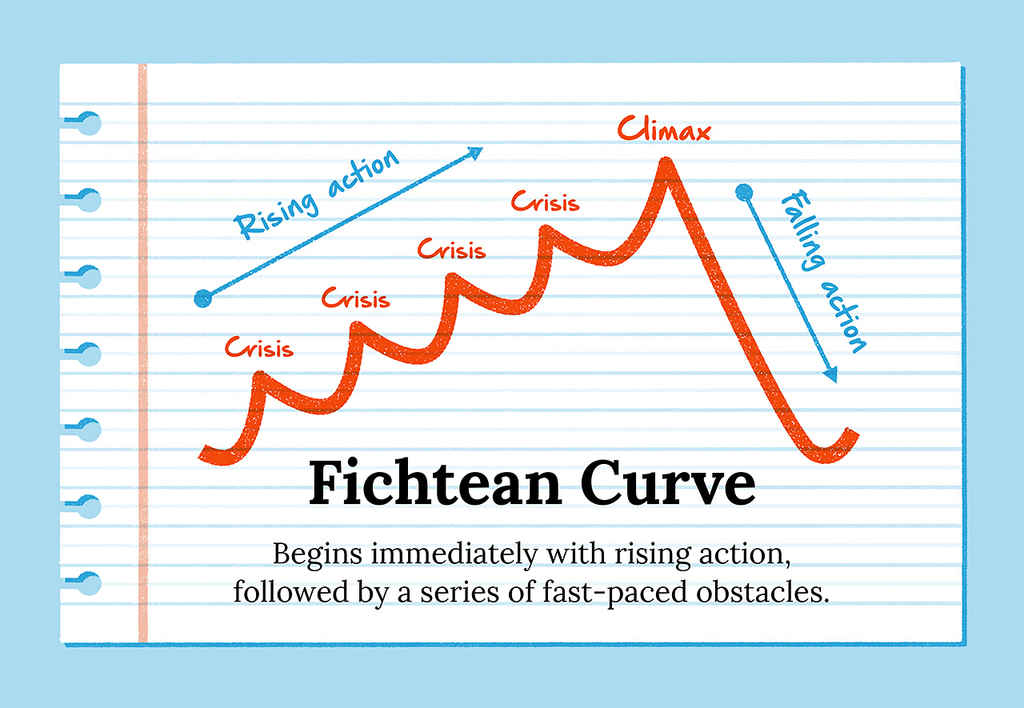
Fleshed out in John Gardner’s The Art of Fiction , the Fichtean Curve is a narrative structure that puts our main characters through a series of many obstacles on their way to achieving their overarching goals. Resembling Freytag’s Pyramid, it encourages authors to write narratives packed with tension and mini-crises that keep readers eager to reach the climax.
Bypassing the “ordinary world” setup of many other structures, the Fichtean Curve starts with the inciting incident and goes straight into the rising action. Multiple crises occur, each of which contributes to the readers’ overall understanding of the narrative — replacing the need for the initial exposition.
To discuss this unusual structure, it’s perhaps best to see it in use. We’ll use Celeste Ng’s Everything I Never Told You as an example. Needless to say, spoilers ahead.
Rising Action
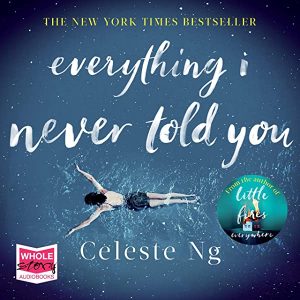
- First crisis. Lydia’s family is informed her body was found in a nearby lake. From this first crisis's climax, the narrative flashes back to provide exposition and details of the family’s history.
- Second crisis. In flashbacks, we discover that, 11 years prior, Marilyn abandoned her family to resume her undergraduate studies. In her absence, the family begins to fall apart. Marilyn learns she is pregnant and is forced to return home. Having lost her opportunity for further education, she places the pressure of academic success on her children.
- Third crisis. Back in the present, Lydia’s father, James, is cheating on Marilyn. The police decide to close the investigation, ruling Lydia’s death a suicide. This results in a massive argument between her parents, and James leaves to stay with the “other woman.”
- Fourth crisis. Flashback to the day Lydia died. From her perspective, we see that she’s misunderstood by her parents. She mourns her brother’s impending departure for college, leaving her as the sole focus of her parents’ pressure. Isolated, she tries to seduce a friend — who rejects her advances and explains he’s in love with her brother.
- Lydia takes a boat into the lake in the middle of the night — determined to overcome her fear of water and reclaim control of her life. Lydia jumps off the boat, into the water, and out of this life. As in a classical tragedy, this moment is both devastating and inevitable.
Falling Action
- Some level of resolution is achieved, and readers get to at least glimpse the “new norm” for the characters. Lydia’s family lean on one another in their grief. While they may never be able to make their amends with Lydia, they can learn from her death. Not all of the loose ends are tied off, but readers infer the family is on the long road to recovery.
Note: In the rising action stage, all of the crises should build tension towards — and correspond with — the story’s major climax. Like the three-act narrative structure, the Fichtean Curve’s climax typically occurs two-thirds through the book.
While this structure lends itself well to flashback-heavy novels such as Everything I Never Told You, it is also incredibly common in theatre. In stage plays like The Cherry Orchard and A Doll’s House , the action takes place in a fixed time and place, but backstory and character development are revealed through moments of high drama that occur before the audience’s eyes.
For a deeper look at this structure, head to our full post on the Fichtean Curve .
6. Save the Cat Beat Sheet
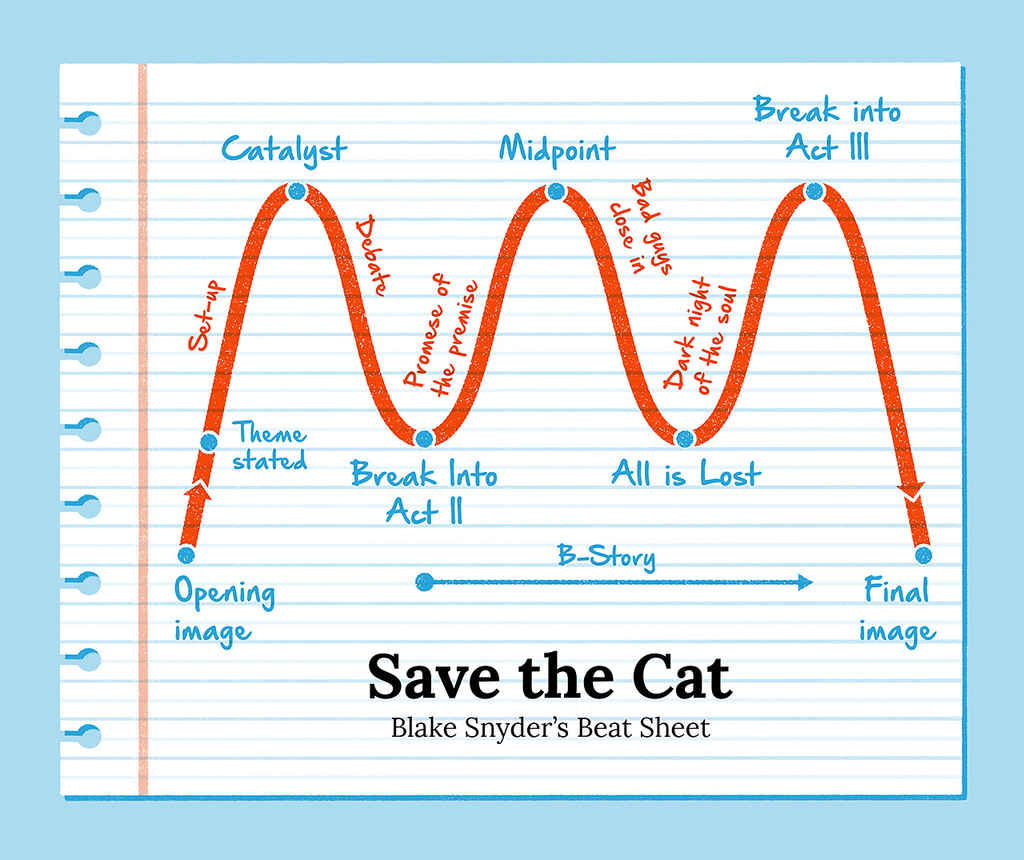
Another variation of the three-act structure, this framework created by Hollywood screenwriter Blake Snyder, has been widely championed by storytellers across many media forms.
Fun fact: Save the Cat is named for a moment in the set up of a story (usually a film) where our hero does something to endear himself to the audience.
While many structures are reluctant to prescribe exactly when in a story the various beats should take place, Snyder and Save the Cat have no such qualms. The number in the square brackets below refers to the page that the beat should take place — assuming you’re writing a 110-page screenplay.
- Opening Image [1]. The first shot of the film. If you’re starting a novel , this would be an opening paragraph or scene that sucks readers into the world of your story.
- Set-up [1-10]. Establishing the ‘ordinary world’ of your protagonist. What does he want? What is he missing out on?
- Theme Stated [5]. During the setup, hint at what your story is really about — the truth that your protagonist will discover by the end.
- Catalyst [12]. The inciting incident!
- Debate [12-25]. The hero refuses the call to adventure. He tries to avoid the conflict before they are forced into action.
- Break into Two [25]. The protagonist makes an active choice and the journey begins in earnest.
- B Story [30]. A subplot kicks in. Often romantic in nature, the protagonist’s subplot should serve to highlight the theme.
- The Promise of the Premise [30-55]. Often called the ‘fun and games’ stage, this is usually a highly entertaining section where the writer delivers the goods. If you promised an exciting detective story, we’d see the detective in action. If you promised a goofy story of people falling in love, let’s go on some charmingly awkward dates.
- Midpoint [55]. A plot twist occurs that ups the stakes and makes the hero’s goal harder to achieve — or makes them focus on a new, more important goal.
- Bad Guys Close In [55-75]. The tension ratchets up. The hero’s obstacles become greater, his plan falls apart, and he is on the back foot.
- All is Lost [75]. The hero hits rock bottom. He loses everything he’s gained so far, and things are looking bleak. The hero is overpowered by the villain; a mentor dies; our lovebirds have an argument and break up.
- Dark Night of the Soul [75-85-ish]. Having just lost everything, the hero shambles around the city in a minor-key musical montage before discovering some “new information” that reveals exactly what he needs to do if he wants to take another crack at success. (This new information is often delivered through the B-Story)
- Break into Three [85]. Armed with this new information, our protagonist decides to try once more!
- Finale [85-110]. The hero confronts the antagonist or whatever the source of the primary conflict is. The truth that eluded him at the start of the story (established in step three and accentuated by the B Story) is now clear, allowing him to resolve their story.
- Final Image [110]. A final moment or scene that crystallizes how the character has changed. It’s a reflection, in some way, of the opening image.
Some writers may find this structure too prescriptive, but it’s incredible to see how many mainstream stories seem to adhere to it — either by design or coincidence. Over on the Save the Cat website, there are countless examples of films and novels analyzed with Snyder’s 15 beats . You’ll be surprised how accurate some of the timings are for each of the beats.
For a deeper dive into this framework, and to watch this video where Reedsy’s Shaelin plots out a Middle-Grade fantasy novel using Snyder’s method — head to our full post on the Save the Cat Beat Sheet .
7. Seven-Point Story Structure
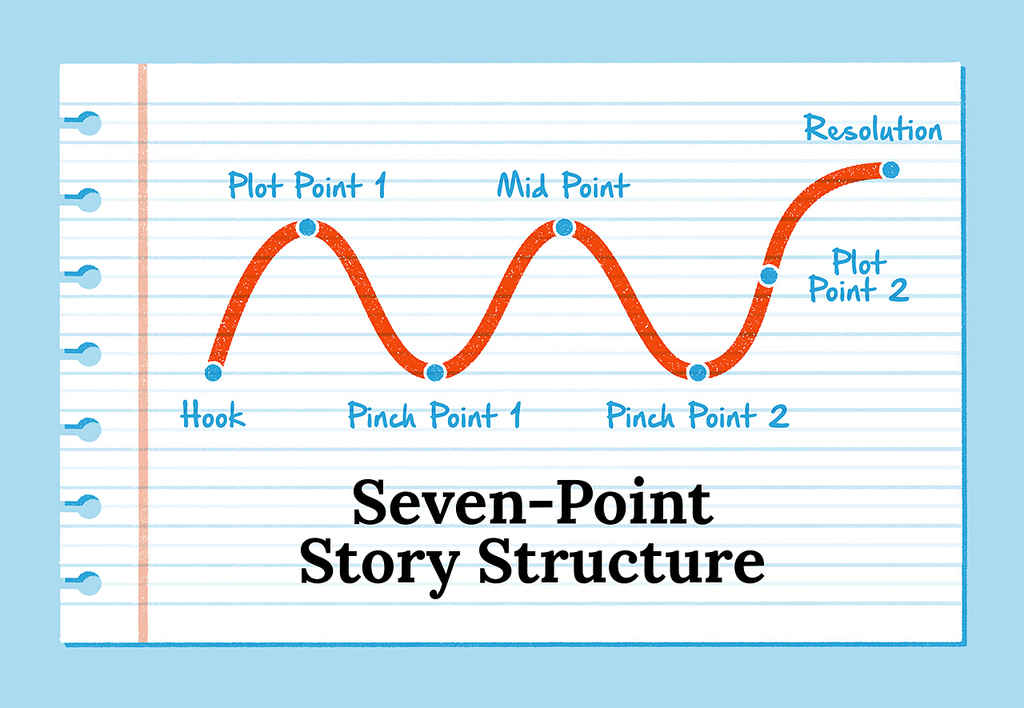
A slightly less detailed adaptation of The Hero’s Journey, the Seven-Point Story Structure focuses specifically on the highs and lows of a narrative arc .
According to author Dan Wells, who developed the Seven-Point Story Structure , writers are encouraged to start at the end, with the resolution, and work their way back to the starting point: the hook. With the ending in mind, they can have their protagonist and plot begin in a state that best contrasts the finale — since this structure is all about dramatic changes from beginning to end.
- The Hook. Draw readers in by explaining the protagonist’s current situation. Their state of being at the beginning of the novel should be in direct contrast to what it will be at the end of the novel.
- Plot Point 1. Whether it’s a person, an idea, an inciting incident, or something else — there should be a "Call to Adventure" of sorts that sets the narrative and character development in motion.
- Pinch Point 1. Things can’t be all sunshine and roses for your protagonist. Something should go wrong here that applies pressure to the main character, forcing them to step up and solve the problem.
- Midpoint. A “Turning Point” wherein the main character changes from a passive force to an active force in the story. Whatever the narrative’s main conflict is, the protagonist decides to start meeting it head-on.
- Pinch Point 2. The second pinch point involves another blow to the protagonist — things go even more awry than they did during the first pinch point. This might involve the passing of a mentor, the failure of a plan, the reveal of a traitor, etc.
- Plot Point 2. After the calamity of Pinch Point 2, the protagonist learns that they’ve actually had the key to solving the conflict the whole time.
- Resolution. The story’s primary conflict is resolved — and the character goes through the final bit of development necessary to transform them from who they were at the start of the novel.
For a deeper look into Wells's approach — including the key to using it — check out our full post on the seven-point story structure .
We've said it before, and we'll say it again: story structures aren't an exact science, and you should feel welcome to stray from the path they present. They're simply there to help you find your narrative's footing — a blueprint for the world you're about to start building.
Join a community of over 1 million authors
Reedsy is more than just a blog. Become a member today to discover how we can help you publish a beautiful book.
Bring your stories to life
Our free writing app lets you set writing goals and track your progress, so you can finally write that book!

1 million authors trust the professionals on Reedsy. Come meet them.
Enter your email or get started with a social account:

- Ask LitCharts AI
- Discussion Question Generator
- Essay Prompt Generator
- Quiz Question Generator

- Literature Guides
- Poetry Guides
- Shakespeare Translations
- Literary Terms
Patricia Grace

Ask LitCharts AI: The answer to your questions
- Quizzes, saving guides, requests, plus so much more.
Home » Finding The Stories that Shape Your Journey Through Life
FINDING YOUR LEGACY STORIES: Harvesting the Stories from Your Journey Through Life
6-week storytelling course, january 9 - february 6, 2024, tuesdays, 11am - 1pm pst, registrations open until monday 15th january, discover finding the stories that shape your journey through life.
Over the course of six Tuesdays each of us will discover and share those tales that transform a lifetime of experiences into a journey. Joel will guide us on this journey through stories, of course, as well as through a series fun and interactive exercises that will draw forth the story material lurking just below the surface of our conscious minds.
Focusing on specific storytelling techniques and journey templates, we will craft what we find into tales of our journey. Between classes students will have the opportunity to connect with story buddies from the class to share their stories in progress based on prompts from the class. By the end of the class each student will have a much clearer perspective on what their journey through life is all about.
This course is for you if:
- You wish to discover just how rich your life is in stories.
- You want more magic in your life.
- You sometimes find yourself wondering what it all means and how it all fits together.
Watch a Free Masterclass from Joel ben Izzy
"going to the well to discover our stories".
In this course, you will experience:
- Embark on a profound journey of self-discovery with our course , “Legacy Stories,” where you’ll gain a nuanced understanding of the threads that weave through the narrative of your life. This transformative experience equips you with invaluable techniques for unearthing, crafting, and eloquently sharing the stories that define you.
- Delve into pathways that seamlessly guide you from the routines of daily life into the enchanting realm of storytelling, revealing narratives you never knew you possessed. Witness the magic of discovering stories within you, stories waiting to be acknowledged and shared.
- Experience the transcendent joy of finding meaning in your life by viewing it as a cohesive and purposeful story. “Legacy Stories” empowers you with a clearer understanding of your unique storytelling voice—a skill applicable not just to those interested in writing, but to anyone seeking to express their narrative authentically.
- While the course doesn’t focus solely on writing, it serves as a valuable resource for those wishing to articulate their stories in written form, aiding in the cultivation of a distinctive writing voice.
- Immerse yourself in a community of kindred spirits, fostering connections with fellow students on similar journeys. “Legacy Stories” is more than a course; it’s a shared expedition into the art of storytelling, where meaningful connections enrich the tapestry of your experience. Join us, and learn how to create stories that resonate with newfound clarity and purpose.
- Come prepared to have a lot of fun
“I am writing a book for young adults on the intergenerational legacy of the Holocaust, based on my mother’s stories of her survival. I reached out to Joel for assistance with distilling, shaping and pacing the telling of memories and discoveries, both my mother’s and my own. It is quite a journey for me, and Joel is both a companion and a guide. He listens carefully, reflects back wisely, and suggests and supports with a full heart and a creative mind.” Judy
“Joel is a knowledgeable, compassionate and wise storytelling coach and teacher. Using prompts, tutelage and gentle guidance he has helped me unearth stories that were so deeply buried I didn’t know they existed. These recaptured memories and the glue I call love have allowed me to build tales of family that speak of violence, alcoholism, abandonment, courage, grace, humor, kindness and wisdom…and to tie these tales to who I am and how I got here. I am particularly grateful when people, on hearing my stories, say thank you…I’ve been there too.” Gerry
“Working with Joel has helped me discover recurring themes in my life.... The work we did on my post-divorce years led me to see how much fun I had in spite of traumatic heartbreaks... I used to see those times as sad and embarrassing, but now I see them as adventures and living my life to its fullest - I wouldn't change a thing.” Claire
A story has no beginning or end: arbitrarily one chooses that moment of experience from which to look back or from which to look ahead. ~Graham Greene
Your guide — joel ben izzy.
It was four decades ago that Joel ben Izzy set off to travel the globe, gathering and telling stories. Since then, he has told and taught storytelling in some thirty-six countries throughout the Americas, Europe, the Middle East, Asia, and has recently returned from a series of presentations and workshops in Kigali, Rwanda, working with young people from throughout North Africa. Joel has also produced a series of six award-winning recordings and is the author of “The Beggar King and the Secret of Happiness” (Algonquin, 2003), which has now been published in eighteen languages. A memoir woven together by stories from his travels, it recounts the remarkable journey that began when Joel awoke from a surgical procedure to discover he could no longer speak, sending Joel tumbling headlong into a story as wild as any he had ever told. Since his return from that, he has a passion for helping people harvest the stories from their own lives, giving shape to their journey – which is what we’ll be doing in this class.
Joel has coached CEOs in New York skyscrapers to training women entrepreneurs in the hills of Rwanda, from work with thought leaders at a Washington, D.C. think tank to high-tech cancer researchers in South San Francisco, and from Hollywood movie studios to coffee farmers in Chiapas.
Finding the Stories That Shape Your Journey Through Life $350
6 weeks (january 9 – february 6, 2024) tuesdays, 11am – 1pm pacific time registrations open until monday 15th january, this storytelling course includes:.
- “Ah-ha!” moments that come from discovering treasures hidden in plain sight
- Pathways that lead through the mundane to the magical
- New ways to hold the stories of your lives, making your journeys that much more rich and meaningful
- 6 live, interactive class sessions on Zoom (12 hours)
- Access to an exclusive online community platform
- Small groups to work with outside of class
- Recordings of all classes (permanent access)
- Coaching and skill building
- Join a community of conscious creators
Join us and…
- Unveil Your Ancestral Tapestry : Dive deep into the rich tapestry of your heritage, unlocking the secrets and timeless lessons embedded in your family’s legacy. Discover the untold stories that have shaped you, and harness their strength to propel you forward.
- Craft Your Narrative with Purpose: Learn the art of sacred storytelling as you mold your experiences into a narrative that resonates with authenticity and meaning. Through guided exercises and expert insights, we’ll help you unearth the gems within your personal history and illuminate the path toward a legacy that reflects your true essence.
- Cultivate Connection and Healing: Experience the profound healing that comes from embracing and sharing your legacy stories. Connect with fellow storytellers in a supportive community, fostering a sense of belonging and understanding that transcends time and space.
- Illuminate Your Path Forward: As you delve into the timeless narratives of your ancestors, you’ll find clarity and purpose for your own journey. “Legacy Stories” isn’t just a course; it’s a roadmap to guide you toward a future grounded in the strength of your roots.
- Embark on this sacred storytelling adventure and leave a legacy that resonates for generations to come. Join “Legacy Stories” now and step into the transformative power of your own narrative. Your story is not just yours—it’s a beacon that lights the way for others.
Inside each of us is a natural-born storyteller, waiting to be released. ~Robin Moore
Receive more stories, and join the sacred storytelling community.
© 2023 School for Sacred Storytelling.
- Recipe Book for Creative Prompts
- The Alchemy of Story
- Upcoming Classes
- Free Masterclass
I kept noticing how many incredibly talented and gifted people around me are forging new paths, and how much energy it takes to initiate projects, how much energy it takes to be at the front and leading a project, and how much energy it takes to complete a project. And we simply can’t do it alone.
And then there is this: We are living in quickly changing times; scarcity and fear are filling the airwaves, and the people around us. It is simply harder to find people who know how to support people like us: creatives, dreamers, imaginaries…we see something that hasn’t been created yet…and feel compelled to do it.
As someone who has brought many projects to the finish line, and grieved those that died before making it to the finish line, I have intimate lived experience of what it takes to bring a vision to fruition, and that this is an initiatory process.
Now I’m going to share part of my bio in 3rd person because sometimes it’s just easier that way:
Leah’s commitment to the environment has been expressed as an ocean advocate, writing and producing award winning PSA’s on taking action to protect our planet, consulting on communications for The Pachamama Alliance, giving activists a voice in the media while hosting the green channel at Al Gore’s Television Network, covering the UN Climate Talks in Paris, and was the Arts consultant to the National Coalition for Dialogue & Deliberation.
Her commitment to working with story as a tool for social change was developed while working with Active Voice, where she developed the strategies and implemented engagement campaigns led by The Fetzer Foundation and Participant Productions.
A lifelong learner, she has studied with many of the great storytellers of our time including Martin Shaw, Caroline Casey, and attended The 13 Moon Mystery School and The Orphan Wisdom School. Her greatest teacher of story has been a long tale called The Whale Dreamer, her commitment to this story has taken her to the edges of the earth and back.
Her writing has been featured in Fast Company, Spirituality & Health Magazine, and National Geographic News Watch. She has spoken about and taught about storytelling as a sacred art at Google, Hollyhock, a variety of retreats, and continues to produce storytelling events and tour Story Ceremonies across the country.
Official websites use .gov
Secure .gov websites use HTTPS
Soldier's Journey to All-Army Women's Softball Roster Is Shaped by Talent, Grit
It would be impossible to perform the way Army Sgt. Melina Wilkinson has at this year's Armed Forces Softball Championship without being both extraordinarily talented and tough as nails.
Before the competition officially kicked off at Oklahoma City's Devon Field last week, Wilkinson and teammate Capt. Katherine Ontiveros ripped a combined 23 home runs over the fence to lead the Army's women's team to victory in a home run derby and start the week of competition.

Wilkinson hit another one over the fence four days later in a critical match against Air Force to help Army clinch the top seed in a final series to determine who would claim this year's title. This time, she did so with four stitches in her lip from an injury she sustained just hours before.
Off the field, Wilkinson carries herself with the understated confidence of the soldier and natural leader she is. She walks with a subtle swagger fitting of an athlete who has competed at highest levels throughout the globe.
But tears still come to her eyes when she talks about her mother watching her play via the tournament's live stream from South Africa where Wilkinson grew up in the country's largest city, Johannesburg.
"For her to be up at 2, 3 o'clock in the morning back home to watch me play, just fuels me even more," Wilkinson said with a shaky voice as she and her Army teammates prepared to face off against Air Force again on Saturday. "I'm here because of the sacrifices she's given in order to allow me to be where I'm at."
Lifelong Competitor
Before she began playing softball when she was 10, Wilkinson said she mostly played sports with boys her age. She played soccer, cricket and netball. She also ran track.
"I was a tomboy growing up," she said. "And my principal called me into his office one time, and he was like, 'Hey, I know you love playing sports. Why don't you start playing softball and start playing with some of your female counterparts?'"
She said she would give it a try.
"First practice, I fell in love with the sport, and I've been playing it ever since," she said.
Her love for softball would eventually lead her on a journey across the world.
In high school, Wilkinson began representing her district in tournaments that would take her to competitions throughout South Africa and neighboring countries.
After high school, she played a season while in college in South Africa; in 2007, she was selected to play for Team South Africa in Thailand.
She continued to play on club teams as she began seeking opportunities to attend college and play softball in the U.S.
After receiving an acceptance letter from Montreat College in North Carolina in 2012, Wilkinson would again have the opportunity to represent South Africa in a summer tournament in Canada.
"I absolutely had a blast," Wilkinson said of her time in Canada. "I played against a ton of the American Olympians that you see on the U.S. circuit, and I even played against my own teammates that played overseas during our offseason. It was a really neat experience, and I saw a lot of competition out there."
"But then, I got home after the tournament was done, and my mother said, 'Get your stuff together, you're going to the States.' Two weeks later I was in the States."
Wilkinson attended Montreat College on a softball scholarship and she eventually went on to earn a master's degree.
She was charged with two years of softball eligibility for the time she had played in South Africa. While she sat out her first softball season at Montreat College, she was far from idle.
"I was like, 'Well, I played soccer back home,' [so I] walked on to the soccer team to stay fit for softball and [I] end up becoming a dual-sport athlete."
Wilkinson went on to be both the starting goalkeeper and the starting shortstop at Montreat College.
After finishing her bachelor's degree in business administration in 3 1/2 years, Wilkinson continued at Montreat College through graduate school and became the graduate assistant for the softball program before joining the program fulltime after graduating with her master's degree in management.
A Call to Service
Despite all she had accomplished, Wilkinson had her sights set on another goal.

She said she has always been fascinated by the military, and she said she knew a career in the armed forces would be a perfect match for her personality. She said the Army offered exactly what she wanted out of life and a way to give back to her adopted country, which she said had given her so many opportunities.
"So, when the opportunity came for me to actually enlist and pursue a career with the Army, I took that opportunity wholeheartedly," she said. "I eventually got tired of talking about it, and I was like, 'You know what? Now's the time.' So, I walked into the recruiter's office."
She joined in 2021, and serves today as a chemical, biological, radiological and nuclear specialist trained to mitigate and protect against a wide range of attacks.
Three years into her career, she said the Army has offered everything she hoped to gain in her career. She said she is in it for the long haul and hopes to eventually gain a commission through Army Officer Candidate School.
Wilkinson said that when she joined, she had no idea she would have the opportunity to represent the Army on the softball diamond.
But that opportunity soon arose when one of Wilkinson's teammates on a club team at her duty station told her about the All-Army team. She made it on the Army roster and played in her first Armed Forces Softball Championship in 2023.
"It's honestly been surreal for me," she said. "I never knew that this was even a possibility being the military. Being able to pursue an Army career, and a good one at that, along with representing the greatest organization in the world on a sports field, you'd never think that those two go hand in hand together. But the military in the United States provides that, and it's an incredible experience."
Hosted by USA Softball, the Armed Forces Softball Championship is where top athletes from the Army, Navy, Air Force and Marine Corps represent their services in a weeklong competition each summer.
Wilkinson said what sets the tournament apart is not only the competition between the military's top players but the lasting bonds the players form.
"This brings the military services together like no one could ever think it would," she said. "Once this concludes, everyone will go off to their duty stations again, but the friendships that are formed are everlasting."
Making the Army Roster
Making the Army roster takes more than a solid batting average and skill as a position player, said Army women's Coach Bridget Pena.
"One of the big reasons that each individual girl gets a spot on the team is, yeah, you can hit, you can catch, but are you a good teammate? And what keeps you here?" Pena asked. "Because there's going to be moments when we're losing or we have a bad game, and you've got to have your teammates help pick yourself up. And that's what we go for."
She said Wilkinson proves day in and day out that she has what it takes to represent the Army on the diamond.

The Armed Forces Softball Championship is a grueling, five-day battle in the soaring Oklahoma heat. Teams play multiple games a day in double, round-robin play before going into the final series to crown the men's and women's champions. Every game is a must-win, and the services vie throughout the week for top seeds in the final two-day, double elimination series.
The Army Women's team was in position to clinch the top seed on Friday when Wilkinson took a ball to the lip during the team's warm up before the first game of the day. She got stitches and was back with her team before the first pitch. Still, she stayed the dugout until the trainers were sure the injury wasn't more serious.
But Wilkinson said even though she wasn't on the field, she had a role to play for her team.
"It's difficult being on the bench for anyone that has a level of competitiveness and grit and desire to get out there and play 110%," she said. "But in hindsight, there are certain times when those types of players are needed in the dugout to keep the dugout up so that players on the field can feed off of that energy. I feel like that was what was needed yesterday for our first game."
She was cleared to play for Army's second game of the day against Air Force, where she went on to hit the team's first home run during tournament play and help the team clinch the top seed in the championship series.
"I was just grateful to be able to play and that my injury wasn't worse than it was," she said. "So, that, for me personally, fueled me to go out and do what I do best."
Pena said the performance was textbook Wilkinson, and exactly what means to be on the roster.
"She stays with it every day," Pena said. "Whether it be just small ball practicing or shooting the long ball with however many outs we've got, she works with it. She does what we ask of her."
The All-Army team made it to the championship game on Sunday, where they lost in a tough battle against the All-Navy team. At the conclusion of the tournament, the U.S. Armed Forces Selection Committee named Wilkinson among the 11 top players from across the services.
Subscribe to Defense.gov Products
Choose which Defense.gov products you want delivered to your inbox.
Related Stories
Defense.gov, helpful links.
- Live Events
- Today in DOD
- For the Media
- DOD Resources
- DOD Careers
- Help Center
- DOD / Military Websites
- Agency Financial Report
- Value of Service
- Taking Care of Our People
- FY 2025 Defense Budget
- National Defense Strategy
The Department of Defense provides the military forces needed to deter war and ensure our nation's security.
Def Leppard, Journey and Steve Miller: Older, rawer and 100% banging
Def Leppard, Journey and Steve Miller Band ruled the airwaves of their day with three different approaches to hitting the mainstream where it lived, each one earning a spot in the Rock & Roll Hall of Fame as quintessential people’s bands for slightly different people.
And those differences were plain as day in downtown Phoenix when their co-headlining Summer Stadium Tour hit Chase Field for an all-star hit parade on Friday, Aug. 23, that presented the acts in order of appearance on the pop charts (if perhaps by sheer coincidence).
It started with Steve Miller Band, a psychedelic blues-rock combo out of San Francisco who started making waves in 1968 with “Living in the U.S.A.” before taking the mainstream by storm with a string of timeless rock hits in the ‘70s after topping the pop charts with “The Joker,” their first of three chart-topping entries on the Hot 100, two of which were brilliant.
Miller’s hit years overlapped a bit with Journey’s, to be fair. And Journey’s second-biggest album, “Frontiers,” hit the streets in 1983, the year Def Leppard stormed our shores as the New Wave of British Heavy Metal boys most likely to succeed with “Photograph,” the first of three Top 40 hits from “Pyromania.”
Not only did the songs get newer as the night progressed, the bands got louder as we made our way from Miller's unassuming old-school rock ‘n’ roll revival moves to the glam-metal stripper-pole anthem that brought the concert to a rousing climax, “Pour Some Sugar on Me,” with Journey as a sort of stepping stone between the two.
Need a break? Play the USA TODAY Daily Crossword Puzzle.
And yet, it all made sense, to an extent, as a nostalgic trip down memory lane for anyone whose tastes were shaped by what rock radio was playing from those early Miller singles to when Journey and Def Leppard had their final mainstream pop hits, back when rock ‘n’ roll was still the people’s music, which it hasn't been in far too long.
Here's a look at all three acts.
Steve Miller still rock'n me, baby, decades after 'The Joker'
Steve Miller got the party started with a hit-filled set that opened on a very trippy note with "Space Intro," the keyboard-driven headphone-music masterstroke that welcomed unsuspecting listeners to "Fly Like an Eagle," Miller's biggest-selling studio release.
From there, he made his way through nearly every song on "Greatest Hits 1974-78," including "Rock'n Me," "The Joker," "Fly Like an Eagle," "Swingtown," "Jungle Love," "Take the Money and Run" and "Jet Airliner."
Miller sounded as good as he looked in his blue dinner jacket and frosty white hair, his phrasing of the lyrics somewhat looser than it was on "Greatest Hits" if no less focused on getting the lyrics across, from "Feed the babies who don't have enough to eat/ Shoe the children with no shoes on their feet/ House the people livin' in the street" to "I really love your peaches/ Wanna shake your tree."
And his guitar work was just as impressive, from the psychedelic majesty of "Serenade" to the gritty post-Chuck Berry approach of "Take the Money and Run." The man remains a criminally underrated lead guitarist. He's got it all — character, phrasing, tone and chops.
He also proved to be a charming presence in his interactions with the crowd, especially when he shared the story of a phone call he received from Eminem, who recently interpolated the Miller hit "Abracadabra" on a song called "Houdini."
His wife took the call.
"Maybe I'm in some kind of beef with Eminem," he recalled thinking. "These young people, they have beef."
His set lasted just over an hour, but could've gone longer, allowing time for — if I may — "Space Cowboy," "Heart Like a Wheel" and "True Fine Love" at the very least. See also: "Wild Mountain Honey" and "Dance, Dance, Dance."
Journey rise above the drama to deliver a hit-filled set
There's so much drama going on in Journey at the moment with founding guitarist Neal Schon publicly feuding with Jonathan Cain, the Babys' keyboardist who joined the fold in 1980 and contributed such Journey classics as "Don't Stop Believin'" and "Faithfully" to the mix, it's amazing that they made it through the set.
Cain recently filed a lawsuit against Schon over the use of Journey's credit card.
Schon responded with a statement this week, as reported by Stereogum , that read, in part, "I am determined to take the high road and push all this aside for the moment to focus on our fans, the tour and all who give so much to make things happen."
Whatever lingering resentment may exist between the two, which one imagines is just north of insurmountable, you never would have guessed there was dissension in the ranks as they made their way through a bevy of classics in Phoenix.
I'm not saying there was anything resembling chemistry between the warring factions, but they handled it like pros. Schon's playing on the songs that were clearly important to Cain was beyond respectful, faithfully recreating the parts he played on the original recordings when it mattered most and never doing anything that really felt like showboating.
He had plenty of other opportunities to flex his chops and he took full advantage of those opportunities, as he should. He's a brilliant guitarist and the only member of the band who's been there all along, through all the changes. I would pay to see him solo with no promise of an actual song.
The other recent drama in the Journey camp has been the recurring reports that their singer, Arnel Pineda, who joined in 2007 after being discovered on YouTube in a Journey cover band, isn't singing the way he was in 2007.
He was far from flawless Friday night in Phoenix. There were times when he was clearly struggling with his pitch, a situation made worse by the technical difficulties that caused him to stop singing, three songs in, on "Stone in Love," which then evolved into a lengthy jam as Pineda tried to figure out what happened.
But Journey recovered because that's who they are. Among the highlights of their set was drummer Deen Castronovo (whose drum fills were fantastic) stepping in on lead vocals on "Lights." And when Pineda was actually firing on all cylinders, which was frankly more often than not? The man was every bit as awe-inspiring as he was 2007, when he made it feel like Journey could perhaps survive without Steve Perry.
He's 17 years older now, but aren't we all?
Def Leppard Summer Stadium Tour setlist: Every song they played in Phoenix
Def Leppard treat the fans to Rock of Ages
Def Leppard followed Journey with a set that made it clear that we were dealing with the day's first proper heavy metal band, a point made abundantly clear from the opening strains of "Rock! Rock! (Till You Drop)," the first of seven songs they played from "Pyromania."
As Joe Elliott told the crowd before following "Rock! Rock! (Till You Drop)" with "Rocket," "Tonight, we're gonna celebrate an album that just passed its 40th birthday, 'Pyromania.'"
Before the night was through, they'd made their way through seven songs from "Pyromania," including "Photograph," "Rock of Ages," "Foolin'" and "Too Late for Love."
Their sound was massive, muscular and well-equipped to get you through the fact that Elliott can't always hit the notes he hit in 1983 the way he hit those notes in 1983.
It's just a harsh reality of singing really high on records that define you. When I spoke to Sammy Hagar just the other day about this very thing, he told me he needed to tour on the songs he recorded with Van Halen now because "I painted myself into a corner years ago singing these songs."
And that makes perfect sense. Joe Elliott, now 65, is clearly in if not the same boat then at least the same ocean. To be fair, I haven't heard him sound this good in years when he was on. His performance on "Love Bites," in particular, was stronger than it's been in years. And he remains a charismatic presence.
There were moments in the unplugged portion of the set that played directly to the strengths he now possesses, but the frequent attempts to turn those moments into rousing singalongs rarely generated the response he clearly thought they would, especially on "Two Steps Behind," one of their bigger '90s hits.
Still, they rallied in the end, bringing the set to a crowd-pleasing finish with the Broadway-worthy "Rock of Ages" and the far-from-faded "Photograph" before returning for an encore that ended, as you had to know it would, with "Pour Some Sugar on Me."
His bandmates rocked with the conviction you'd expect throughout, from the two-guitar army of Vivian Campbell and Phil Collen to powerhouse drummer Rick Allen, a true force of nature.
And Elliott proclaiming Campbell, Collen and bassist Rick Savage "three of the greatest voices in rock" may have been more sweet than accurate but the wall of harmonies they recreated on Def Leppard's greatest hits played a huge role in bringing those records to life in concert.
By the time Def Leppard brought the concert to a close with "Pour Some Sugar on Me," we'd heard 28 Top 40 hits spanning two decades, from "The Joker" through "Don't Stop Believin'" to "Two Steps Behind." It was the "Rock of Ages" Elliott promised, still rollin', rock 'n' rollin'.
Steve Miller Band setlist: All the songs they played in Phoenix
Here’s every song the Steve Miller Band played on the Summer Stadium Tour with Def Leppard and Journey at Chase Field in Phoenix on Friday, Aug. 23:
- “Space Intro”
- “Swingtown”
- ”The Stake”
- “Living in the U.S.A.”
- “Fly Like an Eagle”
- ”Abracadabra”
- “Rock n’ Me”
- “Jungle Love”
- “Take the Money and Run”
- “The Joker”
- “Jet Airliner”
Journey setlist 2024: All the songs they played in Phoenix
Here’s every song Journey played on the Summer Stadium Tour with Def Leppard and the Steve Miller Band at Chase Field in Phoenix on Friday, Aug. 23:
- “Only the Young”
- “Be Good to Yourself”
- Guitar solo
- “Stone in Love”
- “Ask the Lonely”
- “Send Her My Love”
- “Faithfully”
- “Lovin', Touchin', Squeezin'”
- “Open Arms”
- “Line of Fire”
- “Dead or Alive”
- “Wheel in the Sky”
- “Lights” (with drummer Deen Castronovo on lead vocals)
- “Separate Ways (Worlds Apart)”
- “Don't Stop Believin'”
- “Any Way You Want It”
Def Leppard setlist 2024: All the songs they played in Phoenix
Here’s every song Def Leppard played on the Summer Stadium Tour with Journey and the Steve Miller Band at Chase Field in Phoenix on Friday, Aug. 23:
- “Rock! Rock! (Till You Drop)”
- “Armageddon It”
- “Love Bites”
- “Just Like '73”
- “Comin' Under Fire”
- “Too Late for Love”
- “Die Hard the Hunter”
- “Two Steps Behind” (Joe Elliott solo acoustic)
- “This Guitar” (acoustic)
- “Bringin' On the Heartbreak” (acoustic/electric version)
- “Switch 625”
- “Rock of Ages”
- “Photograph”
- “Pour Some Sugar on Me”
Ed has covered pop music for The Republic since 2007, reviewing festivals and concerts, interviewing legends, covering the local scene and more. He did the same in Pittsburgh for more than a decade. Follow him on X and Instagram @edmasley and on Facebook as Ed Masley. Email him at [email protected].
From tracking the pre- and post-independence journey of storied Indian brands to a new World Pickleball League, our top stories of the week
Read more about the use of AI in a human context and the future of clean energy
- " class="general-icons icon-sq-googleplus popup">
- " class="general-icons icon-sq-youtube">
Photo of the day: Interception
Photo of the day: In arms
Mpox epidemic disinformation debunked
Top 8 of the world's biggest diamond finds
A holistic safari to Sasan Gir
Photo of the day: On winning streak
Gamescom: Microsoft seeks to win over new players
'Modern Family,' 'Friends,' 'Sex and the City' - could the characters have actually afforded their homes?
Air India: The story of a lost opportunity
Can senior politicians teach executives how to lead?
Photo of the day: Protests return to streets
New 'Call of Duty' and 'Borderlands 4' games announced at Gamescom
Liverpool house used for early Beatles gigs becomes holiday rental
How the 146-year-old Crompton has managed to stay afloat
Under sea and over land, the Paris Paralympics flame is lit and on a unique journey

- Copy Link URL Copied!
Two weeks after French star swimmer Léon Marchand extinguished the Olympic flame to close the Paris Olympics, the spotlight is now on its Paralympic counterpart.
British Paralympians Helene Raynsford and Gregor Ewan on Saturday lit the flame in Stoke Mandeville, a village northwest of London widely considered the birthplace of the Paralympic Games.
The flame then began a trip to France under the English Channel during a four-day relay from Atlantic Ocean shores to Mediterranean beaches, from the Pyrenees to the Alps.
Its journey will end in Paris on Wednesday during the Paralympics opening ceremony — with the lighting of a unique Olympic cauldron attached to a hot-air balloon that will fly over the French capital every evening during 11 days of competition.
The flame is lit
The lighting ceremony of the Paralympic Heritage Flame was held in Buckinghamshire, where the Stoke Mandeville Games were first held in 1948 for a small group of wheelchair athletes who had sustained spinal injuries during World War II.
The man behind the idea was Ludwig Guttmann, a Jewish neurosurgeon who fled Nazi Germany and worked at Britain’s Stoke Mandeville hospital. At the time, suffering a spinal injury was considered a death sentence, and patients were discouraged from moving. Guttmann made the patients sit up and work muscles, and hit upon competition as way to keep them motivated.
“I don’t know about you guys, but I can feel his presence here today, no doubt about it,” said Andrew Parsons, the president of the International Paralympic Committee, at Saturday’s lighting ceremony, referring to Guttmann.
The president of the Paris 2024 organizing committee, Tony Estanguet, said that two weeks after closing the Summer Olympics, the French capital was “proud and excited” to host the 17th edition of the Summer Paralympics, the first ever for France.
We are “ready to make it unique and memorable for France and the whole world,” Estanguet said.
The Stoke Mandeville Games later grew into the first Paralympic Games, which took place in Rome in 1960. The Heritage Flame ceremony in Stoke Mandeville was first held ahead of the London Paralympics in 2012.
Crossing the Channel
The flame on Sunday crossed the sea like its Olympic twin did when it arrived in France from Greece in May — but this time via the Channel Tunnel to mark the start of the Paralympic relay.
A group of 24 British athletes embarked on the underwater journey through the 30-mile-long tunnel. Midway through, they handed over the flame to 24 French athletes, who brought it ashore in Calais. It was then used to light 12 torches, symbolizing 11 days of competition and the opening ceremony.
4 days, 1,000 torchbearers and 50 cities
Once on French soil, the flame’s 12 offshoots are heading in different directions to kick off the Paris Olympics’ encore and rekindle enthusiasm for the Games.
Among 1,000 torchbearers will be former Paralympians, young para athletes, volunteers from Paralympic federations, innovators of advanced technological support, people who dedicate their lives to others with impairments and people who work in the nonprofit sector to support caregivers.
They will take the flame to 50 cities across the country to highlight communities that are committed to promoting inclusion in sport and building awareness of living with disabilities.
An exceptional flame was scheduled to be lit in Paris on Sunday to commemorate the 80th anniversary of the liberation of the French capital from Nazi Germany occupation during World War II.
Highlighting para sport infrastructure
The relay will highlight places that are committed to developing para sports, as well as places where famous Paralympians grew up, such as Lorient, home of double Paralympic sailing gold medalist Damien Seguin. It will also stop in Blois, which has a sports complex named after its Paralympic track athlete Marie-Amélie Le Fur, who has nine medals, including two golds from Rio.
The relay will go through Châlons-en-Champagne, which has the only gymnasium in France designed to facilitate access to sport for people with intellectual disabilities. And Rouen, Chartres and Troyes, which offer a range of disciplines, including sledge hockey, para tennis, para triathlon, adapted baseball and para climbing.
The flame will stop in Chambly, which, with its three sports facilities adapted for para sports, has served as a training camp location alongside Deauville and Antibes.
The cauldron returns
On Wednesday, during the three-hour opening show, the 12 flames will again become one in the cauldron when the relay ends in central Paris after visiting historical sites along the city’s famed boulevards and plazas before lightening the cauldron during the three-hour opening show.
The cauldron is the first in Olympic history to light up without the use of fossil fuels. It uses water and electric light and is attached to a balloon. It made a first flight at the Olympics’ opening ceremony.
Each day of the Paralympics, the cauldron will fly more than 60 meters (197 feet) above the Tuileries gardens from sunset until 2 a.m.
Surk writes for the Associated Press.
More to Read

Paris shines through summer storm in spectacular Olympic opening ceremony
July 26, 2024

Olympics 2024: Celine Dion closes dazzling opening ceremony atop the Eiffel Tower

Arson attacks paralyze French high-speed rail network hours before start of Olympics
Go beyond the scoreboard
Get the latest on L.A.'s teams in the daily Sports Report newsletter.
You may occasionally receive promotional content from the Los Angeles Times.
More From the Los Angeles Times
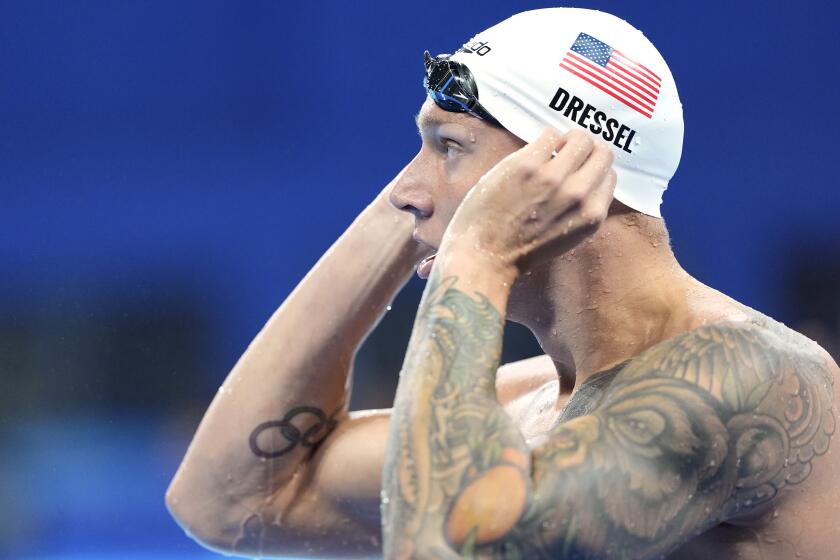
2024 Paris Olympics
Caeleb Dressel says he hopes to compete at the 2028 L.A. Olympics
Aug. 24, 2024

Watch Australian breakdancer Raygun bust her moves in the dark at this California mountain town
Aug. 23, 2024

Stephen Nedoroscik, pommel-horse hero of the Paris Olympics, gets a new stage: ‘DWTS’
Aug. 22, 2024

This flag football quarterback says he’s ‘better than Patrick Mahomes,’ best fit for L.A. Olympics

COMMENTS
The journey story, where the hero must venture out into the world for reasons not necessarily entirely of his/her own devising, is likely as old as recorded literature. Of course the journey story can also be understood as an allegory of the self, or soul, and its evolution in a lifetime, for storytelling is always an act, as Ann Carson says ...
Edited by Dario Villirilli. The Hero's Journey is a timeless story structure which follows a protagonist on an unforeseen quest, where they face challenges, gain insights, and return home transformed. From Theseus and the Minotaur to The Lion King, so many narratives follow this pattern that it's become ingrained into our cultural DNA.
The protagonists in these short stories by Asako Serizawa, Nanjil Nadan, Goli Taraghi, Stephen King, and John Cheever are unsettled, vulnerable, and unmoored during their journeys. By. Jenny Bhatt ...
The Hero's Journey is a common story structure for modeling both plot points and character development. A protagonist embarks on an adventure into the unknown. They learn lessons, overcome adversity, defeat evil, and return home transformed. Joseph Campbell, a scholar of literature, popularized the monomyth in his influential work The Hero ...
Step 7: Approach to the Inmost Cave. Eventually the Hero must arrive at the destination, and that destination is frequently a fortress, cave, or dungeon crawling with monsters, enemies, or traps. This will lead to the story's climax, but the best heroic journeys include a step before the big fight.
The stories above offer diverse examples of the Hero's Journey, showcasing different characters, settings, and themes. As a result, your students can explore variations of this classic narrative structure, laying the groundwork for engaging discussions, a cumulative compare and contrast activity, or analytical essay.
Here Are The Best Books That Follow the Hero's Journey 1. The Hobbit by JRR Tolkien The Hobbit by J.R.R. Tolkien has featured regularly on best-seller lists since its first publication in 1937.. The Hobbit by J.R.R. Tolkien has featured regularly on best-seller lists since its first publication in 1937 and is widely cited as one of the twentieth century's most beloved and influential novels.
Best Fictional Journey Take a trip across a world, a land, a universe. These stories go places. ... Pieces of Eight: A Story of Sex & Love, Trust & Betrayal by. Michael Richard Reed McLaughlin (Goodreads Author) 3.52 avg rating — 27 ratings. score: 100, and 1 person voted
The Hero's Journey can be used to write stories, troubleshoot stories, or analyze and study stories. It also provides us with language for discussing common elements in stories, like the Herald, the Mentor, or the Call to Adventure. I'll provide a brief overview of the Hero's Journey, but you'll only get a fraction of what it's all ...
Where Le Morte d'Arthur takes a serious look at the expectations of heroism and the need for true chivalry, another medieval Arthurian story, Sir Gawain and the Green Knight takes an altogether more light-hearted approach. It is an outlandish and playful tale and the quest in this case is an unusual one, as it is a journey towards death. Set on New Year's day, an unexpected guest, in the ...
Journey Stories, Cont'd. Passage | Kevin Jared Hosein. The narrator was drinking at a pub, The Tricky Jester. One of the regulars, Stew, told a story of when he hiked El Tucuche. He claims to have come across a house in the middle of the mountain, and to have seen a young woman there. The narrator works for the Forestry Division, and knows ...
This template is known as the "monomyth"—or, colloquially, the hero's journey. Hands up if you've heard this story before: A lonely hero who is trying to find himself. A sudden and unexpected journey, promising adventure and peril. A test of character, strength, and skill. An ultimate battle that tests the hero's resolve. A ...
Check out the ones below 🙂. 30 Days of Carrying My Wife. Ubuntu Story. Every Successful Story Has a Painful Beginning. 7 of The Best Inspirational and Beautiful Short Stories about Life with morals for 2019. These stories will uplift & inspire you to overcome failure & achieve success. Read them to elevate your mindset and confidence!
With my example, Men In Black it was difficult to fit the story neatly into the hero's journey framework. This is because aspects of the movie, like the fact that it's a buddy comedy, don't always jive with a hero's journey. Agent K has an important character arch, and so he ends up killing the villain rather than J. ...
The Writer's Journey - 25th Anniversary Edition: Mythic Structure for Writers. Michael Wise Productions. (Original work published 1998) The hero's journey isn't adapted in every story. While it does apply to many, this isn't a universal structure—not every TV show, movie, or book will fall into this, and yours doesn't have to, either.
Adventure short stories aren't exactly the same as novels — they don't get the space to tell a complete journey, from start to finish. What they do give you is a healthy dose of adrenaline by plunging you and the characters into a wild, awe-inspiring, and yet dangerous place, even for the briefest moment.
Many famous stories adhere to the Hero's Journey framework. You may begin to notice them all around you. The most popular examples include The Odyssey, Harry Potter, Lord of the Rings, Hunger Games, Star Wars: A New Hope, and many more. If you recognize and enjoy any of these stories, consider revisiting them and examining how they adhere to ...
Hero's journey. In narratology and comparative mythology, the hero's journey, also known as the monomyth, is the common template of stories that involve a hero who goes on an adventure, is victorious in a decisive crisis, and comes home changed or transformed. Earlier figures had proposed similar concepts, including psychoanalyst Otto Rank and ...
The hero's journey is a simple yet powerfully creative concept, found not just in myths and fairy tales but also novels, films, interactive video games, or anywhere stories are told. The influence of the hero's journey in popular culture is especially apparent in film, as in George Lucas' acknowledgment that Star Wars might never have ...
A slightly less detailed adaptation of The Hero's Journey, the Seven-Point Story Structure focuses specifically on the highs and lows of a narrative arc. According to author Dan Wells, who developed the Seven-Point Story Structure, writers are encouraged to start at the end, with the resolution, and work their way back to the starting point ...
Summary. Analysis. The narrator prepares for his trip into the city to meet officials about his land. He thinks of himself as "an old man going on a journey," though he notes that he is only 71, not really an old man. His family buttons up his coat for him and gives him money, making him feel more like an old man than he wants.
Embark on a profound journey of self-discovery with our course, "Legacy Stories," where you'll gain a nuanced understanding of the threads that weave through the narrative of your life.This transformative experience equips you with invaluable techniques for unearthing, crafting, and eloquently sharing the stories that define you.
2. Tony Robbins. Famous quote: "Setting goals is the first step in turning the invisible into the visible.". Tony Robbins is a world-renowned motivational speaker, coach, and the author of bestsellers such as "Awaken the Giant Within," "Unshakeable," and "Unlimited Power: The Science of Personal Achievement.".
Wilkinson hit another one over the fence four days later in a critical match against Air Force to help Army clinch the top seed in a final series to determine who would claim this year's title.
Amazing Journey: The Story of The Who is a 2007 documentary film by Murray Lerner and Paul Crowder about English rock and roll band The Who. [1] The film features new interviews with band members Roger Daltrey, John Entwistle, Kenney Jones, and Pete Townshend, as well as Sting, The Edge, Noel Gallagher, Eddie Vedder, Steve Jones and others, as well as rare photos of the four members of the ...
With Black Myth: Wukong out now, players might know the lore inspiration behind the latest action game. But knowing the secrets of Journey to the West only enhances the whole experience.
Miller's hit years overlapped a bit with Journey's, to be fair. And Journey's second-biggest album, "Frontiers," hit the streets in 1983, the year Def Leppard stormed our shores as the ...
Following along the theme of recounting the tales of storied brands that began their journey pre-Independence and are still growing strong in newer businesses of modern times, it is now turn to ...
Weddings have always been a reflection of the times. As we journey from the era of Baby Boomers to today's Gen Z, it's clear that the traditional "I do" has transformed into something much more ...
A group of 24 British athletes embarked on the underwater journey through the 30-mile-long tunnel. Midway through, they handed over the flame to 24 French athletes, who brought it ashore in Calais.